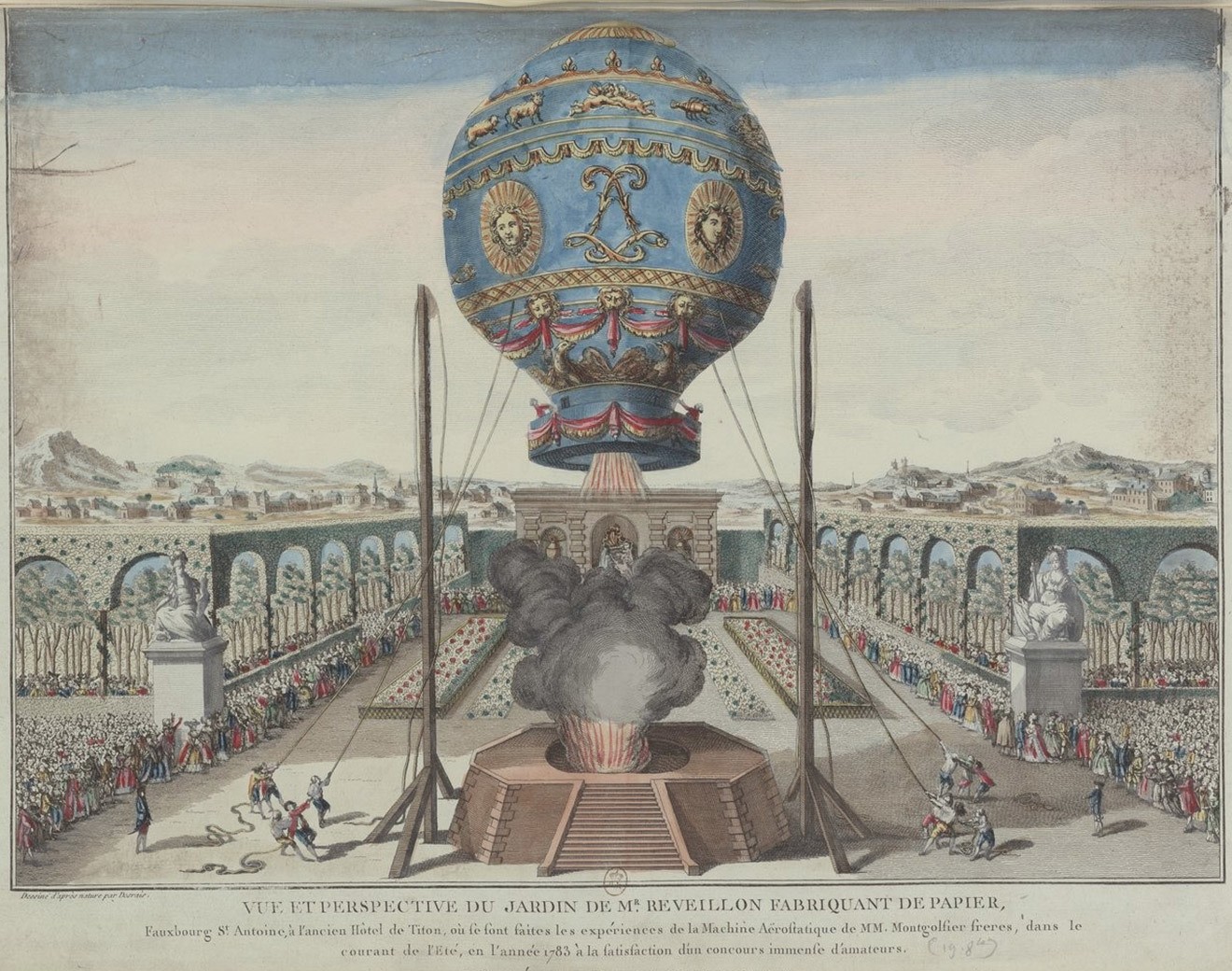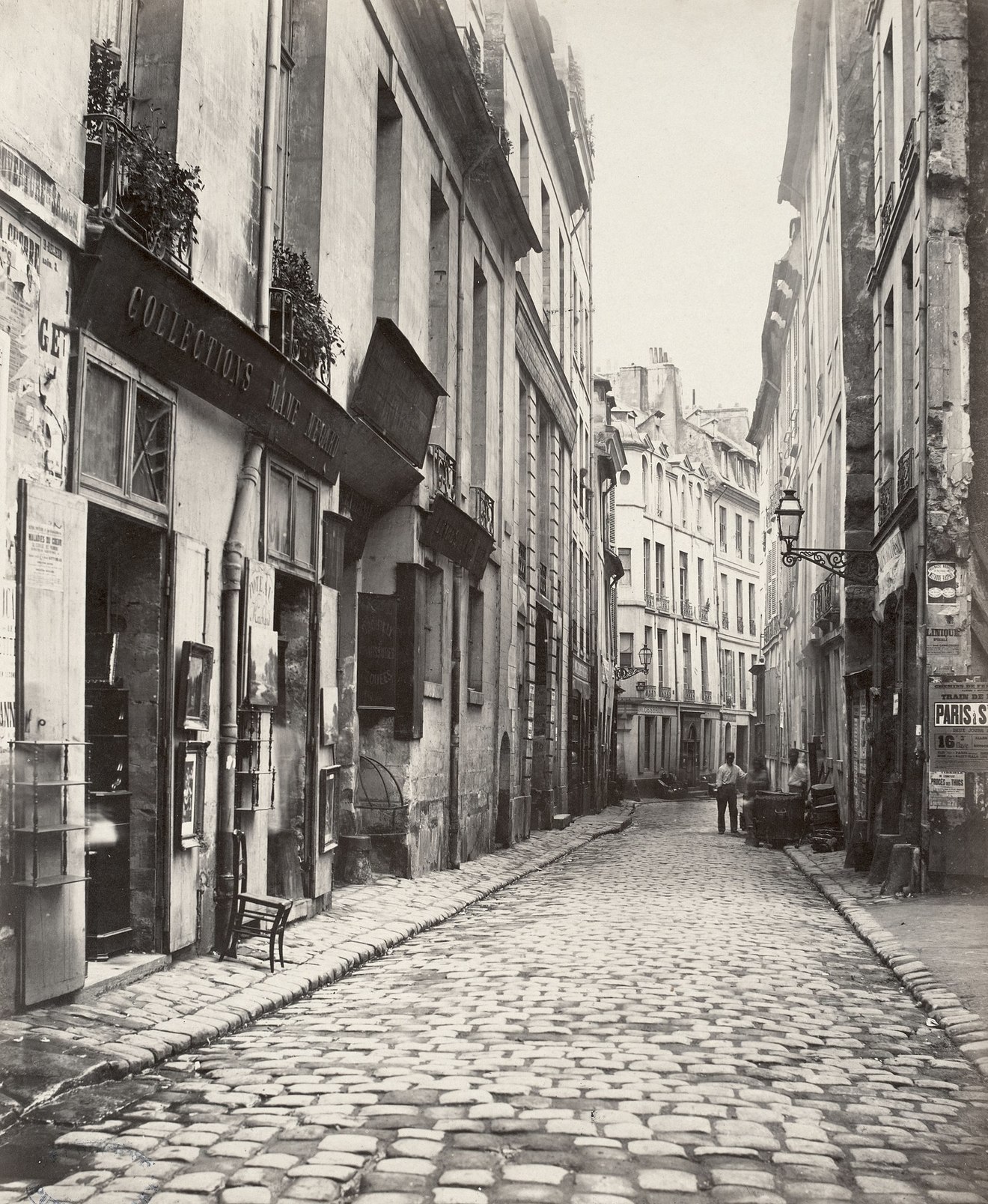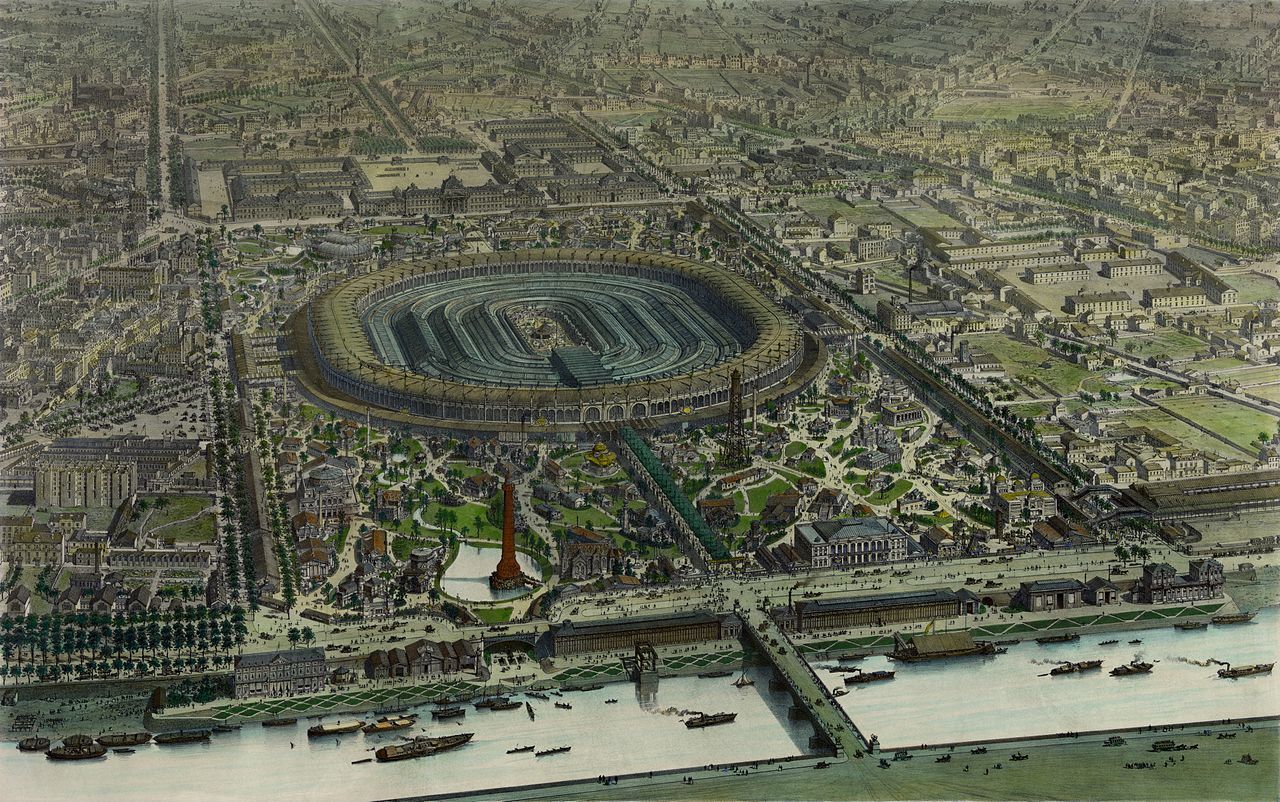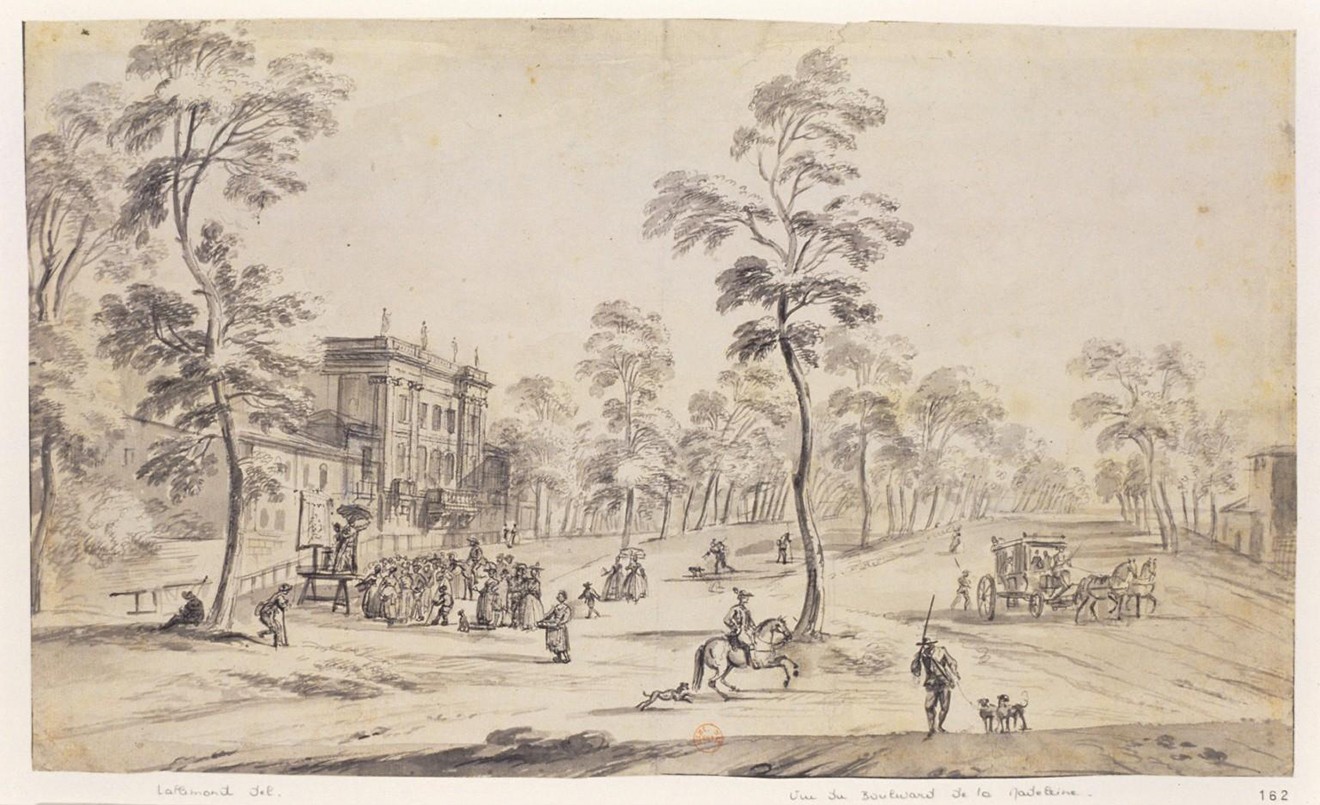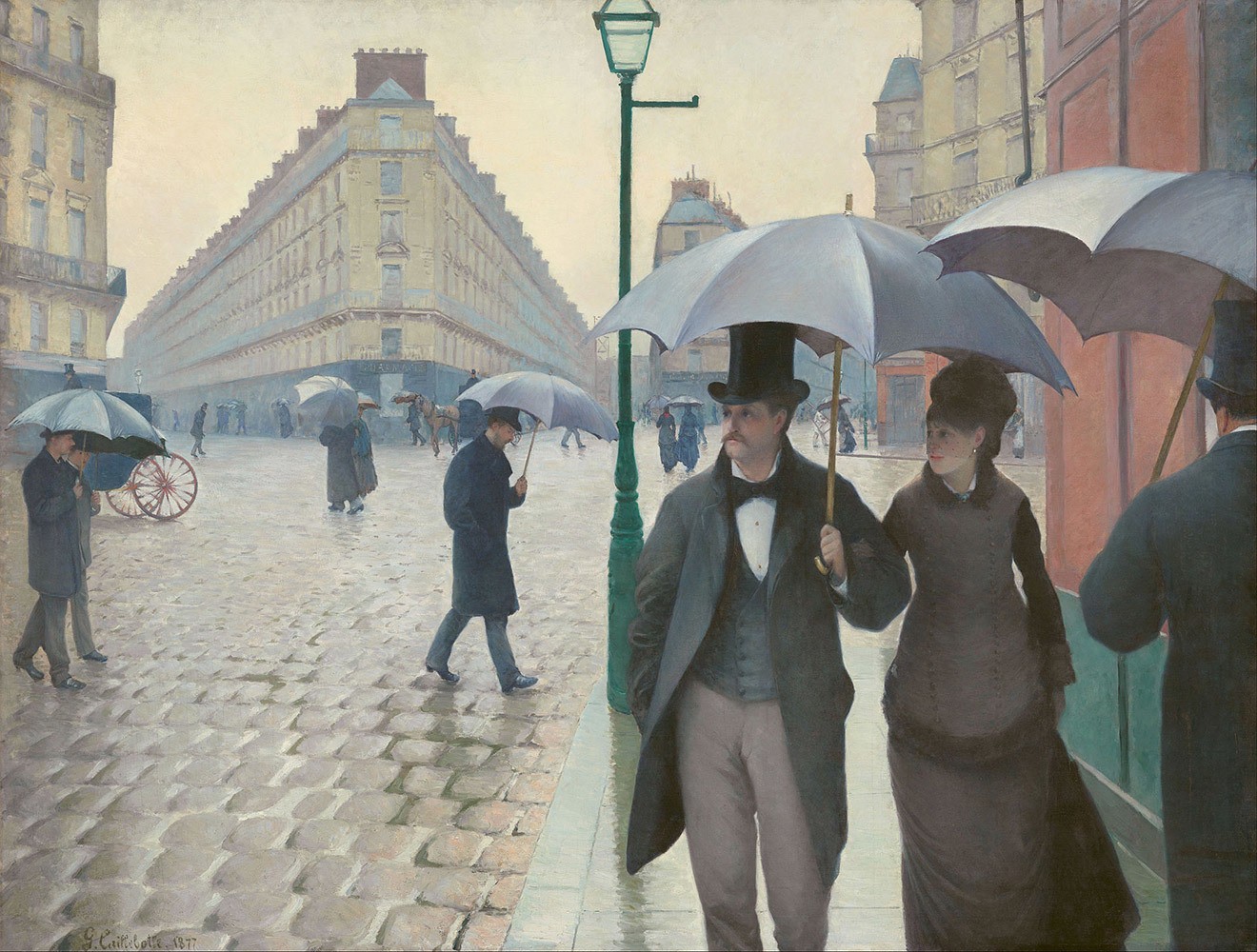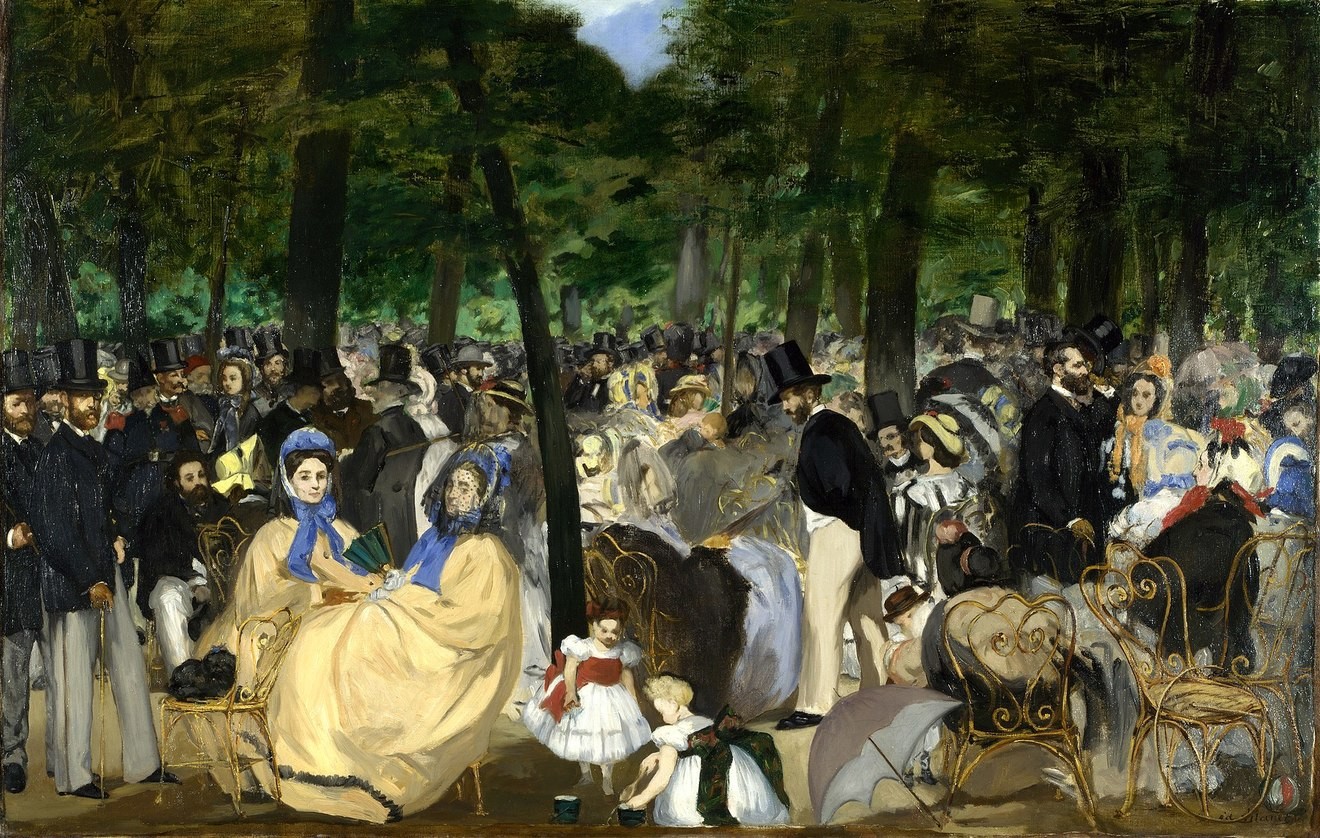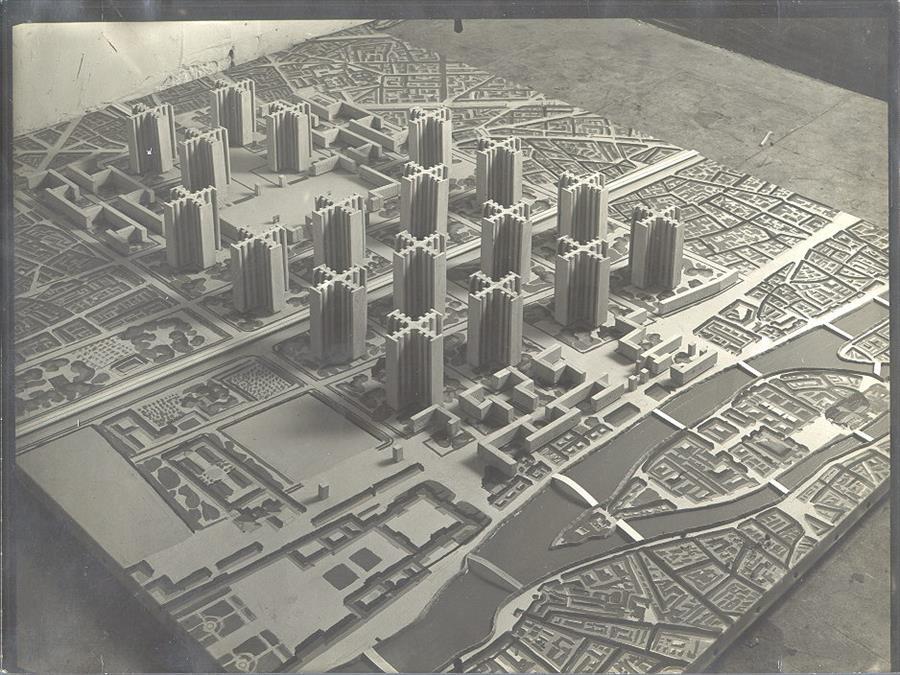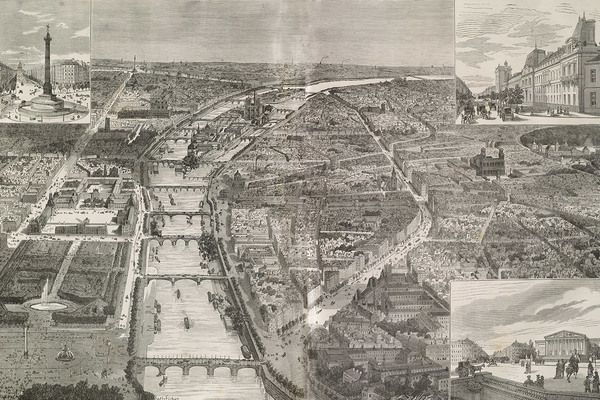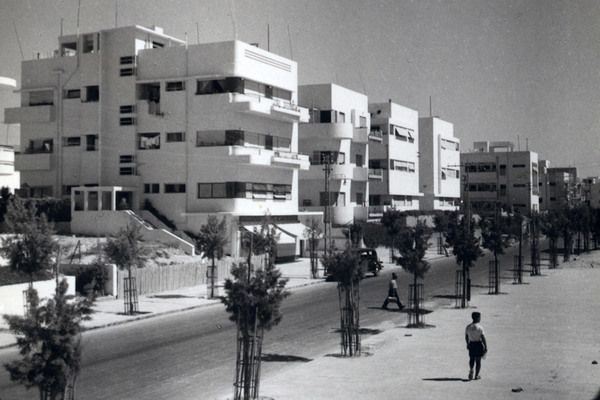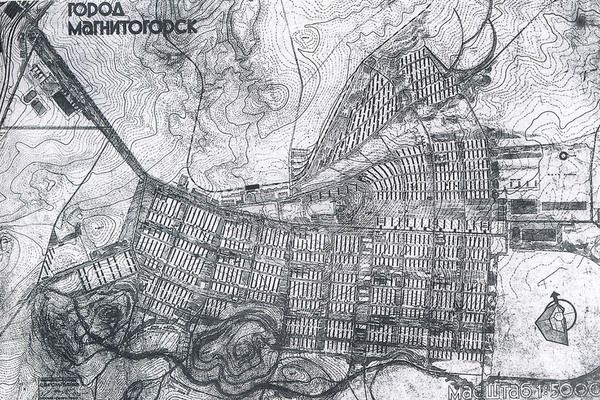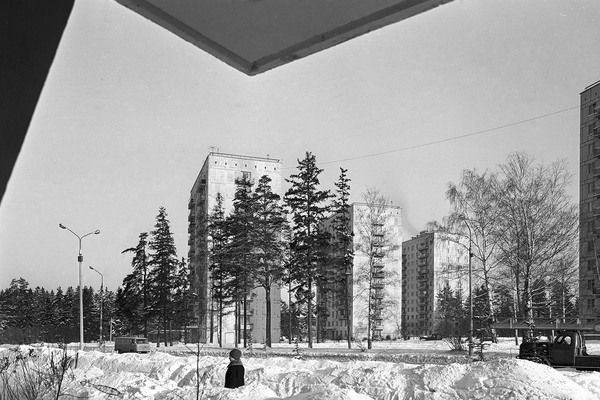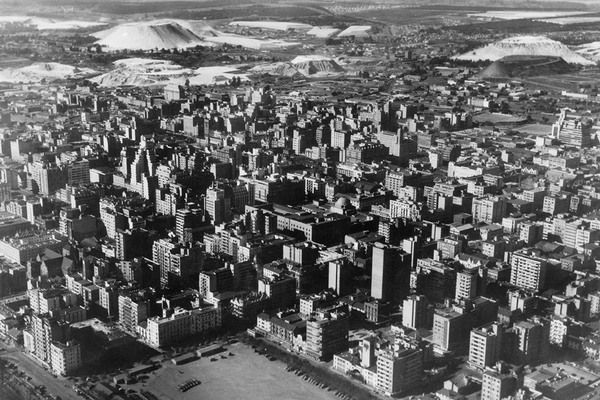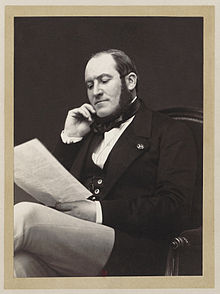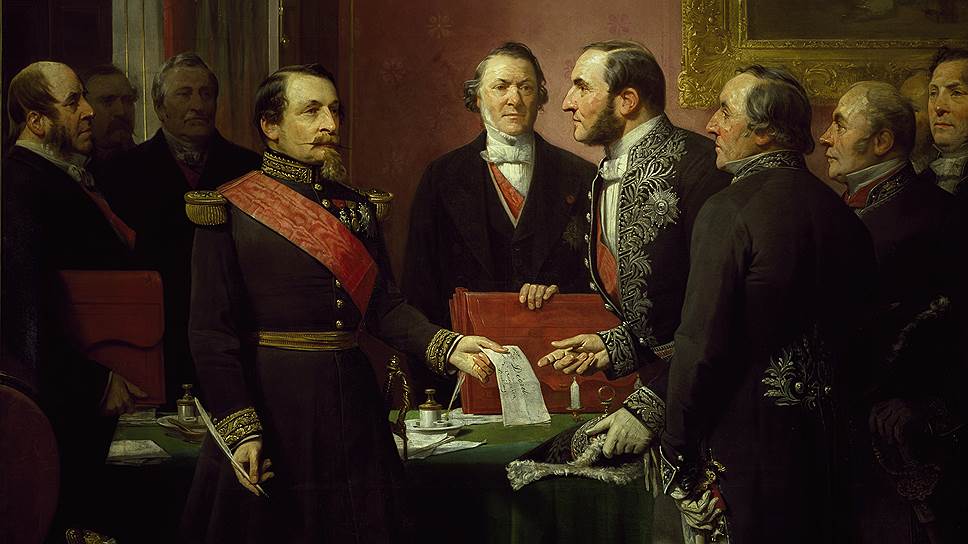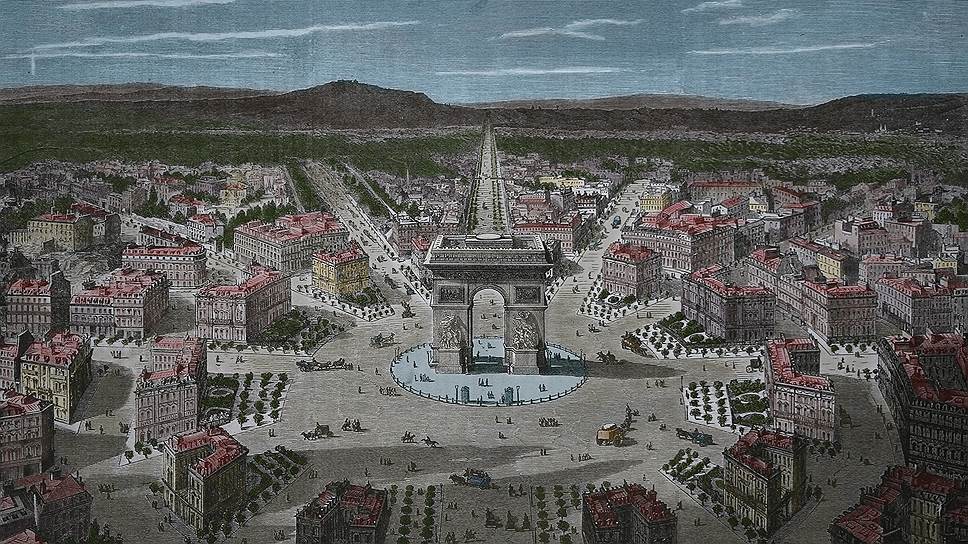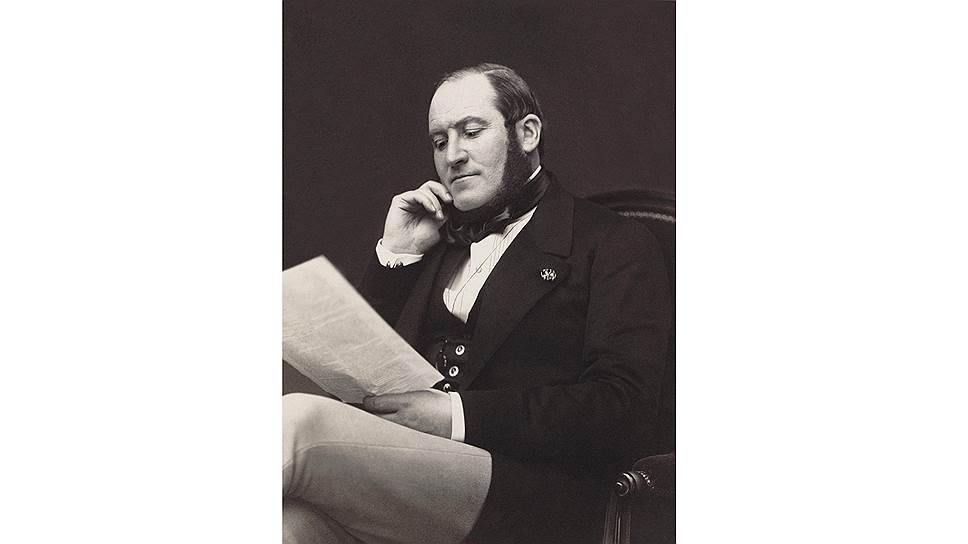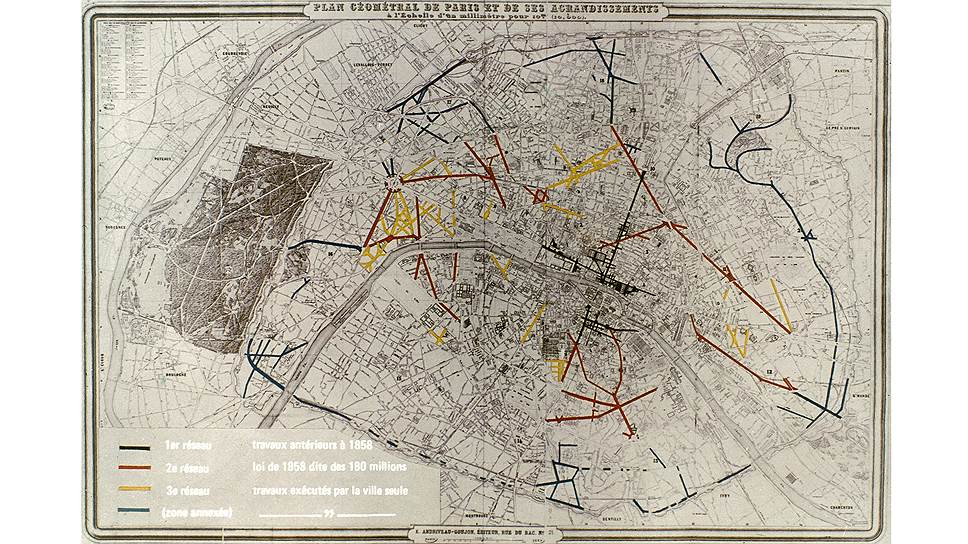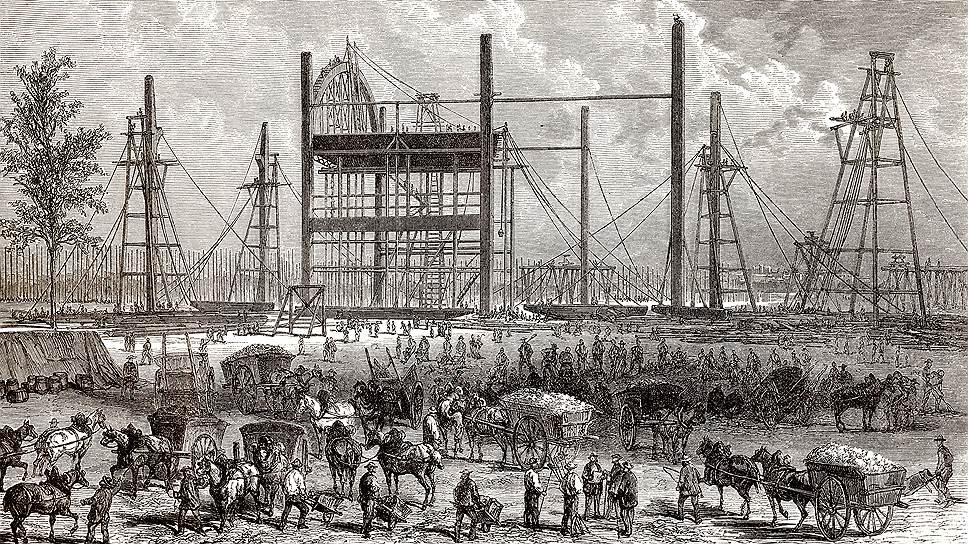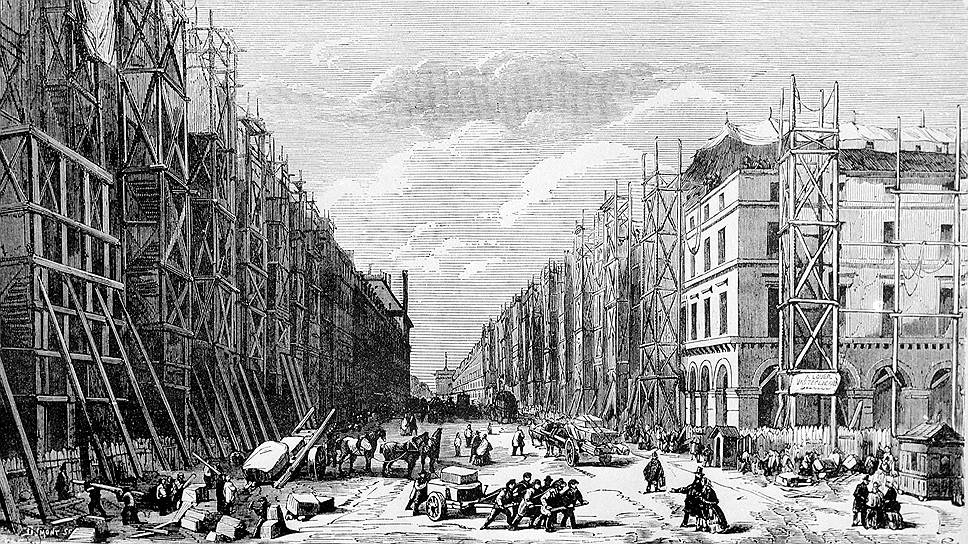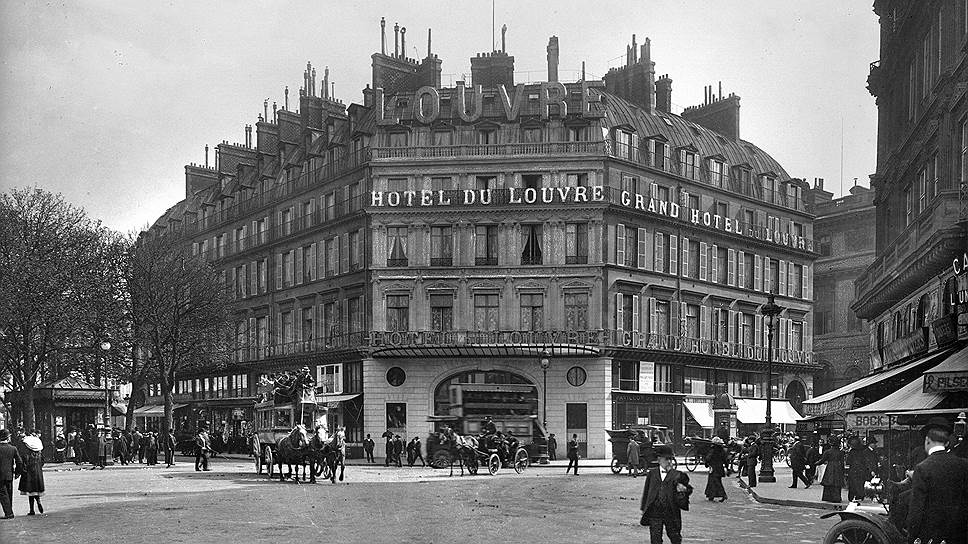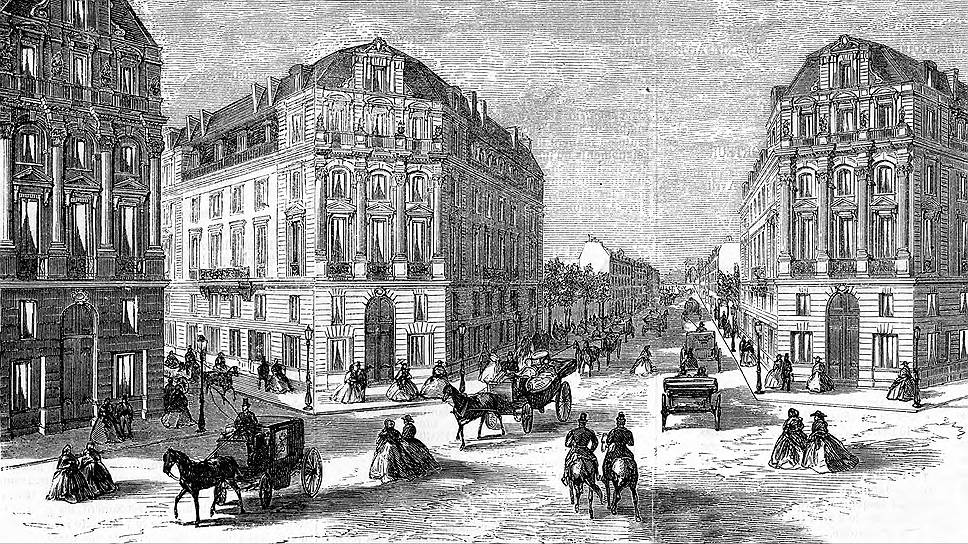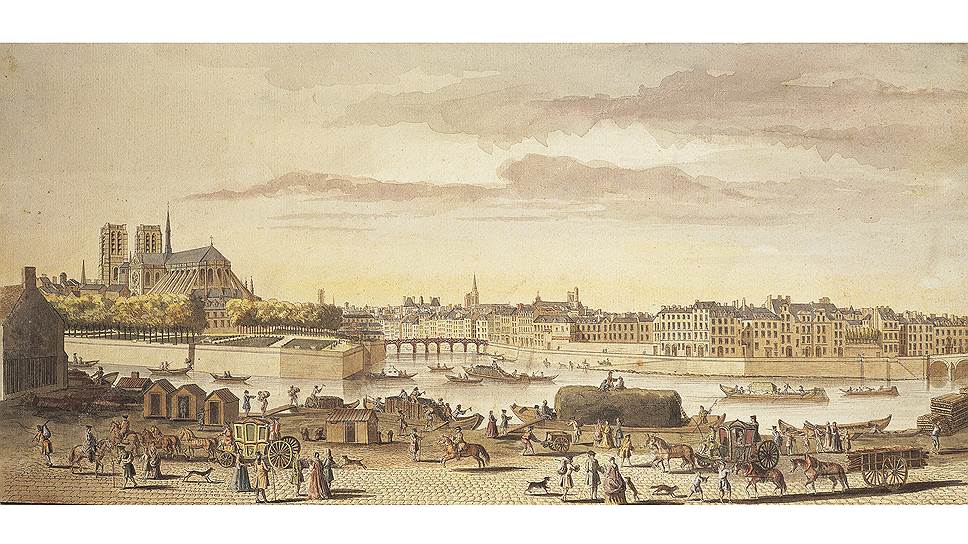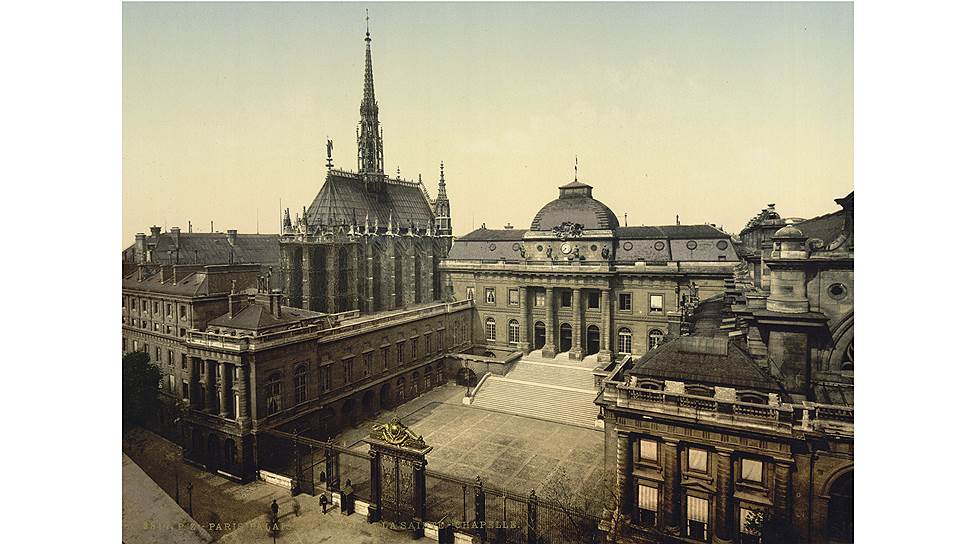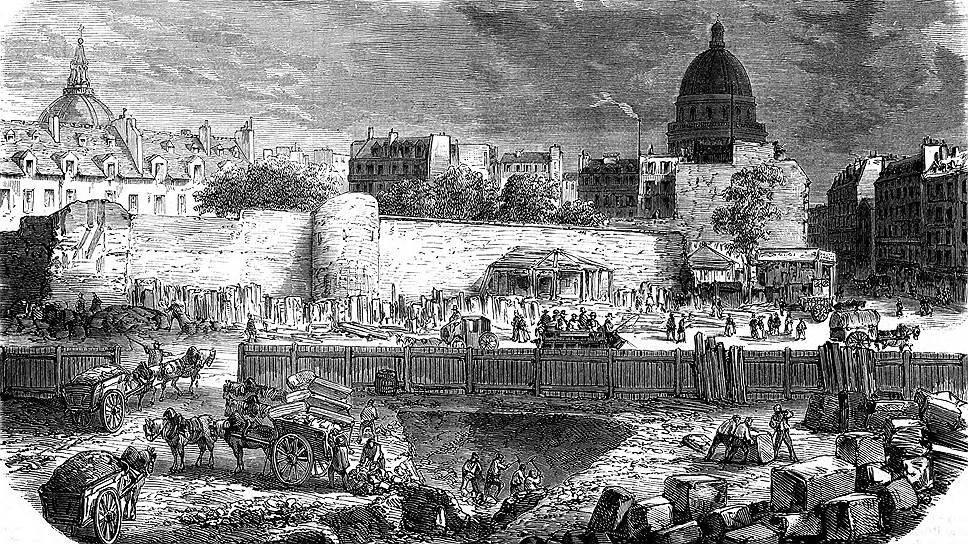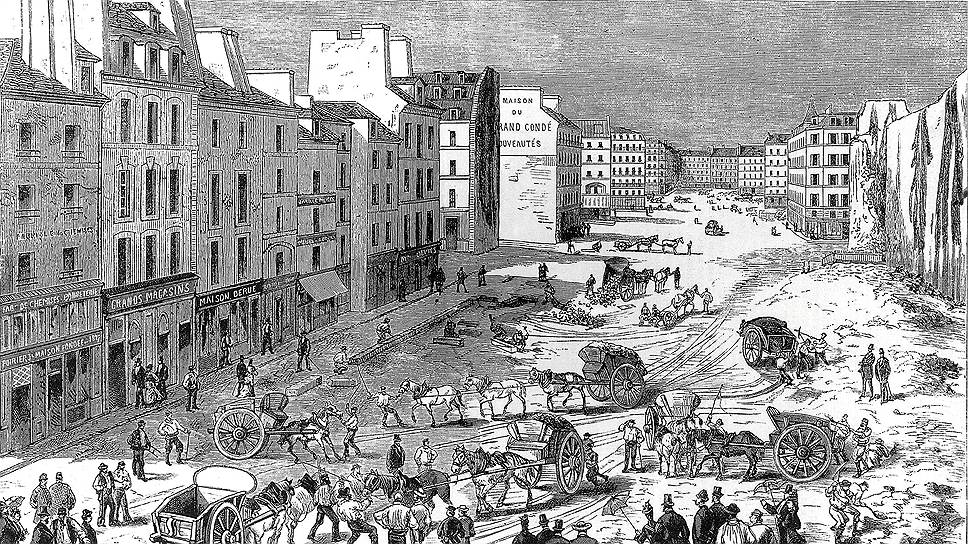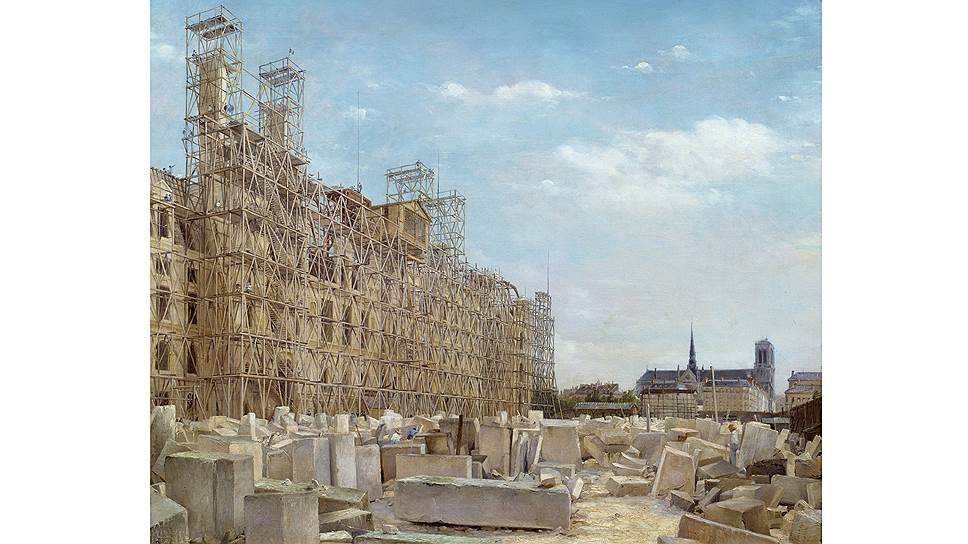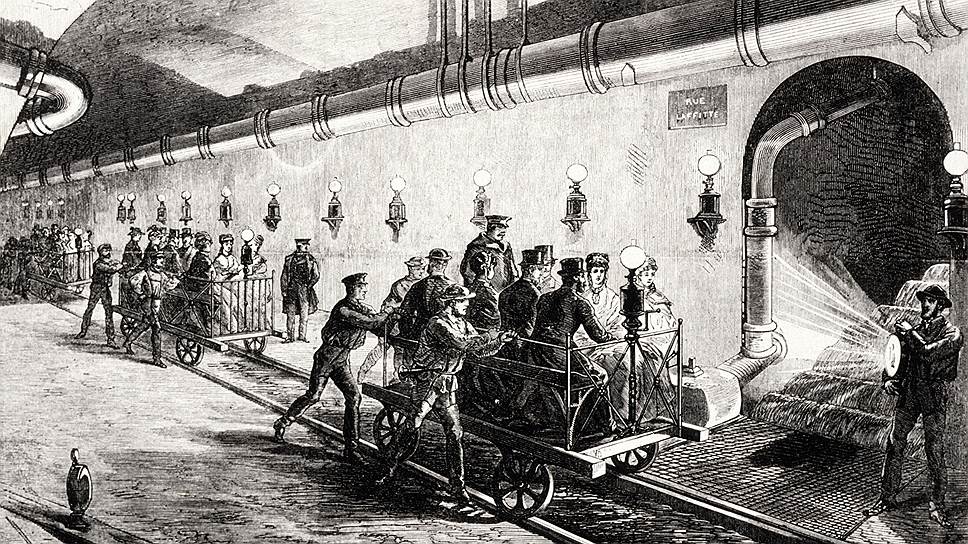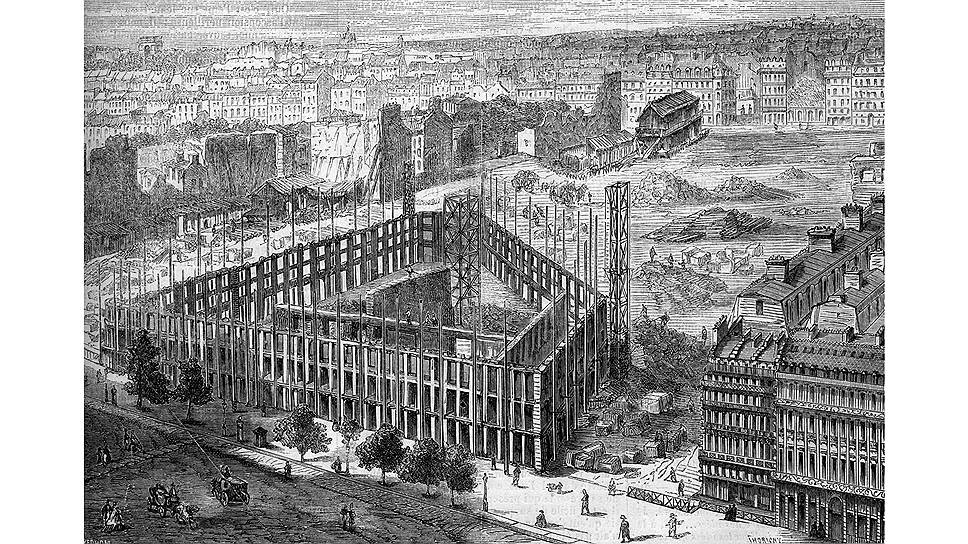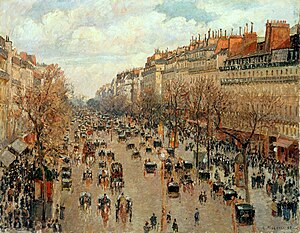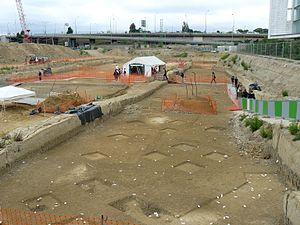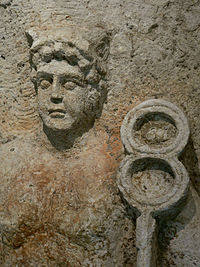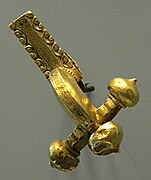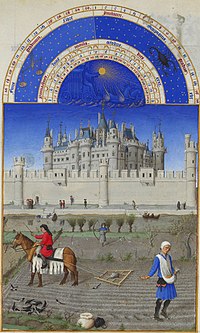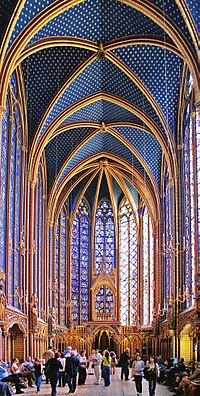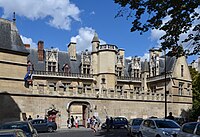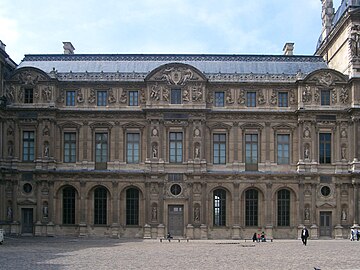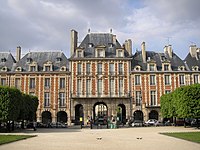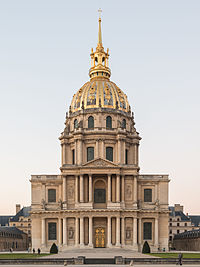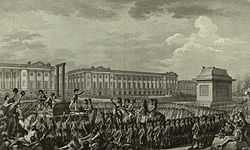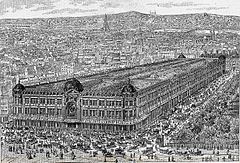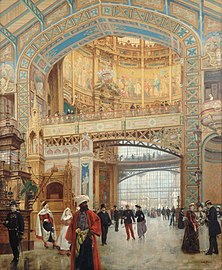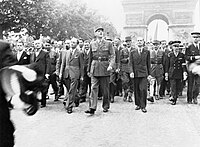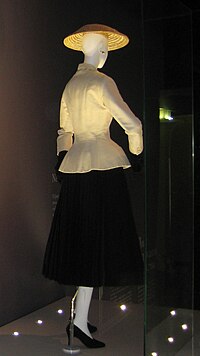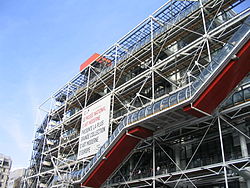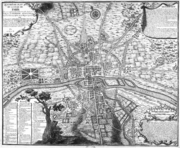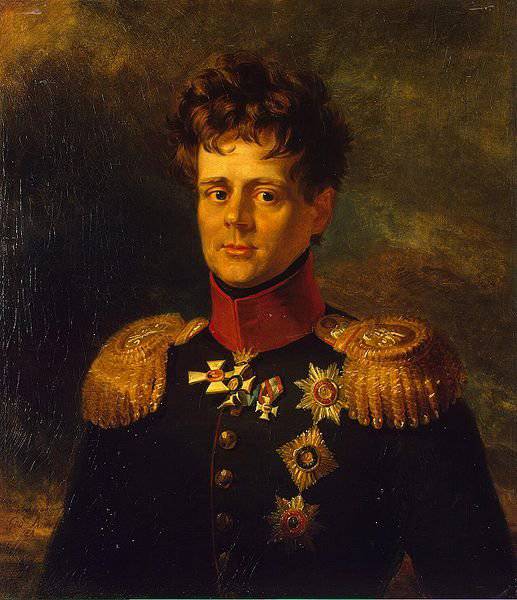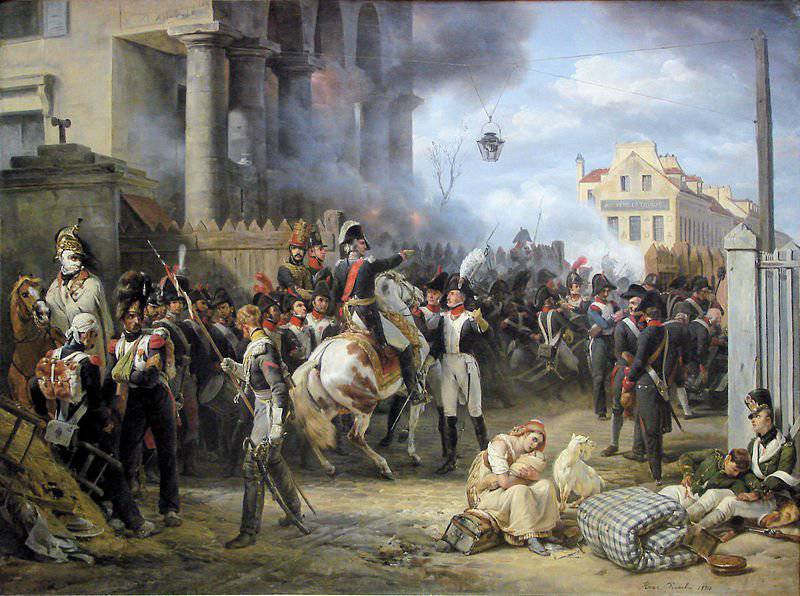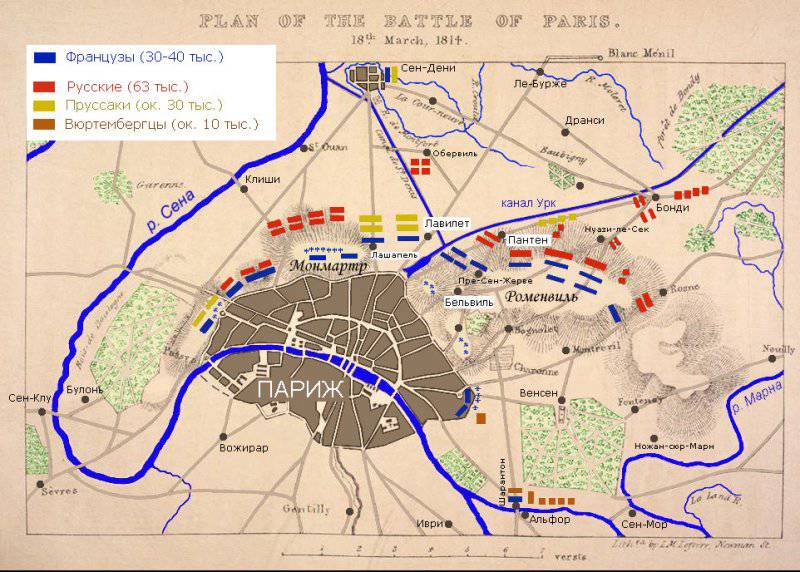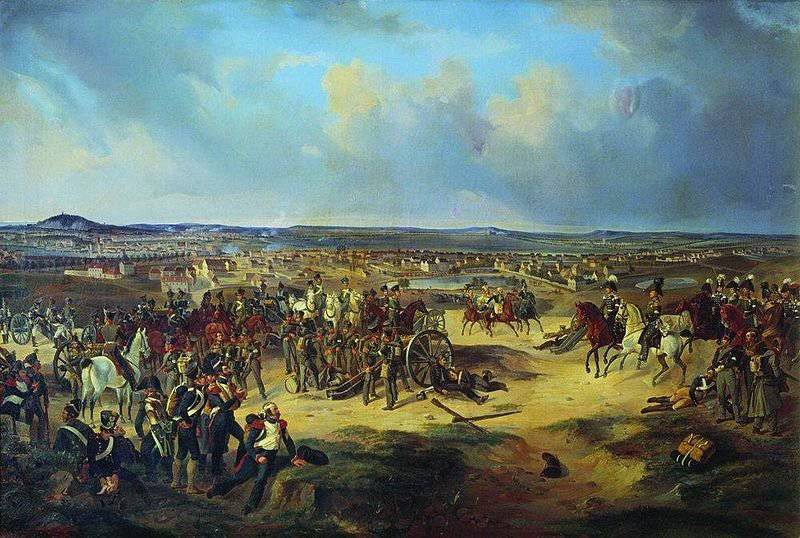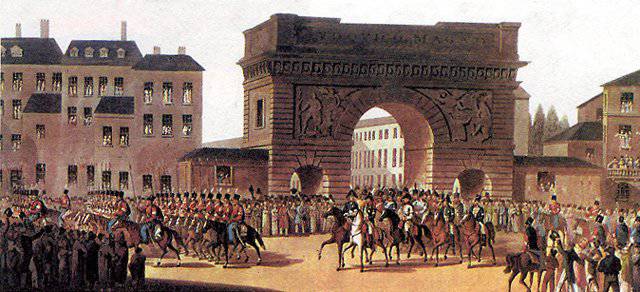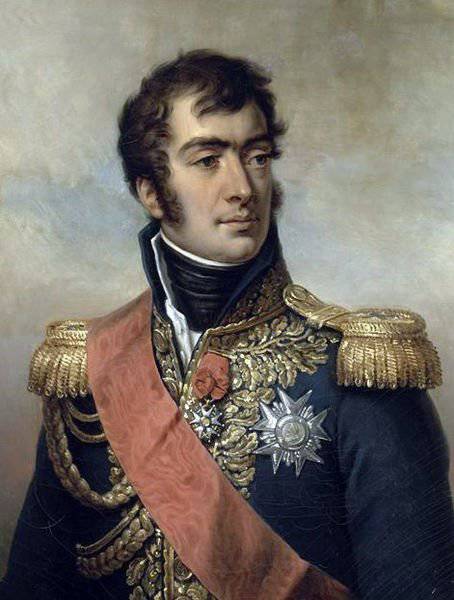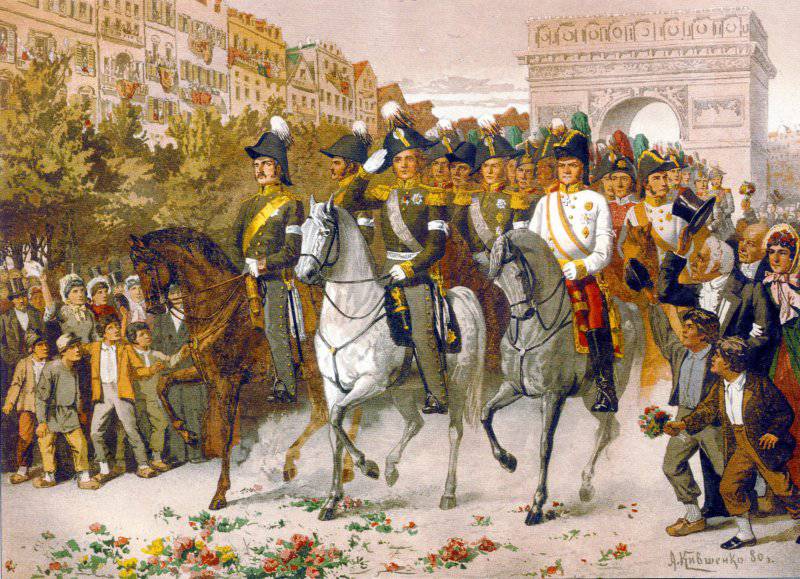Осман получает указ Наполеона III о расширении и перестройке Парижа –Художник Adolphe Yvon, 1865.
Османизация
В середине 19-го века, когда к власти пришёл Луи-Наполеон Бонапарт (будущий Наполеон III), столица Франции представляла собой самый большой в мире средневековый город. Город перенаселенный с совершенно неподходящими для жизни домами, которые кишели блохами и крысами. Мало того, что такой город был некрасив, неуютен и вонюч, он ещё был опасен. Рассадник самых разных эпидемий в центре Европы! Увидеть Париж и умереть – эта поговорка подразумевала не виртуальную смерть от восторга, а вполне реальную, например, от выпитой воды и последующей дизентерии. В Сену сливали всякую дрянь, и из неё же пили. В 1832 году в Париже разразилась эпидемия холеры, из-за которой умерло около 20 тысяч человек.
Наполеон III назначил в Париж нового префекта, барона Жоржа-Эжена Османа (Georges Eugène Haussmann; 1809 — 1891) и поручил ему преобразить Париж, чтобы буквально подарить городу глоток свежего воздуха.
Фамилия Османа не имеет никакого отношения к Османской империи. Для того, чтобы понять это, достаточно взглянуть, как эта фамилия пишется по-французски и прочесть её на немецкий манер: Хауссман. Да, человек, перестроивший Париж происходил из семьи немецких протестантов, уже давно поселившихся во Франции и в ходе предыдущих наполеоновских войн, ставших вполне себе французами.
Барон Осман справился с порученной ему императором задачей преобразования Парижа. Это грандиозное мероприятие, названное в его честь «османизацией», происходило с 1853 по 1870 год. 18 лет! Целое поколение парижан жило на разрытых улицах, среди грязи и пыли.
Но столица Франции получилась на славу! Любой гость Парижа, гуляя по широким бульварам, одобрит действия барона Османа. Роскошный город!
А можно никуда не ходить. Просто стать рядом с собором Парижской богоматери в самом центре города на острове Ситэ и оглянуться вокруг. Правда, красиво? А теперь представьте себе, что всего-то в 1840-х годах здесь, в самом центре города был квартал трущоб и лабиринт узких грязных улочек. Трудно поверить? Ведь под руководством Османа Париж был капитально обновлён: около 60 % недвижимости было построено заново.
Последствиями османизации можно наслаждаться и иным образом, дыша свежим воздухом и не сталкиваясь с тем количеством грязи и отходов, которые были убраны под землю, в Парижскую канализацию, созданную как раз по планам превращения французской столицы в настоящую столицу 19-го века.
Другой Париж
Парижский дом до османизации
На пике промышленной революции Париж был приблизительно равен Лондону по численности населения. В 1846 году его население составило 1 миллион человек. В Париж тянулись не только крестьяне из близлежащих деревень, в притяжение большого города попали также и более дальние провинции. Селились новые обитатели города в тесных домах, сохранившимися еще со средних веков.
Таким образом, по качеству жизни Париж очень сильно отставал от Лондона. Наполеон III, в отличие от своего дяди, Наполеона I, располагал возможностью реализовать имперские амбиции и воплотить их в обновлённом Париже. Денег на преобразование столицы в современный город не жалели. Заслуга Османа в том, что эти огромные деньги были потрачены с толком. В основу работ по изменению Парижа были положены три требования: современность, гигиена и спокойствие.
Современный город
Сущность преобразования Парижа в новый современный город состояла в том, чтобы получить возможность управления всеми потоками города-миллионника: ресурсами, людьми, свежим воздухом, энергией, водой, отходами и прочим. Современная техника давала для этого средства. Улицы и городские дороги стали своеобразными артериями, позволяющими беспрепятственно перемещаться людям и товарам.
Строительная техника и рациональное планирование позволили проредить грязные центральные кварталы, по узким улочкам которых пробирались ещё мушкетёры. Сквозь существующие кварталы были проложены широкие проспекты. Вместо запутанных узеньких улиц и переулков возникла сеть широких, прямых и светлых проспектов, а также бульваров. Вдоль бульваров построили высокие и красивые дома. Ширина бульваров доходила до 30 метров, и тогдашним парижанам они казались безбрежными. Широкие бульвары также были проложены от центра к новым городским железнодорожным вокзалам. В ходе османизации Париж приобрёл 12 вокзалов. Более того, железнодорожный транспорт стал городским: поезда забрались на эстакады и рванули от вокзала к вокзалу прямо через центр города.
Здоровый город
Одновременно с Лондоном в Париже началась дезинфекция питьевой воды, и эти города перестали опасаться эпидемий холеры. Мелкие речки или ручьи, превратившиеся в свалки промышленных отходов (например, ручей Бьевр в квартале красильщиков и производителей гобеленов) были загнаны под землю и включены в Парижскую канализацию. Усилиями мэрии улицы планомерно засаживали деревьями, разбивали клумбы и газоны. Париж становился зелёным городом.
Безопасный город
Париж до и после османизации. Левый берег. Улица Суфло.
В продолжение всей французской истории Париж был городом бунтовщиков. Недаром короли, как только им представилась возможность, перебрались в пригородную деревушку Версаль. Новый Париж после десятилетий политической нестабильности должен был стать символом мира и процветания. Чтобы поддерживать порядок полицейские и солдаты должны были быть мобильными, быстро разворачиваться и иметь возможность сносить любые баррикады. Которыми, по чести сказать, широкие улицы нового города перегородить было невозможно. Ну, и воришка или хулиган на широких улицах не имел возможности скрыться от полицейской погони
Рекогносцировка
В это трудно поверить, но в середине 19-го века в парижской мэрии напрочь отсутствовала информация о городе. Когда Осман вступил в должность, у него не было точной карты. Данные о рельефе города, его морфологии и прочее попросту отсутствовали. Результаты давали о себе знать. Например, сам Наполеон III однажды заказал производство работ на улице Риволи, однако эти работы в реальности были не нужны, их уже сделали.
Барон Осман первым делом создал команды сотрудников, которые занимались картографией Парижа. В результате он получил несколько очень подробных карт города, а также топографические карты, законченные чуть позже, в 1853 году. Одновременно было обследовано состояние всех парижских зданий, и составлены поквартальные планы. Теперь всё было готово к началу боевых действий.
Бульвар Монмартр. Камиль Писарро. 1897
Стратегия и тактика
Самый старый средневековый город Осман решил превратить в современную столицу могучей империи в три этапа.
- Снос кварталов трущоб вокруг собора Нотр-Дам общей площадью около 9 гектаров. Одновременно началось строительство двух главных осей будущего Парижа: с севера на юг и с запада на восток. Средняя ширина этих дорог была 18 метров, а общая длина — более 100 километров.
- Устройство бульваров и на их пересечении площадей с круговым движением. В южной части города, на Елисейских полях завершение площади Звезды с Триумфальной аркой, к которой сходились 12 проспектов.
- Строительство новых кварталов. При этом вместе с домами строили городскую инфраструктуру: новую водопроводную систему, а также канализационные коллекторы.
Новые улицы имели как бы два этажа. Сначала строители прокладывали водопровод и канализацию, подключая к ним каждый будущий дом. Затем сверху коммуникации накрывали каменной мостовой. Улицы могли быть широченными и длинными, как бульвар, названный затем именем Османа. Такие прямые улицы предназначались для больших транспортных потоков. В те времена, когда производились работы по прокладке магистралей весь транспорт был гужевой, и об автомобилях никто, конечно, не думал. Но автомобили, появившись, без труда захватили новый Париж с широкими проспектами и большими перекрёстками. Были среди новых магистралей и улицы, не предназначенные для интенсивного движения, как уютный бульвар Сен-Жермен. Просторные магистрали соединили все городские вокзалы.
Жан Беро. Бульвар капуцинок.
Высокие здания структурировали городское пространство по вертикали. По плану Османа высота зданий, возводимых вдоль улиц коррелировали с шириной улиц. На нешироких улицах и дома строили пониже. Это делало улицы светлыми и просторными, гармонично приспособленными для человека.
Дома на новых улицах тоже были новые. Их вид был стандартно однообразен, фактически все они делались по одному проекту и предназначались для комфортабельной жизни. Вода, газ и туалеты были во всех квартирах на всех этажах. В основном дома строили пятиэтажные, но без лифтов, которые тогда казались ещё роскошью. Облицованные камнем фасады казались однотипными и единообразными. На первых этажах – магазины и входные подъезды, охраняемые консьержами. Консьержи и торговцы селились на вторых этажахю. Выше следовали этажи с хорошими и дорогими квартирами, в каждой из которых были балконы широкие и балконы узкие. В чердачных этажах под крышей были помещения для прислуги или для не слишком богатых людей.
Стоимость
Любой масштабный проект всегда превышает заявленную первоначально стоимость. Император не скупился и одобрял дополнительное финансирование. Но окончательно Париж расплатился за османизацию только в 1909 году.
Расширение Парижа при Османе
Барон Осман проницательно предполагал, что инвестиции в грандиозное строительство столицы компенсируются выгодами, которые выявятся после преобразования города и благодаря этому преобразованию. Среди частных предпринимателей оказалось довольно много желающих вложить деньги в строительство новых зданий, чтобы получить выгоду, сдавая в них площади под жильё и магазины, когда они будут построены.
Однако, многие парижане были недовольны либо длительным строительством, либо его всё время повышающейся стоимостью. Поэтому увольнение Османа с должности было встречено злорадством.
Результаты
Однако, сейчас оценка деятельности Жоржа-Эжена Османа в целом положительная. Османизация Парижа, в самом деле, превратила грязный и опасный для жизни средневековый город Париж в роскошный и весёлый город, манящий и влекущий к себе всех и всегда.
В ходе османизации были опробованы промышленные методы реновации старых городов. О канализационной системе французской столицы уже говорилось. А кроме того, город был капитально озеленён, включая возведение четырёх парков на периферии. На улицах появились газовые фонари, питьевые фонтанчики, которые называются фонтанчиками Уоллеса (по имени известного английского коллекционера), тумбы для расклейки афиш, которые называются тумбами Мориса (по имени владельца типографии, впервые освоившего такие места для рекламы). В рамках османизации в 1854 году было возведено эффектное новое здание продуктового рынка из металла и стекла (les halles). С лёгкой руки Эмиля Золя этот рынок был прозван «чревом Парижа»
 |
| Панорама Парижа, Вид с Эйфелевой башни |
Париж (фр. Paris, в древности Лютеция), столица Франции, важнейший экономический и культурный центр страны и мира. Расположен на севере центральной части Франции, в регионе Иль-де-Франс, на берегах реки Сена.
- На карте: Яндекс.Карта, Google-карта
История
Образование города, власть римлян
Кельтское племя Паризии обосновалось на острове Ситэ, известному также как
Lucoticia около III в. до н.э., образовав маленькое рыбацкое поселение.
Его росту способствовали плодородная почва и карьеры для добычи камня.
Город получил название Лютеция.
В 52 году н. э. Лютеция была захвачен римлянами, которые назвали его «Город Паризиев» (лат. Civitas Parisiorum). На руинах старого города возникло два: город галлов, реконструированный на острове Ситэ по моделям римских городов (здесь располагалось римское правление), и новый город на левом берегу.
Стараниями святого Дионисия, первого
епископа Парижского, и его спутников, священника Элевтерия и диакона Рустика, в Париже было проповедано Слово Божие. Во время римского правления в течение трёх веков город процветал экономически, население достигло 8 тысяч жителей.
Нашествие варваров
С середины III века территория Лютеции подвергается атакам варваров.
Это привело к дальнейшему укреплению острова. В то же время город стал называться «Париж».
В V веке гунны под предводительством Атиллы гунны побеждают галлов, однако оставляют нетронутыми окрестности Парижа. По преданию, город оказался спасён благодаря молитвам святой Женевьевы, которая почитается покровительницей
Парижа. Город становится центром независимого галло-романского государства.
Правление франков. Потеря и восстановление значимости города
В 486 году Париж без боя принимает власть франков под руководством Хлодвига. Он же сделал из города столицу государства.
В правление династии Каролингов город потерял прежнее значение, так как Карл I Великий
(Шарлемань) перенёс столицу на север, в город Экс-ля-Шапель (Aix-la-Chapelle), называемый ныне Аахен. Жители покинули левый берег, где остались лишь религиозные учреждения.
В IX веке парижский регион был опустошён норманнами и долгое время, начиная с 885 года, город
постоянно подвергался их нападениям и осадам.
В 987 году к власти приходит династия Капетингов, которые восстанавливают величие города. Город становится столицей маленького королевства, которое постепенно растёт.
В правление короля Филиппа II Августа в Париже строится крепость Лувр (1204). Левый
берег снова постепенно заселяется и развивается: появляются учебные заведения (Парижский Университет, Сорбонна). К этому же времени относится строительство Собора Парижской Богоматери. Город возрождается как экономический центр.
Париж в Средние века
С XIV века для Парижа начинаются тяжёлые времена. Город сильно пострадал от голода (1315—1317), чумы (1348—1349) и от Столетней войны с англичанами.
При короле Карле V Мудром (1364—1380) строится крепость Бастилия.
В 1420 г. Париж захвачен англичанами, власть которых сохранялась до 1436 года.
Величие город вновь обретает лишь во второй половине XV века.
Население
Население Парижа многонационально — помимо потомков франков и галлов на улицах города и
особенно в его предместьях можно встретить большое количество арабов (преимущественно,
алжирцев, тунизийцев и марроканцев), выходцев из бывших африканских колоний и Антилльских
островов, китайцев (в районе площади Италии) и вьетнамцев. В самом Париже насчитывают
2 871 000 жителей.
Достопримечательности
Своей красотой, изысканным стилем и роскошью Париж вдохновлял и вдохновляет артистов
и мыслителей. За это его иногда называют «Городом света». Символом Парижа является
Эйфелева башня, видная из многих уголков юго-западной части города.
Другим символом Парижа стала Триумфальная арка соединённая с Площадью Согласия
знаменитой улицей Елисейские Поля. К Площади Согласия с восточной стороны по оси
Елисейских Полей примыкает сад Тюильри, разбитый в французском («регулярном») стиле,
и далее в этом же направлении, знаменитый Лувр — многовековая резиденция французской
королевской семьи, а ныне один из самых богатых мировых музеев живописи и скульптуры.
В историческом центре города находятся две самых знаменитых церкви Франции: Собор Парижской Богоматери (Нотр-Дам-де-Пари) на острове Ситэ, в котором пребывает Терновый Венец Господа и Бога нашего Иисуса Христа, и Сен-Шапель (Святая Часовня) возле Лувра. На холме Святой Женевьевы, где когда-то стояла келья святой, располагается
Собор Сен-Этьен-де-Мон (собор святого Стефана), в котором пребывают мощи святой покровительницы Парижа. На севере города располагается собор Сен-Дени (Saint-Denis),
где упокоиваются мощи первого епископа Парижского.
Архитектурные направления двадцатого века оставили городу такие памятники как
Культурный Центр Жоржа Помпиду, в котором сейчас расположен музей современного искусства,
а также район Ла Дефанс, представляющий собой архитектурный комплекс из небоскрёбов и
зданий и сооружений с авангардными формами.
Православие в Париже
В Париже имеется много православных церквей.
- Западноевропейская архиепископия Русских церквей:
- Александро-Невский собор
Святые, в граде Лютеция просиявшие
- Геновефа Парижская (Женевьева Парижская)
- Герман Парижский (Жермен Парижский)
- Дионисий Парижский
- Маркелл Парижский
Расшифровка Париж и реформы барона Османа
Как в середине XIX века бывший городской префект и друг Наполеона III придумал не только новый облик Парижа, но и парижанина
Основной драмой градостроительства, как современного, так и прошлых эпох, является взаимодействие между морфологией города и тем обществом, которое использует эту морфологию, сообществом, которое живет в городах. Сама по себе эта драма образовалась не сейчас, а в конце эпохи Ренессанса, когда впервые возникло представление о человеке и об обществе, отделенном от природы и от религии.
Есть такой замечательный английский исследователь европейских городов Денис Косгроув, и у него есть прекрасная книга, которая называется «Social Formation and Symbolic Landscape» — «Социальная формация и символический ландшафт». Там он рассказывает, что где-то в конце XV века у людей возникло стремление покупать ландшафтную пейзажную живопись. Желание изображать природу существовало всегда, но как индустрия пейзажная живопись возникла именно в конце XV века, причем в самых урбанизированных районах Европы, в Северной Италии (долина реки По), во Франции и Южной Англии. На вопрос, почему так произошло, Косгроув отвечает, что тогда общество впервые как бы раскрыло глаза на природу: появились земельные участки, институт собственности на землю. И в этот момент появляются общественные пространства в городах: города перестают быть только морфологическим единством зданий и улиц, в них появляются рыночные площади, торговые улицы и т. д. Все это было и раньше, но как единое целое города начали восприниматься с конца XV века.
Что касается Франции, есть замечательная легенда о том, как в Париже впервые возникло представление о парижском обществе как таковом, не об отдельных социальных классах, а именно о городском обществе. В 1783 году братья Монгольфье, которые изобрели воздушный шар, организовали демонстрацию в Версале. Это было невероятно торжественно, и, естественно, был постамент, к которому был привязан этот воздушный шар. Вокруг собралось все парижское сообщество. Там была и Мария-Антуанетта, и Людовик, послы, генералы и т. д. Все они располагались концентрическими кругами вокруг постамента: самые почетные и близкие к центру места принадлежали королевской семье, дальше шли армейские чины, замыкал все это парижский люд, который с большим интересом наблюдал за этим испытанием издалека. И вот, когда шар поднялся в воздух, подул ветер, люди были настолько ошеломлены самим зрелищем этого полета, что сорвались с мест и побежали. И когда они побежали, они все смешались в одно общество. Это очень симпатичная легенда, согласно которой примерно в это время, в конце XVIII века, в Париже возникает представление о парижанах как о людях, которым если и важны социальные сословия, то не на улице, не на площадях и не на бульварах, где они становятся единым целым.
С этого момента в Париже берут начало реформы градостроительства, и возглавляют их врачи, потому что город постоянно лихорадит: все время чума, холера, а улицы очень узкие, канализация работает плохо и т. д. Возникает стремление победить массовые эпидемии, и городские руководители и планировщики отвечают прежде всего именно этой цели Вместе с тем, гигиеническая причина — не единственная, почему в Париже XIX века было решено прокладывать широкие и прямые дороги и бульвары. Делалось это еще и для того, чтобы помешать парижанам бунтовать: на узких улочках возводить баррикады было проще, а подавлять бунты силами армии — труднее.. Они начинают смотреть по сторонам, и здесь колоссальную роль играет Лондон, потому что Лондон того времени был некой городской моделью, где уже были парки, общественные пространства, а его социальная модель была гораздо более приспособлена к городскому сообществу без социальных страт, чем модель Парижа. И конечно, парижане и городские начальники засматривались на Лондон, но главным человеком в этом смысле был племянник Наполеона, Наполеон III. Человек храбрый и решительный, иногда даже жестокий, он несколько раз бежал из тюрьмы и в итоге оказался в ссылке. В ссылке он жил в Лондоне и был влюблен в этот город. Позднее, переправляясь через Ла-Манш в надежде выиграть президентские выборы, он нес с собой идею преобразования Парижа в город, похожий на Лондон: с парками, большими бульварами и т. д. Эту идею он реализовал, назначив префектом Парижа Изначально Осман занимал должность префект адепартамента Сены. Должность префекта Парижа появилась в 1968 году, после реорганизации парижского региона. своего приятеля барона Османа и дав ему полномочия на преобразование города.
Про барона Османа известно, что это человек чрезвычайно жесткий, решительный, который перекроил Париж по совершенно новой кальке, создал бульвары, прямые линии дорог и т. д. Вообще, в истории архитектуры и градостроительства ему принадлежит место даже не реформатора, а преобразователя, социального инженера, который жесткой рукой, с помощью Наполеона III, все переделал. На самом деле все было по-другому. Сам барон Осман никогда не был архитектором, он был префектом Парижа, а до этого — префектом департамента Бордо, и его карьера развивалась именно в этом направлении. Он был мастером компромисса, мастером договора и никогда не был человеком, который каленым железом пробивал путь своим решениям. Так вот, его основное достижение состоит в том, что он понимал: город — это не улицы и не дома, а люди, городское сообщество.
Что сделал Осман? Во-первых, в 1856 году он начал договариваться с муниципалитетами вокруг Парижа об объединении, провел колоссальную политическую работу, чтобы объединить в единую городскую черту несколько муниципалитетов. Он медленно и терпеливо уговаривал муниципалитеты на объединение. Это ему не удалось ни с первой попытки, ни со второй, и через пять лет после объединения Париж напоминал такой сыр с дырками.
Второе, что сделал Осман, — воспользовался законом об экспроприации земель ради городского блага. Такой уже был принят до него, при предыдущем префекте Рамбуто: он создал институты, которыми потом воспользовался Осман. Одним из этих институтов был закон об экспроприации земель и компенсации собственникам земли и недвижимости. Это примерно то, что в Москве обсуждали в период реновации. Такой закон был принят еще в первой половине XIX века.
И вот все пять лет Осман уговаривал собственников и договаривался с ними о компенсации, потому что их земли уходили под проекты новой недвижимости и инфраструктуры: бульваров, дорог и т. д. Но Осман делал это, разумеется, не сам. Впервые в истории градостроительства был назначен общественный адвокат, который занимался тем, что согласовывал компенсации и экспроприацию у собственников земель, попадавших под новый план.
Фактически барон Осман создал прецедент наличия общественного адвоката, который сейчас присутствует как избранная персона в некоторых крупнейших городах мира. Например, в Нью-Йорке выбирают главного аудитора, общественного адвоката и мэра — эти три человека управляют городом. Осман создал институт, который позволял согласовывать интересы горожан с интересами муниципалитета, и таким образом превратил процесс реконструкции города в то, что сейчас принято называть гибким планированием, или lean planning. То есть город стал развиваться по мере согласования каких-то проблем, без резких движений, в темпе разговора.
В 1867 году Париж был одним из основных экспонатов выставки, которая также проходила в Париже, и это было очень интересное событие, потому что наряду с таблицей Менделеева и огромным количеством технологических нововведений сам город был экспонатом: его план, практика развития. И этот экспонат потряс Александра, русского царя. Когда Александр II приехал в Париж на Всемирную выставку, на него было совершено покушение. Есть легенда, которая не проверена, но тем не менее она бесспорно выдает отношение Александра к барону Осману, очевидное и по другим источникам. Александр сказал: пуля, которая не попала в меня, могла попасть в вас, а это была бы огромная утрата для всего Парижа. И действительно, Александр II был восхищен тем преобразованием Парижа, которое организовал Осман, и той экспозицией, которая была на выставке, и всячески высказывал это самому барону.
Еще раз хочу вернуться к тому, что реформам Османа предшествовали усилия Рамбуто, который создал не только институты, но и многие важные элементы городской морфологии, в частности бульвар. Бульвар существовал еще в XVIII веке, но как примета Парижа, парижский аттракцион он возник во времена Рамбуто. Что здесь интересно? По сути, бульвар был первой коммуникационной средой для парижского общества, чем-то вроде современного фейсбука. Эта коммуникационная среда создала тип человека, который проводил большую часть своего времени на бульваре, так называемого фланёра, или бульвардье. Фланер и бульвардье — это одно и то же.
При этом удивительным образом прогулка от одного заведения до другого никогда не была бессмысленным прыжком из точки А в точку Б, что характерно для нынешнего пространственного поведения большинства современных горожан. Тогда люди не просто ходили, они оглядывались по сторонам, показывали свои одежды, останавливались, разговаривали, шли дальше и так далее, и вся среда, и социальная, и, естественно, архитектура вокруг, — все это было ими освоено. Город посредством бульвара становился для них пространством, которое они потребляли. Это редкий случай в современных городах, ведь они созданы для работы и жизни после работы, и их конструкция, хотя она и выражена в пространстве, не пространственная и не средовая. А вот бульвар был как раз прекрасным элементом средового подхода, который работал. Бульвар в Париже того времени — это не просто элемент украшения и озеленения, а рабочее коммуникационное пространство в городе, где люди могли общаться.
Возникла бульварная литература. Это легкие произведения, которые расширяют кругозор, поднимают настроение, вовсе не глупые, но массовые. В этом смысле массовая литература — это и есть бульварная литература того времени. Большинство бульварных романов были написаны самими бульвардье, людьми, которые любили гулять на бульварах, читать свои произведения, слушать других и т. д. Возвращаясь к феномену фланера, многие относились к нему негативно, говорили, что это бездельники, но в основном среди этих так называемых бездельников были писатели, артисты, художники. И Бальзак, и Зигфрид Кракауэр говорят о том, что главным достижением бульвара, этого коммуникационного пространства, были креативные люди, те, кто в конечном итоге воздал этому городу славу, создал его образ — все то, чем Париж гордился и продолжает гордиться до сих пор.
Параллельно с этим Париж становится таким эксгибиционистским городом, потому что важно было не только рассматривать, но и показывать. Возникает идея городской моды, одежды. Из разных исторических сюжетов вытаскиваются отдельные элементы. Одним из самых интересных сюжетов в городе был шейный платок.
Возникает уличная кулинария, рестораны начинают наперебой конкурировать друг с другом не только своей едой, но и атмосферой, они приглашают знаменитых парижан, те устраивают там лекции, концерты. Улица и бульвар становятся местом для развлечения, для отдыха, возникает культура удовольствия, культура удивления, культура рассматривания. Надо сказать, что это не только городской феномен, но в принципе такой сигнал того времени. Люди стали очень внимательны к различного рода деталям, в том числе к внешним. Впервые всерьез вошел в оборот бинокль, очень было модно залезать на крыши домов и рассматривать город с них в бинокль, смотреть, где какие дома построены. Ландшафт перестал быть просто средой, он стал объектом для рассматривания. В известной мере это противоречие: когда вы смотрите на ландшафт, вы любуетесь его цельностью, но, рассматривая его в бинокль, вы фактически начинаете его дефрагментировать, выявлять какие-то отдельные интересные места.
Появляются новые городские парки: Булонский лес, ипподром Лоншам, очень популярен ставший общедоступным еще в XVII веке Тюильри. Все они предлагают разного рода объекты для развлечений. Появляются зоопарки с экзотическими животными, в моду входит Африка и т. д.
Что касается планировки Парижа того времени и того, каким образом она повлияла на последующие эпохи, здесь в первую очередь стоит обратить внимание на планирование города в темпе разговора. Был один очень тяжелый момент в истории Парижа, и он был связан с тенденциями того времени, хотя создателем этого тяжелого момента был очень известный и совершенно гениальный архитектор Ле Корбюзье. Будучи архитектором зданий, но не архитектором территории и не архитектором пространства, он фактически убрал из поля рассмотрения человека в его спонтанном настроении и быту и перешел к концепции, которая потом получила название социальной инженерии, то есть создал город под конкретную функцию. Например, в проекте Вуазен (Voisin — это фамилия его друга-летчика) Ле Корбюзье разделил общество на три класса: менеджеров, рабочих и обслуживающий персонал. Каждому из них он выделил кусок территории в городе. Наверное, вы видели этот план Парижа: город, а в нем — небоскребы, проспекты, которые пробивают историческую застройку, включая османовскую. В новых домах живут рабочие, есть деловой центр, где работают менеджеры, и рядом находится огромное количество индустриальных предприятий. Вот такая у него была концепция, такое видение, притом что сам по себе Корбюзье был человеком невероятно умным. В то время он издавал журнал L’Esprit Nouveau, где архитекторы обсуждали разные градостроительные концепции. Эти концепции были одна безумнее другой и одна интереснее другой, и пока они остаются в журнале, все замечательно, но если ими руководствуются планировочные власти города, наступает беда. И хотя беда в тот момент не наступила, концепция микрорайона все-таки получила развитие, в основном в советских социалистических странах. Наш обычный микрорайон 1970–80-х годов — это те дома, которые Корбюзье предлагал для рабочих и для тех, кто существует ради индустрии, а не ради города и не ради себя. И в Париже есть такие дома, но там вовремя остановились. Так вот, этот тяжелый момент был пройден, и Париж вернулся на тропу Османа — сейчас он управляется в темпе разговора.
Есть такой общественный институт под названием L’Atelier international du Grand Paris, то есть «Ателье Большого Парижа», где задействованы очень разные так называемые стейкхолдеры: это и жители, и ассоциации, и предприниматели, и сами городские власти. Это тестовая площадка, где обсуждают разные нововведения, а градостроители берут оттуда компромиссный проект и затем его реализуют.
Особенно интересен в данном случае тот факт, что со стороны регуляторов застройки выступают различные министерства Франции, часто с противоречащими друг другу целями. Например, в задачу одного из них входит создание социального жилья, строительство отдельного города для людей с низкими доходами, в том числе, естественно, для иммигрантов, в основном из бывших французских колоний. Другое министерство считает, что надо заниматься политикой mixité. Mixité — это «смешивание» по-французски. Они смешивают бедных с богатыми, рабочих с учеными и так далее и предлагают жилые кварталы именно такого свойства. В данном случае их целью является разрушение кварталов социального жилья и перестройка их в кварталы смешанного типа. Оба министерства действуют по всей стране, договариваются друг с другом, спорят и вот в этом споре находят золотую середину, потому что в каждом конкретном случае спор решается либо в пользу одного, либо в пользу другого. Это ровно то, что градорегулирующие институты, по идее, должны создавать, а именно пространство конфликта, не пространство порядка, не ансамблевые типы морфологий, не точно утвержденные генеральные планы без отклонений, а пространство конфликта и согласования. Это то пространство, которое, собственно, в свое время и создал барон Осман.
Курс подготовлен вместе с Высшей школой урбанистики имени А. А. Высоковского ФГРР НИУ ВШЭ при поддержке компании VEKA Rus в рамках празднования 10-летия школы.
Реклама. Архив. Федеральное государственное автономное образовательное учреждение высшего образования «Национальный исследовательский университет «Высшая школа экономики» («НИУ ВШЭ») / ООО «ВЕКА Рус»
Хотите быть в курсе всего?
Подпишитесь на нашу рассылку, вам понравится. Мы обещаем писать редко и по делу
Курсы
Дело о Велимире Хлебникове
Пророк Заратустра и его религия: что надо знать
Новая литература в новой стране: о чем писали в раннем СССР
Краткая история феминизма
Марсель Пруст в поисках потерянного времени
Как жили первобытные люди
Дадаизм — это всё или ничего?
Третьяковка после Третьякова
«Народная воля»: первые русские террористы
Скандинавия эпохи викингов
Портрет художника эпохи СССР
Языки архитектуры XX века
Английская литература XX века. Сезон 2
Ощупывая
северо-западного
слона (18+)
Трудовые будни героев Пушкина, Лермонтова, Гоголя и Грибоедова
Взлет и падение Новгородской республики
История русской эмиграции
Остап Бендер: история главного советского плута
Найман читает «Рассказы о Анне Ахматовой»
Главные идеи Карла Маркса
Олег Григорьев читает свои стихи
История торговли в России
Жак Лакан и его психоанализ
Мир средневекового человека
Репортажи с фронтов Первой мировой
Главные философские вопросы. Сезон 8: Где добро, а где зло?
Веничка Ерофеев между Москвой и Петушками (18+)
Как жили обыкновенные люди и императоры в Древнем Риме
Немецкая музыка от хора до хардкора
Главные философские вопросы. Сезон 7: Почему нам так много нужно?
Главные философские вопросы. Сезон 6: Зачем нам природа?
История московской архитектуры. От Василия Темного до наших дней
Берлинская стена. От строительства до падения
Нелли Морозова. «Мое пристрастие к Диккенсу». Аудиокнига
Польское кино: визитные карточки
Зигмунд Фрейд и искусство толкования
«Эй, касатка, выйди в садик»: песни Виктора Коваля и Андрея Липского
Английская литература XX века. Сезон 1
Культурные коды экономики: почему страны живут
по-разному
Главные философские вопросы. Сезон 5: Что такое страсть?
Золотая клетка. Переделкино
в 1930–50-е годы
Как исполнять музыку на исторических инструментах
Как Оптина пустынь стала главным русским монастырем
Как гадают ханты, староверы, японцы и дети
Последние Романовы: от Александра I до Николая II
Отвечают сирийские мистики
Как читать любимые книги по-новому
Как жили обыкновенные люди в Древней Греции
Путешествие еды по литературе
Стругацкие: от НИИЧАВО к Зоне
Легенды и мифы советской космонавтики
Гитлер и немцы: как так вышло
Как Марк Шагал стал всемирным художником
«Безутешное счастье»: рассказы о стихотворениях Григория Дашевского
Лесков и его чудные герои
Культура Японии в пяти предметах
5 историй о волшебных помощниках
Главные философские вопросы. Сезон 4: Что есть истина?
Первопроходцы: кто открывал Сибирь и Дальний Восток
Сирийские мистики об аде, игрушках, эросе и прокрастинации
Что такое романтизм и как он изменил мир
Финляндия: визитные карточки
Как атом изменил нашу жизнь
Данте и «Божественная комедия»
Шведская литература: кого надо знать
Теории заговора: от Античности до наших дней
Зачем люди ведут дневники, а историки их читают
Помпеи до и после извержения Везувия
Народные песни русского города
Метро в истории, культуре и жизни людей
Что мы знаем об Антихристе
Джеймс Джойс и роман «Улисс»
Главные философские вопросы. Сезон 3: Существует ли свобода?
«Молодой папа»: история, искусство и Церковь в сериале (18+)
Безымянный подкаст Филиппа Дзядко
Антропология Севера: кто и как живет там, где холодно
Как читать китайскую поэзию
Как русские авангардисты строили музей
Как революция изменила русскую литературу
Главные философские вопросы. Сезон 2: Кто такой Бог?
Композитор Владимир Мартынов о музыке — слышимой и неслышимой
Криминология: как изучают преступность и преступников
Открывая Россию: Байкало-Амурская магистраль
Введение в гендерные исследования
Документальное кино между вымыслом и реальностью
Из чего состоит мир «Игры престолов» (18+)
Как мы чувствуем архитектуру
Американская литература XX века. Сезон 2
Американская литература XX века. Сезон 1
Холокост. Истории спасения
Главные философские вопросы. Сезон 1: Что такое любовь?
У Христа за пазухой: сироты в культуре
Первый русский авангардист
Как увидеть искусство глазами его современников
История исламской культуры
История Византии в пяти кризисах
История Великобритании в «Аббатстве Даунтон» (18+)
Поэзия как политика. XIX век
Особенности национальных эмоций
Русская литература XX века. Сезон 6
10 секретов «Евгения Онегина»
Зачем нужны паспорт, ФИО, подпись и фото на документы
История завоевания Кавказа
Ученые не против поп-культуры
Приключения Моне, Матисса и Пикассо в России
Что такое современный танец
Как железные дороги изменили русскую жизнь
Франция эпохи Сартра, Годара и Брижит Бардо
Россия и Америка: история отношений
Как придумать свою историю
Россия глазами иностранцев
История православной культуры
Русская литература XX века. Сезон 5
Как читать русскую литературу
Блеск и нищета Российской империи
Жанна д’Арк: история мифа
Любовь при Екатерине Великой
Русская литература XX века. Сезон 4
Социология как наука о здравом смысле
Русское военное искусство
Закон и порядок
в России XVIII века
Как слушать
классическую музыку
Русская литература XX века. Сезон 3
Повседневная жизнь Парижа
Русская литература XX века. Сезон 2
Рождение, любовь и смерть русских князей
Петербург
накануне революции
«Доктор Живаго»
Бориса Пастернака
Русская литература XX века. Сезон 1
Архитектура как средство коммуникации
Генеалогия русского патриотизма
Несоветская философия в СССР
Преступление и наказание в Средние века
Как понимать живопись XIX века
Греческий проект
Екатерины Великой
Правда и вымыслы о цыганах
Исторические подделки и подлинники
Театр английского Возрождения
Дело о Велимире Хлебникове
Пророк Заратустра и его религия: что надо знать
Новая литература в новой стране: о чем писали в раннем СССР
Краткая история феминизма
Марсель Пруст в поисках потерянного времени
Как жили первобытные люди
Дадаизм — это всё или ничего?
Третьяковка после Третьякова
«Народная воля»: первые русские террористы
Скандинавия эпохи викингов
Портрет художника эпохи СССР
Языки архитектуры XX века
Английская литература XX века. Сезон 2
Ощупывая
северо-западного
слона (18+)
Трудовые будни героев Пушкина, Лермонтова, Гоголя и Грибоедова
Взлет и падение Новгородской республики
История русской эмиграции
Остап Бендер: история главного советского плута
Найман читает «Рассказы о Анне Ахматовой»
Главные идеи Карла Маркса
Олег Григорьев читает свои стихи
История торговли в России
Жак Лакан и его психоанализ
Мир средневекового человека
Репортажи с фронтов Первой мировой
Главные философские вопросы. Сезон 8: Где добро, а где зло?
Веничка Ерофеев между Москвой и Петушками (18+)
Как жили обыкновенные люди и императоры в Древнем Риме
Немецкая музыка от хора до хардкора
Главные философские вопросы. Сезон 7: Почему нам так много нужно?
Главные философские вопросы. Сезон 6: Зачем нам природа?
История московской архитектуры. От Василия Темного до наших дней
Берлинская стена. От строительства до падения
Нелли Морозова. «Мое пристрастие к Диккенсу». Аудиокнига
Польское кино: визитные карточки
Зигмунд Фрейд и искусство толкования
«Эй, касатка, выйди в садик»: песни Виктора Коваля и Андрея Липского
Английская литература XX века. Сезон 1
Культурные коды экономики: почему страны живут
по-разному
Главные философские вопросы. Сезон 5: Что такое страсть?
Золотая клетка. Переделкино
в 1930–50-е годы
Как исполнять музыку на исторических инструментах
Как Оптина пустынь стала главным русским монастырем
Как гадают ханты, староверы, японцы и дети
Последние Романовы: от Александра I до Николая II
Отвечают сирийские мистики
Как читать любимые книги по-новому
Как жили обыкновенные люди в Древней Греции
Путешествие еды по литературе
Стругацкие: от НИИЧАВО к Зоне
Легенды и мифы советской космонавтики
Гитлер и немцы: как так вышло
Как Марк Шагал стал всемирным художником
«Безутешное счастье»: рассказы о стихотворениях Григория Дашевского
Лесков и его чудные герои
Культура Японии в пяти предметах
5 историй о волшебных помощниках
Главные философские вопросы. Сезон 4: Что есть истина?
Первопроходцы: кто открывал Сибирь и Дальний Восток
Сирийские мистики об аде, игрушках, эросе и прокрастинации
Что такое романтизм и как он изменил мир
Финляндия: визитные карточки
Как атом изменил нашу жизнь
Данте и «Божественная комедия»
Шведская литература: кого надо знать
Теории заговора: от Античности до наших дней
Зачем люди ведут дневники, а историки их читают
Помпеи до и после извержения Везувия
Народные песни русского города
Метро в истории, культуре и жизни людей
Что мы знаем об Антихристе
Джеймс Джойс и роман «Улисс»
Главные философские вопросы. Сезон 3: Существует ли свобода?
«Молодой папа»: история, искусство и Церковь в сериале (18+)
Безымянный подкаст Филиппа Дзядко
Антропология Севера: кто и как живет там, где холодно
Как читать китайскую поэзию
Как русские авангардисты строили музей
Как революция изменила русскую литературу
Главные философские вопросы. Сезон 2: Кто такой Бог?
Композитор Владимир Мартынов о музыке — слышимой и неслышимой
Криминология: как изучают преступность и преступников
Открывая Россию: Байкало-Амурская магистраль
Введение в гендерные исследования
Документальное кино между вымыслом и реальностью
Из чего состоит мир «Игры престолов» (18+)
Как мы чувствуем архитектуру
Американская литература XX века. Сезон 2
Американская литература XX века. Сезон 1
Холокост. Истории спасения
Главные философские вопросы. Сезон 1: Что такое любовь?
У Христа за пазухой: сироты в культуре
Первый русский авангардист
Как увидеть искусство глазами его современников
История исламской культуры
История Византии в пяти кризисах
История Великобритании в «Аббатстве Даунтон» (18+)
Поэзия как политика. XIX век
Особенности национальных эмоций
Русская литература XX века. Сезон 6
10 секретов «Евгения Онегина»
Зачем нужны паспорт, ФИО, подпись и фото на документы
История завоевания Кавказа
Ученые не против поп-культуры
Приключения Моне, Матисса и Пикассо в России
Что такое современный танец
Как железные дороги изменили русскую жизнь
Франция эпохи Сартра, Годара и Брижит Бардо
Россия и Америка: история отношений
Как придумать свою историю
Россия глазами иностранцев
История православной культуры
Русская литература XX века. Сезон 5
Как читать русскую литературу
Блеск и нищета Российской империи
Жанна д’Арк: история мифа
Любовь при Екатерине Великой
Русская литература XX века. Сезон 4
Социология как наука о здравом смысле
Русское военное искусство
Закон и порядок
в России XVIII века
Как слушать
классическую музыку
Русская литература XX века. Сезон 3
Повседневная жизнь Парижа
Русская литература XX века. Сезон 2
Рождение, любовь и смерть русских князей
Петербург
накануне революции
«Доктор Живаго»
Бориса Пастернака
Русская литература XX века. Сезон 1
Архитектура как средство коммуникации
Генеалогия русского патриотизма
Несоветская философия в СССР
Преступление и наказание в Средние века
Как понимать живопись XIX века
Греческий проект
Екатерины Великой
Правда и вымыслы о цыганах
Исторические подделки и подлинники
Театр английского Возрождения
Все курсы
Спецпроекты
Кандидат игрушечных наук
Детский подкаст о том, как новые материалы и необычные химические реакции помогают создавать игрушки и всё, что с ними связано
Автор среди нас
Антология современной поэзии в авторских прочтениях. Цикл фильмов Arzamas, в которых современные поэты читают свои сочинения и рассказывают о них, о себе и о времени
Господин Малибасик
Динозавры, собаки, пятое измерение и пластик: детский подкаст, в котором папа и сын разговаривают друг с другом и учеными о том, как устроен мир
Где сидит фазан?
Детский подкаст о цветах: от изготовления красок до секретов известных картин
Путеводитель по благотворительной России XIX века
27 рассказов о ночлежках, богадельнях, домах призрения и других благотворительных заведениях Российской империи
Колыбельные народов России
Пчелка золотая да натертое яблоко. Пятнадцать традиционных напевов в современном исполнении, а также их истории и комментарии фольклористов
История Юрия Лотмана
Arzamas рассказывает о жизни одного из главных
ученых-гуманитариев
XX века, публикует его ранее не выходившую статью, а также знаменитый цикл «Беседы о русской культуре»
Волшебные ключи
Какие слова открывают каменную дверь, что сказать на пороге чужого дома на Новый год и о чем стоит помнить, когда пытаешься проникнуть в сокровищницу разбойников? Тест и шесть рассказов ученых о магических паролях
Наука и смелость. Второй сезон
Детский подкаст о том, что пришлось пережить ученым, прежде чем их признали великими
«1984». Аудиоспектакль
Старший Брат смотрит на тебя! Аудиоверсия самой знаменитой антиутопии XX века — романа Джорджа Оруэлла «1984»
История Павла Грушко, поэта и переводчика, рассказанная им самим
Павел Грушко — о голоде и Сталине, оттепели и Кубе, а также о Федерико Гарсиа Лорке, Пабло Неруде и других испаноязычных поэтах
История игр за 17 минут
Видеоликбез: от шахмат и го до покемонов и видеоигр
Истории и легенды городов России
Детский аудиокурс антрополога Александра Стрепетова
Путеводитель по венгерскому кино
От эпохи немых фильмов до наших дней
Дух английской литературы
Оцифрованный архив лекций Натальи Трауберг об английской словесности с комментариями филолога Николая Эппле
Аудиогид МЦД: 28 коротких историй от Одинцова до Лобни
Первые советские автогонки, потерянная могила Малевича, чудесное возвращение лобненских чаек и другие неожиданные истории, связанные со станциями Московских центральных диаметров
Советская кибернетика в историях и картинках
Как новая наука стала важной частью советской культуры
Игра: нарядите елку
Развесьте игрушки на двух елках разного времени и узнайте их историю
Что такое экономика? Объясняем на бургерах
Детский курс Григория Баженова
Всем гусьгусь!
Мы запустили детское
приложение с лекциями,
подкастами и сказками
Открывая Россию: Нижний Новгород
Курс лекций по истории Нижнего Новгорода и подробный путеводитель по самым интересным местам города и области
Как устроен балет
О создании балета рассказывают хореограф, сценограф, художники, солистка и другие авторы «Шахерезады» на музыку Римского-Корсакова в Пермском театре оперы и балета
Железные дороги в Великую Отечественную войну
Аудиоматериалы на основе дневников, интервью и писем очевидцев c комментариями историка
Война
и жизнь
Невоенное на Великой Отечественной войне: повесть «Турдейская Манон Леско» о любви в санитарном поезде, прочитанная Наумом Клейманом, фотохроника солдатской жизни между боями и 9 песен военных лет
Фландрия: искусство, художники и музеи
Представительство Фландрии на Arzamas: видеоэкскурсии по лучшим музеям Бельгии, разборы картин фламандских гениев и первое знакомство с именами и местами, которые заслуживают, чтобы их знали все
Еврейский музей и центр толерантности
Представительство одного из лучших российских музеев — история и культура еврейского народа в видеороликах, артефактах и рассказах
Музыка в затерянных храмах
Путешествие Arzamas в Тверскую область
Подкаст «Перемотка»
Истории, основанные на старых записях из семейных архивов: аудиодневниках, звуковых посланиях или разговорах с близкими, которые сохранились только на пленке
Arzamas на диване
Новогодний марафон: любимые ролики сотрудников Arzamas
Как устроен оркестр
Рассказываем с помощью оркестра musicAeterna и Шестой симфонии Малера
Британская музыка от хора до хардкора
Все главные жанры, понятия и имена британской музыки в разговорах, объяснениях и плейлистах
Марсель Бротарс: как понять концептуалиста по его надгробию
Что значат мидии, скорлупа и пальмы в творчестве бельгийского художника и поэта
Новая Третьяковка
Русское искусство XX века в фильмах, галереях и подкастах
Видеоистория русской культуры за 25 минут
Семь эпох в семи коротких роликах
Русская литература XX века
Шесть курсов Arzamas о главных русских писателях и поэтах XX века, а также материалы о литературе на любой вкус: хрестоматии, словари, самоучители, тесты и игры
Детская комната Arzamas
Как провести время с детьми, чтобы всем было полезно и интересно: книги, музыка, мультфильмы и игры, отобранные экспертами
Аудиоархив Анри Волохонского
Коллекция записей стихов, прозы и воспоминаний одного из самых легендарных поэтов ленинградского андеграунда
1960-х
— начала
1970-х годов
История русской культуры
Суперкурс
Онлайн-университета
Arzamas об отечественной культуре от варягов до
рок-концертов
Русский язык от «гой еси» до «лол кек»
Старославянский и сленг, оканье и мат, «ѣ» и «ё», Мефодий и Розенталь — всё, что нужно знать о русском языке и его истории, в видео и подкастах
История России. XVIII век
Игры и другие материалы для школьников с методическими комментариями для учителей
Университет Arzamas. Запад и Восток: история культур
Весь мир в 20 лекциях: от китайской поэзии до Французской революции
Что такое античность
Всё, что нужно знать о Древней Греции и Риме, в двух коротких видео и семи лекциях
Как понять Россию
История России в шпаргалках, играх и странных предметах
Каникулы на Arzamas
Новогодняя игра, любимые лекции редакции и лучшие материалы 2016 года — проводим каникулы вместе
Русское искусство XX века
От Дягилева до Павленского — всё, что должен знать каждый, разложено по полочкам в лекциях и видео
Европейский университет в
Санкт-Петербурге
Один из лучших вузов страны открывает представительство на Arzamas — для всех желающих
Пушкинский
музей
Игра со старыми мастерами,
разбор импрессионистов
и состязание древностей
Стикеры Arzamas
Картинки для чатов, проверенные веками
200 лет «Арзамасу»
Как дружеское общество литераторов навсегда изменило русскую культуру и историю
XX век в курсах Arzamas
1901–1991: события, факты, цитаты
Август
Лучшие игры, шпаргалки, интервью и другие материалы из архивов Arzamas — и то, чего еще никто не видел
Идеальный телевизор
Лекции, монологи и воспоминания замечательных людей
Русская классика. Начало
Четыре легендарных московских учителя литературы рассказывают о своих любимых произведениях из школьной программы
Аудиолекции
19 минут
1/7
Париж и реформы барона Османа
Как в середине XIX века бывший городской префект и друг Наполеона III придумал не только новый облик Парижа, но и парижанина
Читает Алексей Новиков
Как в середине XIX века бывший городской префект и друг Наполеона III придумал не только новый облик Парижа, но и парижанина
18 минут
2/7
Чикаго и Великий пожар
Как в конце XIX века пожар, едва не уничтоживший Чикаго, подарил миру новый город и профессию городского планировщика
Читает Ксения Мокрушина-Аквавива
Как в конце XIX века пожар, едва не уничтоживший Чикаго, подарил миру новый город и профессию городского планировщика
18 минут
3/7
Тель-Авив и план Геддеса
Как в 1920-х годах ботаник-анархист придумал городскую среду раньше городской планировки, а улицу — раньше, чем дом
Читают Алексей Новиков, Марина Сапунова
Как в 1920-х годах ботаник-анархист придумал городскую среду раньше городской планировки, а улицу — раньше, чем дом
17 минут
4/7
Магнитогорск и идеи социализма
Как в 1930-х годах в Советском Союзе хотели сконструировать нового человека, поселив его в городе-конструкторе
Читает Евгения Конышева
Как в 1930-х годах в Советском Союзе хотели сконструировать нового человека, поселив его в городе-конструкторе
18 минут
5/7
Зеленоград и города-спутники
Как к 1950-м годам город-сад уступил место городу-спутнику, каким задумывался спутник Москвы Зеленоград и при чем тут шпионский скандал
Читает Ольга Казакова
Как к 1950-м годам город-сад уступил место городу-спутнику, каким задумывался спутник Москвы Зеленоград и при чем тут шпионский скандал
24 минуты
6/7
Берлин и его разделение
Как в 1961–1989 годах Берлин разделили на два города, а потом снова объединили в один и как это помогло жителям принять свою историю
Читает Екатерина Рыбакова
Как в 1961–1989 годах Берлин разделили на два города, а потом снова объединили в один и как это помогло жителям принять свою историю
25 минут
7/7
Йоханнесбург и апартеид
Как во второй половине XX века, вопреки заветам Османа об объединении общества, главный город Южной Африки строился для людей с определенным цветом кожи
Читает Дарья Зеленова
Как во второй половине XX века, вопреки заветам Османа об объединении общества, главный город Южной Африки строился для людей с определенным цветом кожи
В годы Второй империи с 1852 по 1870 год была произведена масштабная реконструкция Парижа под руководством его префекта – барона Жоржа Эжена Османа (1809-1891). В результате осуществленных им преобразований возникло понятие «османизация», которое обозначает радикальную градостроительную политику, основанную на ликвидации старых кварталов.
Жорж Эжен Осман, префект департамента Сена с 1853 по 1870 год, автор архитектурного плана перестройки Парижа
В годы интенсивного индустриального развития Франции и в первую очередь Парижа население города росло исключительно быстрыми темпами — за семьдесят лет оно выросло почти в четыре раза — с 0,55 млн в 1800 году до около 2 млн в 1870 году. В некоторых кварталах плотность населения достигла 100 000 чел на км. Город оказался не предназначен для такого большого количества жителей: сеть узких кривых улиц, плотно застроенных зданиями, затрудняла дорожное движение, а плохие санитарные условия приводили к частым вспышкам эпидемий. Постепенно представители зажиточных слоев покидали центральные бедные кварталы и переезжали жить в северные и западные предместья. Стремительное обнищание жителей центральных районов и, как следствие, угроза политической нестабильности послужили первопричиной задуманных Наполеоном III и осуществленных Османом преобразований. Известно высказывание Османа: «Для того чтобы вспороть брюхо старому Парижу, этому центру беспорядков и баррикад, надо провести большие улицы, прямые линии которых будут непригодны для обычной тактики местных восстаний». Наполеон III хотел воспрепятствовать повторению народных волнений, подобных июльской революции 1830 года или июньскому восстанию 1848 года: новая планировка города должна была значительно затруднить баррикадные бои.
Идея о необходимости реконструировать старые районы была не нова. Еще в конце XVIII века до Великой французской революции были обустроены набережные Сены. В 1794 году в период Французской революции «Комиссия художников» подготовила проект по прокладке новых просторных и прямых улиц. При Наполеоне I началось строительство проспекта вдоль сада Тюильри, впоследствии ставшей улицей rue de Rivoli: участок, примыкающий к Ратуше, был закончен уже в годы Второй Империи.
В конце 1830-х годов префект Рамбюто осознал проблему недостающей гигиены и перегруженности дорог перенаселённого центра Парижа. Благодаря миазматической теории возникновения болезней было решено «заставить воздух циркулировать» и «обеспечить парижанам воду, воздух и тень». Толчком к этому решению стала эпидемия холеры 1832 года, которая унесла жизни 20 000 парижан. Рамбюто был готов к претворению планов в жизнь, однако имел лишь ограниченные полномочия из-за отсутствующего закона об экспроприации имущества.
Наполеон III решил продолжить работу Рамбюто. Находясь в Лондоне в 1846-1848 годах, он имел возможность убедиться в том, какие изменения претерпела столица Великобритании, благодаря промышленной революции: внешний облик города преобразился, появилась канализация, были созданы огромные парки. Кроме того, в первые годы своего правления Наполеон пытался решить социальный вопрос и улучшить жилищные условия рабочего класса. Благодаря Наполеону, в 1851 году в квартале Рошшуар (la cité Rochechouart), который сейчас находится в 9 округе Парижа, появилось 86 первых построек социального жилищного сектора. Для воплощения своих замыслов по переустройству столицы Наполеону посчастливилось найти единомышленника – Жоржа Османа, которого он назначил в июне 1953 года префектом Сены.
При Османе восторжествовал «культ оси»: исторические границы тех или иных памятников и сами памятники нередко приносились в жертву новой планировке. Для обеспечения движения транспорта Осман проложил широкие проспекты сквозь существующие кварталы. На месте запутанных узких улочек, переулков и тупиков возникла геометрическая сеть широких, прямых и светлых авеню и бульваров. Ширина бульваров доходила до 30 м, что было удивительно для парижан.
Проспекты, созданные Османом в центре города в 1850-1870 годах
С севера на юг протянулась сквозь город практически прямая ось от Севастопольского бульвара до бульвара Сан-Мишель. Рядом с Шатле северо-южную линию пересекает одна из длиннейших улиц Парижа — улица Риволи, продлённая Османом до улицы Сен-Антуан. Также были построены бульвары в западном и восточном направлениях. Вдоль проспектов были высажены каштаны, подчёркивающие симметричность обновлённого города.
Ночные работы над реконструкцией улицы Риволи, освещаемые электрическим светом. 1854 год. Исторический рисунок
Реконструированная Улица Риволи. Фото 1855 года
Барон Осман продолжил работу над Большими бульварами, созданными во время правления Людовика XIV. Он не только расширил их, но и построил несколько новых осей, как например, бульвар Ришар-Ленуар и бульвар Осман.
Старейшая часть Парижа, остров Сите, была практически полностью перекроена Османом. Были снесены все постройки между королевским дворцом (ныне комплекс Консьержери и Дворца правосудия) и собором Парижской Богоматери, а на их месте сооружены здания префектуры полиции и коммерческого трибунала. Старое здание госпиталя Отель-Дьё, ранее располагавшееся частично на острове и частично на левом берегу, было снесено и заменено на более вместительное (площадью 3 га ) несколькими метрами дальше. Между новыми зданиями были проложены три прямые улицы, переходящие в мосты, соединяющие остров с обоими берегами Парижа.
Площадь Звезды приняла при бароне Османе свой окончательный вид — от нее лучами расходятся 12 проспектов, названных в честь маршалов Франции или в честь побед, одержанных французскими войсками.
Площадь Звезды – современное фото сверху
Все вновь возводимые здания – и в плане высоты (не более 17,55 метра) и в плане стилистики – подчинялись жестким архитектурным правилам, а оттого становились однотипными.
В целях борьбы против антисанитарии Осман инициировал работы по созданию разветвленной системы канализации, а также парков и садов. В результате появились парк Монсури на юге Парижа, парк Бют-Шомон – на севере. В Венсенском и Булонском лесу были проведены работы, чтобы сделать их более удобными для прогулок.
По современным подсчетам, архитектурный облик Парижа изменился при Османе на 60%. Кроме того, столица Франции также претерпела административные изменения: в 1860 году к нему был официально присоединен ряд рабочих предместий – например, Монмартр и Пасси. Вместо 12 прежних округов в столице стало 20 округов. В каждом из них было построено современное здание мэрии.
Схема старых и новых округов Парижа, присоединенных в 1860 году
Реформы Османа потребовали привлечения очень крупных финансовых вложений. Дважды Наполеон III прибегал к выпуску государственного займа на общую сумму в 510 миллионов золотых франков, а также использовал средства частных инвесторов. Государство сначала насильно выкупало у владельцев дома или территории, на которые распространялся план реконструкции города, затем строило там новые здания и улицы со всей инфраструктурой (водой, газом, канализацией) и, наконец, перепродавало участки заново, тем самым получая средства для погашения государственного долга. Но к 1870 году дыра в государственном бюджете все равно достигла устрашающих размеров в 1,5 миллиарда франков, что во многом дискредитировало градостроительную политику Османа.
При жизни барона Османа яростно критиковали современники и даже сравнивали его с легендарным предводителем гуннов Аттилой, войска которого крушили все на своем пути. Особенное недовольство выражала французская интеллигенция, возмущенная разрушением исторического облика средневекового города. К тому же Османа и его сотрудников обвиняли в коррупции и многочисленных хищениях. После перепланировки города социальное расслоение не было уничтожено – а, напротив, усилилось: теперь большинство низших слоев было вытеснено в новые округа, на окраины рабочих предместий, а в перестроенных центральных округах селились в основном обеспеченные буржуа.
Уютно расположившийся на живописных берегах Сены Париж – крупнейший город и столица Франции. Это безумно красивый и интересный город с огромным количеством культурных и архитектурных достопримечательностей, прекрасно иллюстрирующих его бурную многовековую историю.
Основание и становление Парижа
В ходе археологических раскопок было выявлено, что первые поселения на месте сегодняшнего Парижа существовали еще в 9800-7500 гг. до н.э. История же современного города начинается примерно в середине 3-го века до н.э., когда на небольшом островке Сите обосновалось кельтское племя паризиев, от которого впоследствии и произошло название города. К началу 2-го века основанное паризиями поселение Лютеция превратилось в хорошо укрепленный город-крепость. В этот период также были построены и первые мосты через Сену. Поскольку Лютеция располагалась на пересечении важных торговых путей, неудивительно, что именно торговля и стала основой его экономики. В 1-м веке до н.э. город уже имел собственную чеканную монету.
В 52-м году до н.э. после изнурительных битв Лютеция оказалась во власти римлян. Эти события нашли свое отражения в сочинении Юлия Цезаря «Записки о Галльской войне», которые по сути являются первым письменным упоминанием о древнем городе. Римская эпоха внесла свою ощутимую лепту в развитие города, заложив прочный фундамент для его дальнейшего экономического развития и процветания. Фактически разрушенную Лютецию довольно быстро восстановили и основательно расширили, расстроив и заселив также и левый берег Сены. В период своего правления римляне построили форум, множество вилл, храмы, термы, огромный амфитеатр и шестнадцатикилометровый акведук, а также возвели новые мосты и проложили хорошие дороги. К началу 4-го века Лютеция уже именовалась «городом Паризиев», а к концу правления Римской империи за городом прочно укрепилось название «Париж». В 4-м веке в городе активно стало распространяться христианство.
Постепенный крах Римской империи наряду с многочисленными вторжениями различных германских племен привели город к упадку и значительному сокращению населения. В конце 5-го века Париж оказался во власти салических франков, а уже в 508 году стал столицей королевства Меровингов, что фактически послужило новым витком в развитии города. В середине 8-го века, когда на смену Меровингам пришла династия Каролингов, столицей королевства стал Ахен. Париж смог вернуть себе пальму первенства только в конце 10-го века, а концу 11-го века город уже был одним из крупнейших европейских центров в сфере образования и искусства. Пик же расцвета города пришелся на 12-13-й века. Этот же период отмечен и активным градостроительством, в том числе и на правом берегу Сены.
Средние века
Последующие столетия для Парижа выдались крайне тяжелыми – Столетняя война (1337-1453 гг.) с англичанами, страшные вспышки чумы, унесшие тысячи человеческих жизней, религиозные войны между католиками и гугенотами (1562-1598 гг.), жесточайшим этапом которых стала печально известная Варфоломеевская ночь (1572), и многочисленные восстания в 17-м веке. Но несмотря ни на что город продолжает расти и развиваться. С конца 15-го века наблюдается и колоссальный культурный подъем, вошедший в мировую историю как «французский ренессанс». Строятся новые роскошные дворцы, храмы, разбиваются парки…. Пик строительства приходится на 17-18-й века.
К середине 18-го века Париж становится финансовой столицей континентальной Европы, главным центром Просвещения и законодателем моды. Парижские банкиры в этот период активно инвестируют в науку и искусство. Существенные коррективы в жизнь города вносит Французская революция (1789-1799), центром которой собственно и стал Париж. Революция, начавшаяся в 1789 году со штурма легендарной Бастилии, явилась по сути одной из важнейших вех в истории Франции и привела к свержению абсолютной монархии и провозглашению в 1792 году Первой Французской республики, которую в 1799 году возглавил Наполеон Бонапарт, провозгласивший в 1804 году себя императором.
В эпоху правления Наполеона было много сделано для обеспечения порядка и благоустройства города. Одним из крупнейших и важнейших проектов Наполеона стало строительство каналов Урк и Сен-Мартин, которые решили давнюю проблему обеспечения города пресной водой. Существенно изменился и архитектурный облик Парижа.
Новое время
Впереди же город ждали новые потрясения – свержение Наполеона и последующее за этим восстановление власти монархов из династии Бурбонов, революции 1830 и 1848 годов… Последняя привела к провозглашению Второй Французской республики во главе которой стал Наполеон III. Он же был инициатором глобальной перепланировки и модернизации города. Градостроительные работы проводились под руководством Жоржа Османа и во многом определили современный облик Парижа и существенно улучшили его инфраструктуру. Несмотря на четырехмесячную осаду города в ходе франко-прусской войны (1871), капитуляцию, новые революционные волнения и последующий за этим кризис, уже к концу 19-го века Париж испытал небывалый подъем и стремительное экономическое развитие. Во время Первой мировой войны немецким войскам так и не удалось дойти до Парижа, а во время четырехлетней немецкой оккупации в ходе Второй мировой войны (1940-1944 гг.) город чудом избежал масштабных разрушений. В мае 1968 года Париж вновь становится эпицентром массовых беспорядков, которые, в конечном счете, привели к смене правительства, отставке президента Шарля де Голля и, как следствие, к коренному переделу общества и смене менталитета французов.
Сегодня стильный и элегантный Париж – главный политический, экономический и культурный центр Франции и один из самых влиятельных глобальных городов мира.
Париж, разрушенный Османом
Как реновировали французскую столицу
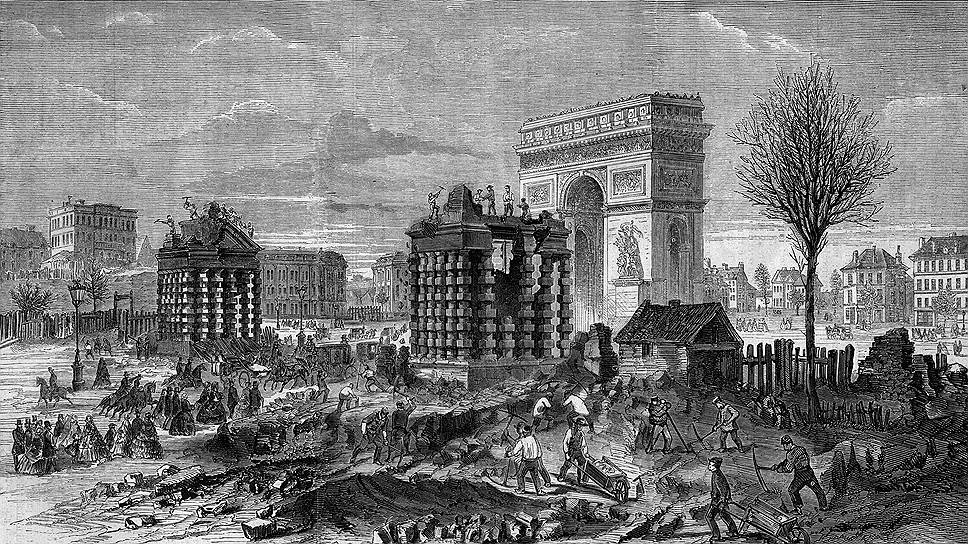
Фото: leemage/AFP/EASTNEWS
11.05.2017, 12:00
Османизация, как известно, не отуречивание — это, как бы мы сейчас сказали, реновация французской столицы в 1853–1870 годах, а проводивший ее барон Осман не был турком. Но даже если бы он был турком и возглавлял армию Османской империи, а та чудом захватила бы Париж, он и тогда не причинил бы городу больших разрушений, чем те, что нанес, будучи префектом. Что, впрочем, не мешает любить построенный им город парижанам и гостям французской столицы.
Именем Императора
Строго говоря, такая игра слов возможна только в русском языке благодаря французскому произношению немецких фамилий. Жорж-Эжен Осман родился в Париже, но был потомком протестантов из вечно переходящего из рук в руки Эльзаса (так что содеянное с Парижем можно рассматривать как месть за Варфоломеевскую ночь). Распространенная немецкая фамилия Haussmann в Германии читалась бы как Хаусман, но во Франции из него сделали Османа. Однако, прежде чем перейти к главному герою истории Парижа третьей четверти XIX века, надо сказать пару слов о его патроне — Осман оставался лишь слугой, правда слугой старательным и исполнительным.
В 1848 году был свергнут последний, уже конституционный, французский король Луи-Филипп. После этого Франция несколько устала от революций, а революции — от Франции. Все хотели порядка — и связывали порядок с крепкой властью.
Привело это к тому, что на выборах 10 декабря 1848 года 75 процентов проголосовало за избрание президентом сорокалетнего Шарля-Луи Наполеона Бонапарта, племянника великого императора. Тот, разумеется, поклялся и побожился, что будет верен республике и конституции.
Ни он сам, ни те, кто его поддерживал, на самом деле ничего такого в виду не имели. 2 декабря 1851-го, в годовщину Аустерлица, новый Наполеон разогнал Национальное собрание и совершил государственный переворот. Тут же был проведен референдум, в ходе которого почти 7,5 млн проголосовало за увеличение президентского срока с четырех лет до десяти и за расширение президентских полномочий. Против высказалось меньше 650 тысяч.
Результат референдума стал явным сигналом того, что народ не против и более жесткой власти. Если новый Наполеон, которого в недалеком будущем Бисмарк — заслуженно — назовет большим, но пока не признанным ничтожеством, чего и умел, так это улавливать настроения. Он их и уловил. Вылилось это в то, что в следующем, 1852-м, году был проведен еще один референдум, ставший логическим продолжением первого. Вопрос, поставленный на нем, звучал так: «Поддерживаете ли вы ратификацию установленной сенатским указом Конституции империи?»
Идея возвращения империи оказалась суперпопулярной. За нее проголосовало более 7,8 млн избирателей, а против — лишь чуть более 250 тысяч. Люди быстро наелись относительной демократии и хотели сильной руки.
Через 18 лет, когда их страна позорно проиграет Франко-Прусскую войну, а сам император, вошедший в историю как Наполеон III, окажется в плену, люди узнают, кого выбрали своим повелителем, и постараются забыть о нем, словно не они его поддерживали.
Между тем с будущим Третьим Наполеоном все было ясно с 1836-го, когда он предпринял настолько идиотическую попытку государственного переворота, что Луи-Филипп его, как дурака, простил и отправил в изгнание. В 1840 году Шарль Луи повторил попытку и на этот раз загремел на шесть лет, после чего уехал из Франции. В ходе своих разъездов Наполеон побывал в Лондоне, который его совершенно очаровал правильностью застройки, прямыми и широкими улицами и масштабами — все это, как ни странно, имеет самое прямое отношение к истории Парижа.
Наполеон III (слева), мечтавший превратить Париж в Лондон, в лице барона Османа (справа) нашел верного и энергичного союзника
Фото: DeAgostini / DIOMEDIA
Дело в том, что Лондон, в отличие от большинства европейских столиц, не был по своей структуре средневековым городом, проложенным — воспользуемся определением Ле Корбюзье — «по ослиным тропам». Большой пожар 1666 года тот город уничтожил, после чего он был фактически отстроен заново уже во вполне «индустриальном» стиле.
Как многие не то чтобы совсем маленькие, но «небольшие» люди, вознесенные на вершину, Наполеон III бредил грандиозными проектами, и, едва придя к власти, запустил сразу два таких: во внешней политике это была Крымская война (тут, правда, не обошлось и без других действующих лиц вроде Николая I), а в самой Франции — коренную перепланировку Парижа, фактически строительство нового города на месте старого. Причем можно сказать, что без первого не было бы в полном масштабе и второго. Просто эмоционального пороха не хватило бы.
Париж до середины XIX века был типичным средневековым городом, в котором улицы проложены «ослиными тропами»
Фото: Lanmas / Alamy / DIOMEDIA
У Франции и Наполеона III не было особых причин ввязываться в войну с Россией. Не стоит переоценивать бодание сторон за контроль над христианскими святыми местами в Палестине. Оно сыграло какую-то роль, как и сознательное оскорбление, нанесенное Николаем I Наполеону III, которого, вопреки этикету российский государь назвал не своим братом, как монарх монарха, а другом, но никак не решающую. Были и другие факторы, но Франция вряд ли вступила бы в войну, проходящую бог знает где бог знает за что, если бы не достаточно популярное в народе желание взять реванш за 1812 год. Что Крым французам? Что французы Крыму?
Победа союзников, среди которых была и Франция, кстати, понесшая самые большие потери, позволила маленькому Наполеону воспарить. Как-никак, но он добился того, чего не смог добиться даже Наполеон большой: победил Россию. А что не один и не так чтобы очень победил, так кто будет вдаваться в такие подробности?
Теперь с новым жаром можно было взяться и за Париж. Строго говоря, перепланировка началась еще в 1853 году, но после победы дело было поставлено на другие рельсы.
Верный префект
При авторитарных правителях всегда находятся ретивые исполнители их воли. Причем исполняют они ее не из-под палки, сами искренне загораясь, и, поначалу чужая для них, идея становится делом всей их жизни. Примерно таким при Наполеоне III и был Жорж-Эжен Осман, сам себя предпочитавший называть «барон Осман», хотя официально титула и не получивший.
Во времена правления Луи-Филиппа и первых лет президентства Луи Наполеона Осман делал достаточно успешную административную карьеру. Последними его должностями перед головокружительным взлетом были посты префекта сначала в департаменте Вар, а затем в департаменте Йонна. Не самые высокие посты в не самых значимых местах.
До того как стать префектом Сены Жорж-Эжен Осман успешно делал административную карьеру в департаментах Вар и Йонна
Фото: Bibliotheque nationale de France
Однако новое время требовало новых людей. С самого начала своего президентства Луи Наполеон не спускал глаз с Парижа, из которого хотел сделать Лондон. Увы, Жан-Жак Берже, префект департамента Сена, как-то вяло претворял планы будущего императора в жизнь, и ему стали искать замену. Поиском занялся самый преданный человек, министр внутренних дел Виктор де Персиньи, который провел «собеседование» с префектами разных департаментов и множеством других кандидатов. Самое сильное впечатление на него произвел изначально вовсе не числившийся в фаворитах Осман. Персиньи дал ему характеристику, которую имеет смысл привести целиком, настолько она всеобъемлюща и красноречива:
«Самое сильное впечатление среди всех на меня произвел месье Осман. Странно, но больше, чем его таланты и замечательный ум, мне понравились недостатки его характера. Передо мной стоял один из самых необычных людей нашего времени: крупный, сильный, энергичный, полный сил и в то же время умный, изворотливый и очень находчивый. Этот дерзкий человек не боялся показать, что он из себя представляет. Он рассказал мне обо всех достижениях в своей административной карьере, не упуская ни одной детали. Он мог говорить не умолкая шесть часов, так как это (видимо, имеется в виду градостроительство) было его любимой темой. Прямо скажу, мне это понравилось. Мне показалось, что он как раз тот человек, который мне нужен для того, чтобы бороться с представлениями и предрассудками целой школы экономистов, против людей, уклоняющихся от работы, и скептиков, которые пришли с биржи, против тех, кто использовал в борьбе не самые честные методы. Да, он был тем, кто мне был нужен. В той ситуации, в которой более высокого духом умного джентльмена с прямым и благородным характером постигнет неудача, этот пышущий энергией атлет, исполненный дерзости и при этом много чего умеющий, у которого на каждый прием противника найдется свой, который на любую чужую уловку найдет свою, более хитрую, обязательно добьется успеха. Я рассказал ему о предстоящих в Париже работах и предложил возглавить руководство ими».
Персиньи настоятельно рекомендовал Наполеону III назначить Османа префектом Сены, что тот и сделал. Участь Парижа была решена.
Будущее показало, что у Османа была еще одна черта, ценная для крупного чиновника. Это был человек-бульдозер. Ему была совершенно безразлична судьба конкретных людей, а если того требовала ситуация, то и миллионов людей.
Ради достижения своих целей он мог пожертвовать ими всеми как пешками. Причем речь здесь идет не о чистом корыстолюбии или честолюбии, речь идет и о следовании некой высокой цели, достижение которой требует неизбежных жертв. Если ты попадал в жернова Османа, это означало, что тебе не повезло. Они тебя перемалывали как зерно и думали о тебе не больше, чем думают обычные жернова. А тут в них попал весь Париж со всеми его обитателями.
Париж не сразу строился
Париж нуждался в реконструкции давно, но до середины XIX века на нее не находилось средств
Фото: Granger / DIOMEDIA
Не стоит думать, что до 1853 года во французской столице все было хорошо, а потом пришел барон Осман и, как поручик Ржевский, все опошлил.
О том, что Париж нуждается в коренной реконструкции, серьезно заговорили еще в последние годы правления короля Людовика XIV, в начале XVIII века. Средневековые города, а Париж того времени, по сути, таким и был, хороши всем, кроме того, что цивилизации с канализацией там места нет — в самом прямом смысле слова.
О коренной реконструкции столицы постоянно думал и очень любивший ее Наполеон. Однако из-за войн денег вечно не хватало, и он успел только обустроить Рю-де-Риволи от площади Согласия до Лувра. Собственно, о перестройке мечтал каждый правитель Франции в течение полутора веков, но задача пугала своей грандиозностью, и ее оставляли потомкам.
Париж давно не влезал в Париж. Город был перенаселен, ситуацию усугубляла узость улиц. Скученность очень способствовала возникновению эпидемий, в частности холеры, которая периодически выкашивала немалый процент местных жителей. Короче говоря, откладывать реконструкцию французской столицы дальше было нельзя. Другое дело, как ее проводить.
На первых порах перед Османом стояла совершенно конкретная задача: насколько это возможно, привести город в порядок перед Парижской международной выставкой 1855 года.
Выставка 1855 года стала поводом для коренной реконструкции Парижа
Фото: DIOMEDIA
Надо сказать, что Наполеон III существенно облегчил деятельность Османа. Луи-Филипп тоже хотел заняться перекройкой Парижа, но даже у «короля-банкира» не хватило денег, чтобы выкупить недвижимость у владельцев, дабы ее разрушить, а потом построить новую. Наполеон III решил эту проблему еще до прихода Османа. В феврале 1851 года был принят закон об упрощении экспроприации земель и всего на них стоящего. Осман тут же стал широко пользоваться новым законом, причем ответ за свои действия он держал только перед императором. Так началось то, что потом вылилось в большую трагедию для множества людей и для города в целом.
Ну а пока Осман готовил Париж к выставке, и счет жертвам только начался. Парламент выделил ему на работы колоссальную по тем временам сумму 50 млн франков. Еще 24 млн дали банкиры братья Перейр, получившие за это право строить здания на реконструируемых улицах. Эта схема финансирования потом использовалась Османом неоднократно.
Первой реконструированной улицей стала Рю-де-Риволи
Фото: AFP / EASTNEWS
Начали реконструкции с Рю-де-Риволи, которую значительно расширили, обустроили и на которой возвели первый по-настоящему роскошный парижский отель — «Гранд-Отель дю Лувр». Его открыли прямо перед выставкой, и там поселились самые почетные гости, в том числе августейшие особы. Так Наполеон III с помощью Османа сделал первый шаг к тому, чтобы сделать Париж столицей не только Франции, но и мира или по крайней мере Европы.
На Рю-де-Риволи к выставке 1855 года построили роскошный «Гранд-Отель дю-Лувр»
Фото: AFP / EASTNEWS
Далее Осман построил так называемый Большой парижский крест на севере города. Теперь с востока на запад шли Рю-де-Риволи и Рю-де-Сент-Антуан, а с севера на юг — Страсбургский и Севастопольский бульвары.
Все это были проекты действительно колоссальной важности, но на первом этапе реконструкции, в 1853–1859 годах, парижане еще не поняли, что их ждет и сколько все это продлится.
Бульвары прокладывались «по живому» — без колебаний сносились все здания, стоящие на пути
Фото: Mary Evans / DIOMEDIA
Осман строил парижские магистрали, как Николай I — железную дорогу из Петербурга в Москву, по прямой, сокрушая все на своем пути. И здесь для него не то чтобы не было ничего святого — было, просто крайне мало, что и стало очевидно на следующем этапе строительства.
Осман проложил «по живому» множество проспектов и площадей. В местах, где большой считалась улица в пять метров шириной, теперь появлялись засаженные каштанами бульвары шириной в 30 метров. Там, где сейчас находится площадь Бастилии, было уничтожено несколько улиц. В том числе Le Boulevard du Crime, знаменитая улица театров, сыгравшая заметную роль в истории французской культуры. Можно долго и нудно перечислять названия улиц, которые были построены по проекту Османа, но это не имеет большого смысла, потому что на самом деле весь (!) нынешний Париж — его рук дело. Уцелели только небольшие островки вроде квартала Маре, и (кто бы мог подумать?) это самые прекрасные места в Париже.
Особенно досталось острову Сите, где были разрушены практически все здания вокруг собора Парижской Богоматери, как средневековые, так и более поздней постройки, проложены три поперечные улицы, расширена площадь перед собором, но при этом часовня Сен-Шапель угодила во внутренний двор Дворца правосудия.
На острове Сите были снесены почти все здания вокруг Нотр-Дама
Фото: DeAgostini / DIOMEDIA
Ни один гриб не растет с такой скоростью, как росли расходы на реконструкцию Парижа. Цифры, казавшиеся когда-то огромными, становились смешными. Только на начальном этапе на строительство бульваров было потрачено 278 млн франков. Затраты на следующий этап разрушения и строительства на обоих берегах Сены и на острове Сите были оценены Османом в 180, но в реальности достигли 410 миллионов.
Часовня Сен-Шапель в результате реконструкции Сите оказалась во дворе Дворца правосудия
Фото: Mary Evans / DIOMEDIA
Осман и его последователи любили говорить, что это результат жульнических судебных исков. Дело в том, что практически все первые этажи сносимых зданий были заняты магазинами и лавками — их владельцы потеряли свой бизнес. Они подавали в суд, а суд вовсе не обязательно вставал на защиту власть имущих. В этом плане Франция второй половины позапрошлого века была впереди многих нынешних демократий. Разумеется, среди исков были и жульнические, когда с государства пытались получить деньги за якобы утраченный, а на самом деле никогда не существовавший бизнес. Однако таких был ничтожный процент. В массе своей люди получали не слишком щедрую компенсацию за экспроприированные дома и порушенную жизнь, после чего были вольны идти на все четыре стороны.
Жителям и владельцам магазинов в домах, попадавших под снос, префектура выплачивала компенсацию
Фото: Mary Evans / DIOMEDIA
Когда же в конце 1860-х годов подсчитали общие расходы на османизацию Парижа (это официальный термин — travaux haussmanniens), то, как водится, прослезились: 2,5 млрд франков. Около 15 млрд нынешних долларов. А ведь то было другое время, и количество денег тоже было совершенно иным. Сумма оказалась настолько огромной, что вроде бы даже Наполеон III слегка озадачился, когда узнал, во что обошлась его затея.
Катастрофическая реконструкция
20 лет парижане жили среди котлованов и строящихся зданий
Фото: APIC / Getty Images
Виктор Гюго утверждал, что в реконструкции Парижа принимало участие 20 процентов всех рабочих, проживавших в городе. Почти 20 лет Париж представлял собой огромную стройку с вырытыми котлованами, перерытыми и перекрытыми дорогами и бесконечными заборами.
В конце концов непрекращающаяся стройка стала надоедать даже тем, кто изначально был за реконструкцию.
Так, в 1867 году историк Леон Галеви писал: «То, что сделал месье Осман, не имеет аналогов. С этим согласны все. Месье Осман сотворил за 15 лет то, с чем другие не справились бы за целый век. Но на сегодня хватит. Будет еще XX век. Давайте оставим какую-то работу тем, кто тогда будет жить».
Здесь за показной лояльностью видно сильнейшее раздражение: Халеви предлагает взять паузу не на какой-то короткий срок, а как минимум на три с лишним десятка лет. Самому ему в тот момент было уже 65, и никаких османовских строек на своем веку он больше видеть не хотел.
Примерно тогда же Осман, до тех пор всегда добивавшийся своего, потерпел первое серьезное поражение: ему не позволили перекроить Люксембургский сад так, как он хотел. Осману пришлось пойти на серьезные уступки, но и это не устроило широкую публику. Однажды он был освистан парижанами в присутствии императора.
Самой характерной чертой парижского пейзажа во второй половине XIX века были строительные леса
Фото: Corbis / Getty Images
Падение было предрешено. Наполеон III не отличался ни силой характера, ни принципиальностью, и вопрос заключался только в том, когда он сдаст префекта. В 1869 году Осману было предложено подать в отставку. Он этого не сделал. Тогда император сам освободил его от занимаемой должности.
Вскоре после отставки об Османе на время забыли: Франции стало не до него. Французы, не отстоявшие свою столицу перед Османом, не отстояли и свою страну перед врагом, с треском проиграв Франко-Прусскую войну 1870–1871 годов, завершившуюся Парижской коммуной, и не в одном бездарном Третьем Наполеоне здесь было дело. Безропотное стадо — оно и в бою безропотное стадо.
После войны во Франции снова была восстановлена республика. Страна начала приходить в себя и очень быстро вспомнила Османа. Самопровозглашенный барон при желании тогда мог услышать о себе много интересного. Сам он думал о людях, чьи судьбы переехал, не больше, чем феодал, который в погоне за оленем уничтожил крестьянский урожай, зато пострадавшие его не забыли, и у них нашлись глашатаи с громкими именами. Собственно, они и раньше не молчали, но теперь просто не знали удержу.
Обвинители, в свою очередь, не всегда были справедливы. Осман радикально улучшил систему городской канализации, расширил улицы, снизил плотность населения, а это привело в числе прочего и к тому, что сильно снизилось количество смертей от эпидемий. Наконец, он построил жилья больше, чем снес. Да, не там, но построил.
Канализация, появившаяся в Париже после реконструкции, по мнению многочисленных критиков Османа, не стоила таких разрушений
Фото: CCI ARCHIVES / DIOMEDIA
Не менее важно другое: префект полностью уничтожил уклад жителей столицы. Он разрушил город, в котором они выросли, он уничтожил их привычную среду, создав на ее месте новую, однообразную и помпезную.
Но людские страдания быстро забываются, а вот город остается, и того, что Осман сделал с Парижем, ему и не простили, сочтя отлаженную систему канализации слишком малой компенсацией. «Париж не вернется, меняются стены, / Как ни грустно, быстрей наших бренных сердец»,— сказал Бодлер еще в 1861 году, когда Осман только разворачивал свою деятельность. «Кровоточащий Париж, словно разрубленный саблей на куски»,— сказал Эмиль Золя через десять лет, подводя итоги деятельности самоназванного барона.
Но то люди искусства, что с них возьмешь. Наконец слово взяли и политики. Жюль Флерри (в 1883–1885 годах он станет премьер-министром страны) всю работу Османа назвал торжествующей пошлостью, и большинство было с ним согласно.
Париж стал куда более просторным, но абсолютно однообразные типовые османовские здания, выстроившиеся по всему городу как солдаты на плацу, лишили французскую столицу неповторимого колорита.
Думаю, многие советские и постсоветские граждане, впервые оказавшись в Париже лет 20–30 назад, как и я, испытали известное разочарование и засомневались в верности популярного у нас тогда выражения, будто, увидев этот город, можно и умереть. Атмосфера, бесконечные кафе, веселые толпы — это, конечно, замечательно. Но сам город — очень обычный. Есть архитектурные шедевры вроде собора Парижской Богоматери или Сен-Шапель, но они существуют как острова, чуждые всему, что их окружает. Они просто вырваны из своего контекста, из своего города. Город уничтожен, а они, уцелевшие, смотрятся его руинами.
В чем-то вторая половина XIX и начало XX века были эпохой большого бескультурья, которое в самой полной мере представлял Осман. Не случайно самая жесткая критика обрушилась на барона через сто лет после того, как он уже закончил свою работу.
Большинство зданий, сегодня определяющих облик Парижа, были построены во время «османизации»
Фото: leemage/AFP / EASTNEWS
Так, известный историк Парижа и куратор его музеев Рене Эрон де Вильфос (1903–1985) писал: «Менее чем за двадцать лет Париж потерял свой исторический облик, свой характер, который передавался от поколения к поколению. Живописная и очаровательная атмосфера города, которую отцы передали нам, была уничтожена. Часто без серьезных на то оснований».
Больше всего Осману от де Вильфоса досталось за остров Сите: «Барон Осман пустил торпеду в старый корабль Парижа, который затонул во время его правления. Пожалуй, это было самое страшное преступление страдавшего мегаломанией префекта, а также его самой большой ошибкой. Его работа принесла больше вреда, чем сотня бомбардировок. Частично его действия были вызваны необходимостью, и мы должны отдать должное его уверенности в своих силах, но ему, совершенно точно, не хватало культуры и вкуса. В Соединенных Штатах все это сработало бы прекрасно, но для нашей столицы, которую он на двадцать лет покрыл заборами, строительными лесами, гравием и пылью, его действия были преступлением, ошибкой и проявлением дурного вкуса».
Между прочим, уничтоженный Османом Париж все-таки можно увидеть. На фотографиях. В конце 1850-х годов, когда уже было ясно, куда ведут проекты Османа, известный фотограф Шарль Мервиль получил заказ создать портрет уходящей французской столицы. Он был блестящим и едва ли не первым мастером городского пейзажа и превосходно справился с заданием, сделав сотни фотографий, сохранивших уничтоженный Османом город для нас. К сожалению, Париж Мервиля безлюден. Просто техника того времени не позволяла снимать то, что хоть как-то двигалось, поэтому фотографу приходилось выбирать безлюдное время для своих съемок, и на его работах мы видим только здания, которые скоро будут снесены Османом, но не людей, по чьим судьбам он проедется катком.
Париж до Османа
Passage de Tivoli, 1866
Фото: Charles Marville
Saint Martin, 1866
Фото: Charles Marville
Les Halles, 1866
Фото: Charles Marville
Place des Trois-Maries, 1866
Фото: Charles Marville
Rue Maitre Albert, 1866
Фото: Charles Marville
Rue de Constantine, 1865
Фото: Charles Marville
Rue de Viarmes, 1866
Фото: Charles Marville
Rue des Colonnes, 1866
Фото: Charles Marville
Rue des Moulins, 1866
Фото: Charles Marville
Rue Montmartre, 1868
Фото: Charles Marville
Les Halles, 1866
Фото: Charles Marville
Rue Reaumur, 1866
Фото: Charles Marville
Place Maubert, 1866
Фото: Charles Marville
Rue du Contrat Social, 1866
Фото: Charles Marville
Place Sainte-Opportune, 1865
Фото: Charles Marville
Rue de Tilsitt, 1867
Фото: Charles Marville
Quai de Montebello, 1866
Фото: Charles Marville
Rue des Messageries, 1865
Фото: Charles Marville
Rue de la Poterie, 1865
Фото: Charles Marville
Вид на Сену, 1858
Фото: Charles Marville
Впрочем, и так эти снимки производят сильное впечатление. Там нет каких-то особых архитектурных шедевров, но это живой город, с любовью выстроенный людьми для себя. Его можно и нужно было реконструировать в соответствии с требованиями времени, но вовсе необязательно было приносить сотни лет парижской истории и судьбы сотен тысяч парижан в жертву канализации. Канализация таких жертв не требовала.
The oldest traces of human occupation in Paris, discovered in 2008 near the Rue Henri-Farman in the 15th arrondissement, are human bones and evidence of an encampment of hunter-gatherers dating from about 8000 BC, during the Mesolithic period.[1]
Between 250 and 225 BC, the Parisii, a sub-tribe of the Celtic Senones, settled on the banks of the Seine, built bridges and a fort, minted coins, and began to trade with other river settlements in Europe.[2]
In 52 BC, a Roman army led by Titus Labienus defeated the Parisii and established a Gallo-Roman garrison town called Lutetia.[3] The town was Christianised in the 3rd century AD, and after the collapse of the Roman Empire, it was occupied by Clovis I, the King of the Franks, who made it his capital in 508.
During the Middle Ages, Paris was the largest city in Europe, an important religious and commercial centre, and the birthplace of the Gothic style of architecture. The University of Paris on the Left Bank, organised in the mid-13th century, was one of the first in Europe. It suffered from the Bubonic Plague in the 14th century and the Hundred Years’ War in the 15th century, with recurrence of the plague. Between 1418 and 1436, the city was occupied by the Burgundians and English soldiers. In the 16th century, Paris became the book-publishing capital of Europe, though it was shaken by the French Wars of Religion between Catholics and Protestants. In the 18th century, Paris was the centre of the intellectual ferment known as the Enlightenment, and the main stage of the French Revolution from 1789, which is remembered every year on the 14th of July with a military parade.
In the 19th century, Napoleon embellished the city with monuments to military glory. It became the European capital of fashion and the scene of two more revolutions (in 1830 and 1848). Under Napoleon III and his Prefect of the Seine, Georges-Eugène Haussmann, the centre of Paris was rebuilt between 1852 and 1870 with wide new avenues, squares and new parks, and the city was expanded to its present limits in 1860. In the latter part of the century, millions of tourists came to see the Paris International Expositions and the new Eiffel Tower.
In the 20th century, Paris suffered bombardment in World War I and German occupation from 1940 until 1944 in World War II. Between the two wars, Paris was the capital of modern art and a magnet for intellectuals, writers and artists from around the world. The population reached its historic high of 2.1 million in 1921, but declined for the rest of the century. New museums (The Centre Pompidou, Musée Marmottan Monet and Musée d’Orsay) were opened, and the Louvre given its glass pyramid.
In the 21st century, Paris added new museums and a new concert hall, but in 2005 it also experienced violent unrest in the housing projects in the surrounding banlieues (suburbs), inhabited largely by first and second generation immigrants from France’s former colonies in the Maghreb and Sub-Saharan Africa. In 2015, the city and the nation were shocked by two deadly terrorist attacks carried out by Islamic extremists. The population of the city declined steadily from 1921 until 2004, due to a decrease in family size and an exodus of the middle class to the suburbs; but it is increasing slowly once again, as young people and immigrants move into the city.
Prehistory[edit]
Site of the Institut National de Recherches Archéologiques Préventives (INRAP) digging at the Rue Henri-Farman (15th arrondissement) in June 2008
In 2008, archaeologists of the Institut national de recherches archéologiques préventives (INRAP) (administered by France’s Ministry of Higher Education and Research) digging at n° 62 Rue Henri-Farman in the 15th arrondissement, not far from the Left Bank of the Seine, discovered the oldest human remains and traces of a hunter-gatherer settlement in Paris, dating to about 8000 BC, during the Mesolithic period.[1]
Other more recent traces of temporary settlements had been found at Bercy in 1991, dating from around 4500–4200 BC.[4] The excavations at Bercy found the fragments of three wooden canoes used by fishermen on the Seine, the oldest dating to 4800-4300 BC. They are now on display at the Carnavalet Museum.[5][6][7] Excavations at the Rue Henri-Farman site found traces of settlements from the middle Neolithic period (4200-3500 BC); the early Bronze Age (3500-1500 BC); and the first Iron Age (800-500 BC). The archaeologists found ceramics, animal bone fragments, and pieces of polished axes.[8] Hatchets made in eastern Europe were found at the Neolithic site in Bercy, showing that first Parisians were already trading with settlements in other parts of Europe.[2]
The Parisii and the Roman conquest (250–52 BC)[edit]
Gold coins minted by the Parisii (1st century BC)
Between 250 and 225 BC, during the Iron Age, the Parisii, a sub-tribe of the Celtic Senones, settled on the banks of the Seine. At the beginning of the 2nd century BC, they built an oppidum, a walled fort, whose location is disputed. It may have been on the Île de la Cité, where bridges of an important trading route crossed the Seine. In his account of the Gallic wars, Julius Caesar recorded meeting with the leaders of the Parisii on an island in the Seine. Other historians cite an absence of traces of an early Gallic settlement on the island, and believe the oppidum was actually in Nanterre, in the Paris suburbs, where vestiges of a large settlement were discovered during construction of a highway in the 1980s.[9][2][10]
The settlement was called «Lucotocia» (according to the ancient Greek geographer Strabo) or «Leucotecia» (according to Roman geographer Ptolemy), and may have taken its name from the Celtic word lugo or luco, for a marsh or swamp.[11] It had a strategic position on the main trade route, via the Seine and Rhône rivers, between Britain and to the Roman colony of Provence and the Mediterranean Sea.[12][13] The location and the fees for crossing the bridge and passing along the river made the town prosperous,[14] so much so that it was able to mint its own gold coins.
Julius Caesar and his Roman army campaigned in Gaul between 58 and 53 BC under the pretext of protecting the territory from Germanic invaders, but in reality to conquer it and annex it to the Roman Republic.[15] In the summer of 53 BC, he visited the city and addressed the delegates of the Gallic tribes assembled before the temple to ask them to contribute soldiers and money to his campaign.[16] Wary of the Romans, the Parisii listened politely to Caesar, offered to provide some cavalry, but formed a secret alliance with the other Gallic tribes, under the leadership of Vercingetorix, and launched an uprising against the Romans in January 52 BC.[17]
Caesar responded quickly. He force-marched six legions north to Orléans, where the rebellion had begun, and then to Gergovia, the home of Vercingetorix. At the same time, he sent his deputy Titus Labienus with four legions to subdue the Parisii and their allies, the Senons. The Commander of the Parisii, Camulogene, burned the bridge that connected the oppidum to the left bank of the Seine, so the Romans were unable to approach the town. Then Labienus and the Romans went downstream, built their own pontoon bridge at Melun and approached Lutetia on the right bank. Camulogene responded by burning the bridge to the right bank and burning the town, before retreating to the left bank and making camp at what is now Saint-Germain-des-Prés.[3]
Labienus deceived the Parisii with a ruse. In the middle of the night he sent part of his army, making as much noise as possible, upstream to Melun. He left his most inexperienced soldiers in their camp on the right bank. With his best soldiers, he quietly crossed the Seine to the left bank and laid a trap for the Parisii. Camulogene, believing that the Romans were retreating, divided his own forces, some to capture the Roman camp, which he thought was abandoned, and others to pursue the Roman army. Instead he ran directly into the best two Roman legions on the plain of Grenelle, near the site of the modern Eiffel Tower and the École Militaire. The Parisii fought bravely and desperately in what became known as the Battle of Lutetia. Camulogene was killed and his soldiers were cut down by the disciplined Romans. Despite the defeat, the Parisii continued to resist the Romans. They sent eight thousand men to fight with Vercingetorix in his last stand against the Romans at the Battle of Alesia.[3]
Roman Lutetia (52 BC–486 AD)[edit]
A Gallo-Roman stele of Mercury, from Lutetia. The people of Lutetia worshipped both Roman and Celtic gods. (Carnavalet Museum)
The Romans built an entirely new city as a base for their soldiers and the Gallic auxiliaries intended to keep an eye on the rebellious province. The new city was called Lutetia (Lutèce) or «Lutetia Parisiorum» («Lutèce of the Parisii»). The name probably came from the Latin word luta, meaning mud or swamp[18] Caesar had described the great marsh, or marais, along the right bank of the Seine.[19] The major part of the city was on the left bank of the Seine, which was higher and less prone to flood. It was laid out following the traditional Roman town design along a north–south axis (known in Latin as the cardo maximus).[20]
On the left bank, the main Roman street followed the route of the modern day Rue Saint-Jacques. It crossed the Seine and traversed the Île de la Cité on two wooden bridges: the «Petit Pont» and the «Grand Pont» (today’s Pont Notre-Dame). The port of the city, where the boats docked, was located on the island where the parvis of Notre Dame is today. On the right bank, it followed the modern Rue Saint-Martin.[20] On the left bank, the cardo was crossed by a less-important east–west decumanus, today’s Rue Cujas, Rue Soufflot and Rue des Écoles.
The city was centered on the forum atop the Montagne Sainte-Geneviève between the Boulevard Saint-Michel and the Rue Saint-Jacques, where the Rue Soufflot is now located. The main building of the forum was one hundred meters long and contained a temple, a basilica used for civic functions and a square portico which covered shops. Nearby, on the slope of the hill, was an enormous amphitheatre built in the 1st century AD, which could seat ten to fifteen thousand spectators, though the population of the city was only six to eight thousand.[21]
Fresh drinking water was supplied to the city by an aqueduct sixteen kilometres long from the basin of Rungis and Wissous. The aqueduct also supplied water to the famous baths, or Thermes de Cluny, built near the forum at the end of the 2nd century or beginning of the 3rd century. Under Roman rule, the town was thoroughly Romanised and grew considerably.
Besides the Roman architecture and city design, the newcomers imported Roman cuisine: modern excavations have found amphorae of Italian wine and olive oil, shellfish, and a popular Roman sauce called garum.[20] Despite its commercial importance, Lutetia was only a medium-sized Roman city, considerably smaller than Lugdunum (Lyon) or Agedincum (Sens), which was the capital of the Roman province of Lugdunensis Quarta, in which Lutetia was located.[22]
Christianity was introduced into Paris in the middle of the 3rd century AD. According to tradition, it was brought by Saint Denis, the Bishop of the Parisii, who, along with two others, Rustique and Éleuthère, was arrested by the Roman prefect Fescennius. When he refused to renounce his faith, he was beheaded on Mount Mercury. According to the tradition, Saint Denis picked up his head and carried it to a secret Christian cemetery of Vicus Cattulliacus about six miles away. A different version of the legend says that a devout Christian woman, Catula, came at night to the site of the execution and took his remains to the cemetery. The hill where he was executed, Mount Mercury, later became the Mountain of Martyrs («Mons Martyrum»), eventually Montmartre.[23] A church was built on the site of the grave of St. Denis, which later became the Basilica of Saint-Denis. By the 4th century, the city had its first recognized bishop, Victorinus (346 AD). By 392 AD, it had a cathedral.[24]
Late in the 3rd century AD, the invasion of Germanic tribes, beginning with the Alamans in 275 AD, caused many of the residents of the Left Bank to leave that part of the city and move to the safety of the Île de la Cité. Many of the monuments on the Left Bank were abandoned, and the stones used to build a wall around the Île de la Cité, the first city wall of Paris. A new basilica and baths were built on the island; their ruins were found beneath the square in front of the cathedral of Notre Dame.[25] Beginning in 305 AD, the name Lutetia was replaced on milestones by Civitas Parisiorum, or «City of the Parisii». By the period of the Late Roman Empire (the 3rd-5th centuries AD), it was known simply as «Parisius» in Latin and «Paris» in French.[26]
From 355 until 360, Paris was ruled by Julian, the nephew of Constantine the Great and the Caesar, or governor, of the western Roman provinces. When he was not campaigning with the army, he spent the winters of 357-358 and 358-359 in the city living in a palace on the site of the modern Palais de Justice, where he spent his time writing and establishing his reputation as a philosopher. In February 360, his soldiers proclaimed him Augustus, or Emperor, and for a brief time, Paris was the capital of the western Roman Empire, until he left in 363 and died fighting the Persians.[27][28] Two other emperors spent winters in the city near the end of the Roman Empire while trying to halt the tide of Barbarian invasions: Valentinian I (365–367) and Gratian in 383 AD.[24]
The gradual collapse of the Roman empire due to the increasing Germanic invasions of the 5th century, sent the city into a period of decline. In 451 AD, the city was threatened by the army of Attila the Hun, which had pillaged Treves, Metz and Reims. The Parisians were planning to abandon the city, but they were persuaded to resist by Saint Geneviève (422–502). Attila bypassed Paris and attacked Orléans. In 461, the city was threatened again by the Salian Franks led by Childeric I (436–481). The siege of the city lasted ten years. Once again, Geneviève organized the defense. She rescued the city by bringing wheat to the hungry city from Brie and Champagne on a flotilla of eleven barges. She became the patron saint of Paris shortly after her death.[29]
The Franks, a Germanic-speaking tribe, moved into northern Gaul as Roman influence declined. Frankish leaders were influenced by Rome, some even fought with Rome to defeat Atilla the Hun. The Franks worshipped the German gods such as Thor. Frankish laws and customs became the basis of French law and customs (Frankish laws were known as salic, meaning ‘salt’ or ‘sea’, law).[30]
Latin was no longer the language of everyday speech. The Franks became more politically influential and built up a large army. In 481, the son of Childeric, Clovis I, just sixteen years old, became the new ruler of the Franks. In 486, he defeated the last Roman armies, became the ruler of all of Gaul north of the river Loire and entered Paris. Before an important battle against the Burgundians, he took an oath to convert to Catholicism if he should win.[31]
He won the battle, and was converted to Christianity by his wife Clotilde, and was baptised at Reims in 496. His conversion to Christianity was likely seen as a title only, to improve his political position. He did not reject the pagan gods and their myths and rituals.[32] Clovis helped to drive the Visigoths out of Gaul. He was a king with no fixed capital and no central administration beyond his entourage. By deciding to be interred at Paris, Clovis gave the city symbolic weight. When his grandchildren divided royal power 50 years after his death in 511 , Paris was kept as a joint property and a fixed symbol of the dynasty.[33]
-
The Roman baths today, now part of the Cluny Museum
-
A Gallo-Roman toga clasp from the late 4th century. Lutetia was famous for its jewelers and craftsmen.
From Clovis to the Capetian kings (6th–11th centuries)[edit]
Clovis I and his successors of the Merovingian dynasty built a host of religious edifices in Paris: a basilica on the Montagne Sainte-Geneviève, near the site of the ancient Roman Forum; the cathedral of Saint-Étienne, where Notre Dame now stands; and several important monasteries, including one in the fields of the Left Bank that later became the Abbey of Saint-Germain-des-Prés. They also built the Basilica of Saint-Denis, which became the necropolis of the kings of France. None of the Merovingian buildings survived, but there are four marble Merovingian columns in the church of Saint-Pierre de Montmartre.[34] The kings of the Merovingian dynasty were buried in the Abbey of Saint-Germain-des Prés, however Dagobert I, the last king of the Merovingian dynasty, who died in 639, was the first Frankish king to be buried in the Basilica of Saint-Denis.
The kings of the Carolingian dynasty, who came to power in 751, moved the Frankish capital to Aix-la-Chapelle (Aachen) and paid little attention to Paris, though King Pepin the Short did build an impressive new sanctuary at Saint-Denis, which was consecrated in the presence of Charlemagne on 24 February 775.[35]
In the 9th century, the city was repeatedly attacked by the Vikings, who sailed up the Seine on great fleets of Viking ships. They demanded a ransom and ravaged the fields. In December 856, Vikings who had been wintering on the island of Oscelle attacked and burned Paris. According to the Royal Frankish Annals, they burned all the churches of Paris with the exception of St. Germain-des-Prés, the Cathedral of St. Stephen, the Church of St. Vincent and St. Denis, which were spared due to a payment of ransom (Royal Frankish Annals s.a. 856 and 857). In 885–886, they laid a one-year siege to Paris and tried again in 887 and in 889, but were unable to conquer the city, as it was protected by the Seine and the walls of the Île de la Cité.[36] The two bridges, vital to the city, were additionally protected by two massive stone fortresses, the Grand Châtelet on the Right Bank and the «Petit Châtelet» on the Left Bank, built on the initiative of Joscelin, the bishop of Paris. The Grand Châtelet gave its name to the modern Place du Châtelet on the same site.[37][36]
In the fall of 978, Paris was besieged by the Emperor Otto II during the Franco-German war of 978–980. At the end of the 10th century, a new dynasty of kings, the Capetians, founded by Hugh Capet in 987, came to power. Though they spent little time in the city, they restored the royal palace on the Île de la Cité and built a church where the Sainte-Chapelle stands today. Prosperity returned gradually to the city and the Right Bank began to be populated. On the Left Bank, the Capetians founded an important monastery: the Abbey of Saint-Germain-des-Prés. Its church was rebuilt in the 11th century. The monastery owed its fame to its scholarship and illuminated manuscripts.
Middle Ages (12th–15th centuries)[edit]
Joan of Arc tries unsuccessfully to liberate Paris (1429)
A page of the first book printed in France (1470): the Epistolae («Letters») by Gasparinus de Bergamo (Gasparino da Barzizza).
The Sainte-Chapelle, the chapel of the former royal palace on the Île de la Cité, flooded by light through the stained glass windows, is a masterpiece of the Gothic style. (13th century)
At the beginning of the 12th century, the French kings of the Capetian dynasty controlled little more than Paris and the surrounding region, but they did their best to build up Paris as the political, economic, religious and cultural capital of France.[36] The distinctive character of the city’s districts continued to emerge at this time. The Île de la Cité was the site of the royal palace, and construction of the new Cathedral of Notre-Dame de Paris began in 1163.[38]
The Left Bank (south of the Seine) was the site of the new University of Paris established by the Church and royal court to train scholars in theology, mathematics and law, and the two great monasteries of Paris: the Abbey of Saint-Germain-des-Prés and the Abbey of Saint Geneviève.[39][38][36] The Right Bank (north of the Seine) became the centre of commerce and finance, where the port, the central market, workshops and the houses of merchants were located. A league of merchants, the Hanse parisienne, was established and quickly became a powerful force in the city’s affairs.
The royal palace and the Louvre[edit]
At the beginning of the Middle Ages, the royal residence was on the Île de la Cité. Between 1190 and 1202, King Philip II built the massive fortress of the Louvre, which was designed to protect the Right Bank against an English attack from Normandy. The fortified castle was a great rectangle of 72 by 78 metres, with four towers, and surrounded by a moat. In the centre was a circular tower thirty meters high. The foundations can be seen today in the basement of the Louvre Museum.
Before he departed for the Third Crusade, Philip II began construction of new fortifications for the city. He built a stone wall on the Left Bank, with thirty round towers. On the Right Bank, the wall extended for 2.8 kilometers, with forty towers to protect the new neighbourhoods of the growing medieval city. Many pieces of the wall can still be seen today, particularly in the Le Marais district. His third great project, much appreciated by the Parisians, was to pave the foul-smelling mud streets with stone. Over the Seine, he also rebuilt two wooden bridges in stone, the Petit-Pont and Grand-Pont, and he began construction on the Right Bank of a covered market, Les Halles.[40]
King Philip IV (r. 1285-1314) reconstructed the royal residence on the Île de la Cité, transforming it into a palace. Two of the great ceremonial halls still remain within the structure of the Palais de Justice. He also built a more sinister structure, the Gibbet of Montfaucon, near the modern Place du Colonel Fabien and the Parc des Buttes Chaumont, where the corpses of executed criminals were displayed. On 13 October 1307, he used his royal power to arrest the members of the Knights Templar, who, he felt, had grown too powerful, and on 18 March 1314, he had the Grand Master of the Order, Jacques de Molay, burned at the stake on the western point of the Île de la Cité.[41]
Between 1356 and 1383, King Charles V built a new wall of fortifications around the city: an important portion of this wall discovered during archaeological diggings in 1991-1992 can be seen within the Louvre complex, under the Place du Carrousel. He also built the Bastille, a large fortress guarding the Porte Saint-Antoine at the eastern end of Paris, and an imposing new fortress at Vincennes, east of city.[42] Charles V moved his official residence from the Île de la Cité to the Louvre, but preferred to live in the Hôtel Saint-Pol, his beloved residence.
Saint-Denis, Notre-Dame and the birth of the Gothic style[edit]
The flourishing of religious architecture in Paris was largely the work of Suger, the abbot of Saint-Denis from 1122–1151 and an advisor to Kings Louis VI and Louis VII. He rebuilt the façade of the old Carolingian Basilica of Saint Denis, dividing it into three horizontal levels and three vertical sections to symbolize the Holy Trinity. Then, from 1140 to 1144, he rebuilt the rear of the church with a majestic and dramatic wall of stained glass windows that flooded the church with light. This style, which later was named Gothic, was copied by other Paris churches: the Priory of Saint-Martin-des-Champs, Saint-Pierre de Montmartre, and Saint-Germain-des-Prés, and quickly spread to England and Germany.[43][44]
An even more ambitious building project, a new cathedral for Paris, was begun by bishop Maurice de Sully in about 1160, and it continued for two centuries. The first stone of the choir of the cathedral of Notre Dame de Paris was laid in 1163, and the altar was consecrated in 1182. The façade was built between 1200 and 1225, and the two towers were built between 1225 and 1250. It was an immense structure, 125 metres long, with towers 63 meters high and seats for 1300 worshippers. The plan of the cathedral was copied on a smaller scale on the Left Bank of the Seine in the church of Saint-Julien-le-Pauvre.[45][46]
In the 13th century, King Louis IX (r. 1226–1270), known to history as «Saint Louis», built the Sainte-Chapelle, a masterpiece of Gothic architecture, especially to house relics from the crucifixion of Christ. Built between 1241 and 1248, it has the oldest stained glass windows preserved in Paris. At the same time that the Saint-Chapelle was built, the great stained glass rose windows, eighteen meters high, were added to the transept of the cathedral.[40]
The University[edit]
Under Kings Louis VI and Louis VII, Paris became one of the principal centers of learning in Europe. Students, scholars and monks flocked to the city from England, Germany and Italy to engage in intellectual exchanges, to teach and be taught. They studied first in the different schools attached to Notre-Dame and the Abbey of Saint-Germain-des-Prés. The most famous teacher was Pierre Abelard (1079–1142), who taught five thousand students at the Montagne Sainte-Geneviève. The University of Paris was originally organised in the mid-12th century as a guild or corporation of students and teachers. It was recognised by King Philip II in 1200 and officially recognised by Pope Innocent III, who had studied there, in 1215.[47]
Some twenty thousand students lived on the Left Bank, which became known as the Latin Quarter, because Latin was the language of instruction at the university and the common language in which the foreign students could converse. The poorer students lived in colleges (Collegia pauperum magistrorum), which were hotels where they were lodged and fed. In 1257, the chaplain of Louis IX, Robert de Sorbon, opened the oldest and most famous College of the University, which was later named after him, the Sorbonne.[47] From the 13th to the 15th century, the University of Paris was the most important school of Roman Catholic theology in western Europe. Its teachers included Roger Bacon from England, Saint Thomas Aquinas from Italy, and Saint Bonaventure from Germany.[36][43]
The Paris merchants[edit]
Beginning in the 11th century, Paris had been governed by a Royal Provost, appointed by the king, who lived in the fortress of Grand Châtelet. Saint Louis created a new position, the Provost of the Merchants (prévôt des marchands), to share authority with the Royal Provost and recognize the growing power and wealth of the merchants of Paris. The importance of guilds of craftsmen was reflected in the gesture of the city government to adapt its coat of arms, featuring a ship, from the symbol of the guild of the boatmen. Saint Louis created the first municipal council of Paris, with twenty-four members.
In 1328, Paris’s population was about 200,000, which made it the most populous city in Europe. With the growth in population came growing social tensions; the first riots took place in December 1306 against the Provost of the Merchants, who was accused of raising rents. The houses of many merchants were burned, and twenty-eight rioters were hanged. In January 1357, Étienne Marcel, the Provost of Paris, led a merchants’ revolt using violence (such as the killing of the councillors of the dauphin before his very eyes) in a bid to curb the power of the monarchy and obtain privileges for the city and the Estates General, which had met for the first time in Paris in 1347. After initial concessions by the Crown, the city was retaken by royalist forces in 1358. Marcel was killed and his followers dispersed (a number of which were later put to death).[48]
Plague and war[edit]
A recreated map of Paris in 1380.
In the middle of the 14th century, Paris was struck by two great catastrophes: the Bubonic plague and the Hundred Years’ War. In the first epidemic of the plague in 1348–1349, forty to fifty thousand Parisians died, a quarter of the population. The plague returned in 1360–1361, 1363, and 1366–1368.[49][42] There were at least 36 occasions of plague occurring within the city between 1348 and 1480.[50] During the 16th and 17th centuries, plague visited the city almost one year out of three.[51] Other diseases that ravaged Paris included the mumps in 1414, scarlet fever in 1418 and smallpox in 1433 and 1438.[50]
The war was even more catastrophic. Beginning in 1346, the English army of King Edward III pillaged the countryside outside the walls of Paris. Ten years later, when King John II was captured by the English at the Battle of Poitiers, disbanded groups of mercenary soldiers looted and ravaged the surroundings of Paris.
More misfortunes followed. An English army and its allies from the Duchy of Burgundy invaded Paris during the night of 28–29 May 1418. Beginning in 1422, the north of France was ruled by John of Lancaster, 1st Duke of Bedford, the regent for the infant King Henry VI of England, who was resident in Paris while King Charles VII of France only ruled France south of the Loire River. During her unsuccessful attempt at taking Paris on 8 September 1429, Joan of Arc was wounded just outside the Porte Saint-Honoré, the westernmost fortified entrance of the Wall of Charles V, not far from the Louvre.[42]
Due to the wars of Henry V on France, Paris fell to the English between 1420–1436, even the child king Henry VI was crowned the king of France there in 1431.[52] When the English left Paris in 1436, Charles VII was finally able to return. Many areas of the capital of his kingdom were in ruins, and a hundred thousand of its inhabitants, half the population, had left the city.
When Paris was again the capital of France, the succeeding monarchs chose to live in the Loire Valley and visited Paris only on special occasions.[53] King Francis I finally returned the royal residence to Paris in 1528.
Besides the Louvre, Notre-Dame and several churches, two large residences from the Middle Ages can still be seen in Paris: the Hôtel de Sens, built at the end of the 15th century as the residence of the Archbishop of Sens, and the Hôtel de Cluny, built in the years 1485–1510, which was the former residence of the abbot of the Cluny Monastery, but now houses the Museum of the Middle Ages. Both buildings were much modified in the centuries that followed. The oldest surviving house in Paris is the house of Nicolas Flamel built in 1407, which is located at 51 Rue de Montmorency. It was not a private home, but a hostel for the poor.[48]
16th century[edit]
The centre of Paris in 1550, by Olivier Truschet and Germain Hoyau.
The Pont Notre-Dame (1512), the first Renaissance bridge in Paris, held a street and sixty-eight houses.
By 1500, Paris had regained its former prosperity, and the population reached 250,000. Each new king of France added buildings, bridges and fountains to embellish his capital, most of them in the new Renaissance style imported from Italy.
King Louis XII rarely visited Paris, but he rebuilt the old wooden Pont Notre Dame, which had collapsed on 25 October 1499. The new bridge, opened in 1512, was made of dimension stone, paved with stone, and lined with sixty-eight houses and shops.[54] On 15 July 1533, King Francis I laid the foundation stone for the first Hôtel de Ville, the city hall of Paris. It was designed by his favourite Italian architect, Domenico da Cortona, who also designed the Château de Chambord in the Loire Valley for the king. The Hôtel de Ville was not finished until 1628.[55] Cortona also designed the first Renaissance church in Paris, the church of Saint-Eustache (1532) by covering a Gothic structure with flamboyant Renaissance detail and decoration. The first Renaissance house in Paris was the Hôtel Carnavalet, begun in 1545. It was modelled after the Grand Ferrare, a mansion in Fontainebleau designed by Italian architect Sebastiano Serlio. It is now the Carnavalet Museum.[56]
In 1534, Francis I became the first French king to make the Louvre his residence; he demolished the massive central tower to create an open courtyard. Near the end of his reign, Francis decided to build a new wing with a Renaissance façade in place of one wing built by King Philip II. The new wing was designed by Pierre Lescot, and it became a model for other Renaissance façades in France. Francis also reinforced the position of Paris as a center of learning and scholarship. In 1500, there were seventy-five printing houses in Paris, second only to Venice, and later in the 16th century, Paris brought out more books than any other European city. In 1530, Francis created a new faculty at the University of Paris with the mission of teaching Hebrew, Greek and mathematics. It became the Collège de France.[57]
Francis I died in 1547, and his son, Henry II, continued to decorate Paris in the French Renaissance style: the finest Renaissance fountain in the city, the Fontaine des Innocents, was built to celebrate Henry’s official entrance into Paris in 1549. Henry II also added a new wing to the Louvre, the Pavillon du Roi, to the south along the Seine. The bedroom of the king was on the first floor of this new wing. He also built a magnificent hall for festivities and ceremonies, the Salle des Cariatides, in the Lescot Wing.[58]
Henry II died 10 July 1559 from wounds suffered while jousting at his residence at the Hôtel des Tournelles. His widow, Catherine de’ Medici, had the old residence demolished in 1563, and between 1564 and 1572 constructed a new royal residence, the Tuileries Palace perpendicular to the Seine, just outside the Charles V wall of the city. To the west of the palace, she created a large Italian-style garden, the Jardin des Tuileries.
An ominous gulf was growing within Paris between the followers of the established Catholic church and those of Protestant Calvinism and Renaissance humanism. The Sorbonne and University of Paris, the major fortresses of Catholic orthodoxy, forcefully attacked the Protestant and humanist doctrines, and the scholar Étienne Dolet was burned at the stake, along with his books, on the Place Maubert in 1532 on the orders of the theology faculty of the Sorbonne; but the new doctrines continued to grow in popularity, particularly among the French upper classes. Beginning in 1562, repression and massacres of Protestants in Paris alternated with periods of tolerance and calm, during what became known as the French Wars of Religion (1562–1598). Paris was a stronghold of the Catholic League.[57][59][60][61]
On the night of 23–24 August 1572, while many prominent Protestants from all over France were in Paris on the occasion of the marriage of Henry of Navarre—the future King Henry IV—to Margaret of Valois, sister of Charles IX, the royal council decided to assassinate the leaders of the Protestants. The targeted killings quickly turned into a general slaughter of Protestants by Catholic mobs, known as St. Bartholomew’s Day massacre, and it continued through August and September, spreading from Paris to the rest of the country. About three thousand Protestants were massacred in Paris and five to ten thousand elsewhere in France.[57][59][62][61]
King Henry III attempted to find a peaceful solution to the religious conflicts, but the Duke of Guise and his followers in the capital forced him to flee on 12 May 1588, the so-called Day of the Barricades. On 1 August 1589, Henry III was assassinated in the Château de Saint-Cloud by a Dominican friar, Jacques Clément. With the death of Henry III, the Valois line came to an end. Paris, along with the other towns of the Catholic League, held out until 1594 against Henry IV, who had succeeded Henry III.
After a victory over the Holy Union at the Battle of Ivry on 14 March 1590, Henry IV proceeded to lay siege to Paris. The siege was long and unsuccessful. Henry IV agreed to convert to Catholicism. On 14 March 1594, Henry IV entered Paris, after having been crowned King of France at the Cathedral of Chartres on 27 February 1594.
-
The Lescot wing of the Louvre, rebuilt by Francois I beginning in 1546 in the new French Renaissance style.
-
A handful of 16th–17th century houses can still be found in Paris. These houses are at 11 and 13 rue François-Miron in Le Marais.
17th century[edit]
The Place des Vosges, originally the «Place Royale», was begun in 1605 by Henry IV and inaugurated in 1612 by his son Louis XIII; it was the first prestigious residential square in Paris.
The church of Les Invalides (1671–1678) was built by Louis XIV as the chapel of a hospital for war-wounded and retired soldiers.
Paris suffered greatly during the wars of religion of the 16th century; a third of the Parisians fled, many houses were destroyed, and the grand projects of the Louvre, the Hôtel de Ville, and the Tuileries Palace were unfinished. Henry IV took away the independence of the city government and ruled Paris directly through royal officers. He relaunched the building projects and built a new wing of the Louvre along the Seine, the galerie du bord de l’eau, which connected the old Louvre with the new Tuileries Palace. The project of making the Louvre into a single great palace continued for the next three hundred years.[63]
Henry IV’s building projects for Paris were managed by a Protestant, the Duke of Sully, his forceful superintendent of buildings and minister of finances who was named Grand Master of Artillery in 1599. Henry IV recommenced the construction of the Pont Neuf, started by Henry III in 1578, but left unfinished during the wars of religion. It was finished between 1600 and 1607. It was the first Paris bridge built without houses. Instead, it was uncovered and equipped with sidewalks. Near the bridge, he built «La Samaritaine» (1602–1608), a large pumping station which provided drinking water as well as water for the gardens of the Louvre and the Tuileries.[64]
To the south of the vacant site of the former royal residence of Henry II, the Hôtel des Tournelles, he built an elegant new residential square surrounded by brick houses and an arcade. It was built between 1605 and 1612 and named the «Place Royale». In 1800, it was renamed the Place des Vosges. In 1607, Henry began work on a new residential triangle, the Place Dauphine, lined by thirty-two brick and stone houses, at the western end of the Île de la Cité. It was his final project for the city of Paris. Henri IV was assassinated on 14 May 1610 by François Ravaillac, a Catholic fanatic. Four years later, a bronze equestrian statue of the murdered king was erected on the Pont Neuf that faced the Place Dauphine.[64]
Henry IV’s widow Marie de Medicis decided to build her own residence, the Luxembourg Palace (1615–1630), modelled after the Pitti Palace in her native Florence. In the Italian gardens of her palace, she commissioned a Florentine fountain-maker, Tommaso Francini, to create the Medici Fountain. Water was scarce in the Left Bank, one reason it had grown more slowly than the Right Bank. To provide water for her gardens and fountains, Marie de Medicis had the old Roman aqueduct from Rungis reconstructed. In 1616, she also created the Cours-la-Reine west of the Tuileries Gardens along the Seine. It was another reminder of Florence, a long promenade lined with eighteen hundred elm trees.[65]
Louis XIII continued the Louvre project begun by Henri IV by creating the harmonious cour carrée, or square courtyard, in the heart of the Louvre. His chief minister, the Cardinal de Richelieu, added another important building in the centre of Paris. In 1624, he started construction of a grand new residence for himself, the «Palais-Cardinal», now known as the Palais-Royal. He began by buying several large mansions located on the Rue Saint-Honoré (next to the then still-existing Wall of Charles V), the (first) Hôtel de Rambouillet and adjacent Hôtel d’Armagnac, then expanding it with an enormous garden (three times larger than the present garden), with a fountain in the centre and long rows of trees on either side.[66]
In the first part of the 17th century, Richelieu helped introduce a new religious architectural style into Paris that was inspired by the famous churches in Rome, particularly the Church of the Gesù and the Basilica of Saint Peter. The first façade built in the Jesuit style was that of the church of Saint-Gervais (1616). The first church entirely built in the new style was Saint-Paul-Saint-Louis, on the Rue Saint-Antoine in Le Marais, between 1627–1647. It was not entirely in the Jesuit style, since the architects could not resist loading it with ornament, but it was appreciated by Kings Louis XIII and Louis XIV; the hearts of both kings were interred there.[67]
The dome of Saint Peter’s in Rome inspired the dome of the chapel of the Sorbonne (1635–1642) commissioned by Cardinal Richelieu, who was the proviseur, or head of the college. The chapel became his final resting place. The plan was taken from another Roman church, San Carlo ai Catinari. The new style, sometimes called Flamboyant Gothic or French baroque, appeared in many other new churches, including Notre-Dame de Bonne-Nouvelle (1624), Notre-Dame-des-Victoires (1629), Saint-Sulpice (1646), and Saint-Roch (1653).[63]
The largest project in the new style was Val-de-Grâce, built by Anne of Austria, the widow of Louis XIII. Modeled after the Escorial in Spain, it combined a convent, a church, and royal apartments for the widowed queen. One of the architects of Val-de-Grâce and several of the other new churches was François Mansart, most famous for the sloping roof that became the signature feature of the buildings of the 17th century.[63]
During the first half of the 17th century, the population of Paris nearly doubled, reaching 400,000 at the end of the reign of Louis XIII in 1643.[68] To facilitate communication between the Right Bank and Left Bank, Louis XIII built five new bridges over the Seine, doubling the existing number. The nobility, government officials and the wealthy built elegant hôtels particuliers, or town residences, on the Right Bank in the new Faubourg Saint-Honoré, the Faubourg Saint-Jacques, and in the Marais near the Place des Vosges. The new residences featured two new and original specialized rooms: the dining-room and the salon. One good example in its original form, the Hôtel de Sully (1625–1630), between the Place des Vosges and Rue Saint-Antoine, can be seen today.[69]
The old ferryboat between the Louvre and the Rue de Bac on the Left Bank (bac designates a flat boat ferry) was replaced by a wooden and then a stone bridge, the Pont Royal, finished by Louis XIV. Near the end of new bridge on the Left Bank, a new fashionable neighborhood, the Faubourg Saint-Germain, soon appeared. Under Louis XIII, two small islands in the Seine, the Île Notre-Dame and the Île-aux-vaches, which had been used for grazing cattle and storing firewood, were combined to form the Île Saint-Louis, which became the site of the splendid hôtels particuliers of Parisian financiers.[69]
Under Louis XIII, Paris solidified its reputation as the cultural capital of Europe. Beginning in 1609, the Louvre Galerie was created, where painters, sculptors, and artisans lived and established their workshops. The Académie Française, modelled after the academies of Italian Renaissance princes, was created in 1635 by Cardinal Richelieu. The Royal Academy of Painting and Sculpture, later the Academy of Fine Arts, was founded in 1648. The first botanical garden in France, the Jardin du Roy, (renamed Jardin des plantes in 1793 after the monarchy was abolished during the French Revolution), was founded in 1633, both as a conservatory of medicinal plants and for botanical research. It was the first public garden in Paris. The first permanent theatre in Paris was created by Cardinal Richelieu in 1635 within his Palais-Cardinal.[70]
Richelieu died in 1642, and Louis XIII in 1643. At the death of his father, Louis XIV was only five years old, and his mother Anne of Austria became regent. Richelieu’s successor, Cardinal Mazarin, tried to impose a new tax upon the Parlement of Paris, which consisted of a group of prominent nobles of the city. When they refused to pay, Mazarin had the leaders arrested. This marked the beginning a long uprising, known as the Fronde, that pitted the Parisian nobility against royal authority. It lasted from 1648 to 1653.[71]
At times, the young Louis XIV was held under virtual house arrest in the Palais-Royal. He and his mother were forced to flee the city twice, in 1649 and 1651, to the royal château at Saint-Germain-en-Laye, until the army could retake control of Paris. As a result of the Fronde, Louis XIV had a profound lifelong distrust of Paris. He moved his Paris residence from the Palais-Royal to the more secure Louvre and then, in 1671, he moved the royal residence out of the city to Versailles and came into Paris as seldom as possible.[71]
Despite the distrust of the king, Paris continued to grow and prosper, reaching a population of between 400,000 and 500,000. The king named Jean-Baptiste Colbert as his new Superintendent of Buildings, and Colbert began an ambitious building programme to make Paris the successor to ancient Rome. To make his intention clear, Louis XIV organised a festival in the carrousel of the Tuileries in January 1661, in which he appeared, on horseback, in the costume of a Roman Emperor, followed by the nobility of Paris. Louis XIV completed the Cour carrée of the Louvre and built a majestic row of columns along its east façade (1670). Inside the Louvre, his architect Louis Le Vau and his decorator Charles Le Brun created the Gallery of Apollo, the ceiling of which featured an allegoric figure of the young king steering the chariot of the sun across the sky. He enlarged the Tuileries Palace with a new north pavilion, and had André Le Nôtre, the royal gardener, remodel the gardens of the Tuileries.
Across the Seine from the Louvre, Louis XIV built the Collège des Quatre-Nations (College of the Four Nations) (1662–1672), an ensemble of four baroque palaces and a domed church, to house students coming to Paris from four provinces recently attached to France (today it is the Institut de France). He built a new hospital for Paris, the Salpêtrière, and, for wounded soldiers, a new hospital complex with two churches: Les Invalides (1674). In the centre of Paris, he constructed two monumental new squares, the Place des Victoires (1689) and the Place Vendôme (1698). Louis XIV declared that Paris was secure against any attack and no longer needed its walls. He demolished the main city walls, creating the space which eventually became the Grands Boulevards. To celebrate the destruction of the old walls, he built two small arches of triumph, the Porte Saint-Denis (1672) and the Porte Saint-Martin (1676).
The cultural life of the city also flourished; the city’s future most famous theater, the Comédie Française, was created in 1681 on a former tennis court on the Rue Fossés Saint-Germain-des-Prés. The city’s first café-restaurant, the Café Procope, was opened in 1686 by the Italian Francesco Procopio dei Coltelli.[72]
For the poor of Paris, life was very different. They were crowded into tall, narrow, five- or six-story high buildings that lined the winding streets on the Île de la Cité and other medieval quarters of the city. Crime in the dark streets was a serious problem. Metal lanterns were hung in the streets, and Colbert increased to four hundred the number of archers who acted as night watchmen. Gabriel Nicolas de la Reynie was appointed the first lieutenant-general of police of Paris in 1667, a position he held for thirty years; his successors reported directly to the king.[73]
18th century[edit]
The Panthéon (1758–1790) was originally built as the church of Sainte-Geneviève, but during the Revolution became a mausoleum for French statesmen, scientists and writers.
Between 1784 and 1791, the Rotunda in the Parc Monceau served as one of the gates of the Wall of the Farmers-General built by Louis XVI to tax merchandise coming into the city. The wall and tax were highly unpopular and fuelled the unrest that led to the French Revolution
Louis XIV died on 1 September 1715. His nephew, Philippe d’Orléans, the regent for the five-year-old King Louis XV, moved the royal residence and government back to Paris, where it remained for seven years. The king lived in the Tuileries Palace, while the regent lived in his family’s luxurious Parisian residence, the Palais-Royal (the former Palais-Cardinal of Cardinal Richelieu). The regent devoted his attention to theater, opera, costume balls, and the courtesans of Paris.[74]
He made one important contribution to Paris intellectual life. In 1719, he moved the Royal library to the Hôtel de Nevers near the Palais-Royal, where it eventually became part of the Bibliothèque nationale de France (National Library of France). On 15 June 1722, distrustful of the turbulence in Paris, the regent moved the court back to Versailles. Afterwards, Louis XV visited the city only on special occasions.[74]
One of the major building projects in Paris of Louis XV and his successor, Louis XVI, was the new church of Sainte Geneviève on top of the Montagne Sainte-Geneviève on the Left Bank, the future Panthéon. The plans were approved by the king in 1757 and work continued until the French Revolution. Louis XV also built an elegant new military school, the École Militaire (1773), a new medical school, the École de Chirurgie (1775), and a new mint, the Hôtel des Monnaies (1768), all on the Left Bank.[75]
Expansion[edit]
Under Louis XV, the city expanded westward. A new boulevard, the Champs-Élysées, was laid out from the Tuileries Garden to the Rond-Point on the Butte (now the Place de l’Étoile) and then to the Seine to create a straight line of avenues and monuments known as Paris historical axis. At the beginning of the boulevard, between the Cours-la-Reine and the Tuileries gardens, a large square was created between 1766 and 1775, with an equestrian statue of Louis XV in the center. It was first called «Place Louis XV», then the «Place de la Révolution» after 10 August 1792, and finally the Place de la Concorde in 1795 at the time of the Directoire.[76]
Between 1640 and 1789, Paris grew in population from 400,000 to 600,000. It was no longer the largest city in Europe; London passed it in population in about 1700, but it was still growing at a rapid rate, due largely to migration from the Paris basin and from the north and east of France. The center of the city became more and more crowded; building lots became smaller and buildings taller, up to four, five and even six stories. In 1784, the height of buildings was finally limited to nine toises, or about eighteen meters.[77]
Age of Enlightenment[edit]
In the 18th century, Paris was the center of an explosion of philosophic and scientific activity known as the Age of Enlightenment. Denis Diderot and Jean le Rond d’Alembert published their Encyclopédie in 1751–52. It provided intellectuals across Europe with a high quality survey of human knowledge. The Montgolfier brothers launched the first manned flight in a hot-air balloon on 21 November 1783, from the Château de la Muette, near the Bois de Boulogne. Paris was the financial capital of France and continental Europe, the primary European center of book publishing, fashion, and the manufacture of fine furniture and luxury goods.[78] Parisian bankers funded new inventions, theatres, gardens, and works of art. The successful Parisian playwright Pierre de Beaumarchais, the author of The Barber of Seville, helped fund the American Revolution.
The first café in Paris had been opened in 1672, and by the 1720s there were around 400 cafés in the city. They became meeting places for the city’s writers and scholars. The Café Procope was frequented by Voltaire, Jean-Jacques Rousseau, Diderot and d’Alembert.[79] They became important centres for exchanging news, rumors and ideas, often more reliable than the newspapers of the day.[80]
By 1763, the Faubourg Saint-Germain had replaced Le Marais as the most fashionable residential neighborhood for the aristocracy and the wealthy, who built magnificent private mansions, most of which later became government residences or institutions: the Hôtel d’Évreux (1718–1720) became the Élysée Palace, the residence of the presidents of the French Republic; the Hôtel Matignon, the residence of the prime minister; the Palais Bourbon, the seat of the National Assembly; the Hôtel Salm, the Palais de la Légion d’Honneur; and the Hôtel de Biron eventually became the Rodin Museum.[81]
Architecture[edit]
The predominant architectural style in Paris from the mid-17th century until the regime of Louis Philippe was neo-classicism, based on the model of Greco-Roman architecture; the most classical example was the new church of La Madeleine, whose construction began in 1764. It was so widely used that it invited criticism. Just before the Revolution, the journalist Louis-Sébastien Mercier commented as follows: «How monotonous is the genius of our architects! How they live on copies, on eternal repetition! They don’t know how to make the smallest building without columns… They all more or less resemble temples.»[82]
Social problems and taxation[edit]
Historian Daniel Roche estimated that in 1700 there were between 150,000 and 200,000 indigent persons in Paris, or about a third of the population. The number grew in times of economic hardship. This included only those who were officially recognized and assisted by the churches and the city.[83]
Paris in the first half of the 18th century had many beautiful buildings, but many observers did not consider it a beautiful city. The philosopher Jean-Jacques Rousseau described his disappointment when he first arrived in Paris from Lyon in 1742:
- «I expected a city as beautiful as it was grand, of an imposing appearance, where you saw only superb streets, and palaces of marble and gold. Instead, when I entered by the Faubourg Saint-Marceau, I saw only narrow, dirty and foul-smelling streets, and villainous black houses, with an air of unhealthiness; beggars, poverty; wagons-drivers, menders of old garments; and vendors of tea and old hats.»[84]
In 1749, in his Embellissements de Paris, Voltaire observed this: «We blush with shame to see the public markets, set up in narrow streets, displaying their filth, spreading infection, and causing continual disorders….Immense neighbourhoods need public places. The centre of the city is dark, cramped, hideous, something from the time of the most shameful barbarism.»[85]
The main working-class neighbourhood was the old Faubourg Saint-Antoine on the eastern side of the city, a centre for woodwork and furniture-making since the Middle Ages. Many of the artisans’ workshops were located there, and it was the home of about ten percent of the population of Paris. The city continued to spread outwards, especially toward the semi-rural west and northwest, where one- and two-story stone and wooden houses were mingled with vegetable gardens, shacks, and workshops.[77]
The city had no mayor or single city government; its police chief reported to the king, the prévôt des marchands de Paris represented the merchants, and the Parlement de Paris, made up of nobles, was largely ceremonial and had little real authority: they struggled to provide the basic necessities to a growing population. For the first time, metal plates or stone were put up to indicate the names of streets, and each building was given a number. Rules for hygiene, safety and traffic circulation were codified by the Lieutenant-General of Police. The first oil lamps were installed on the streets late in the 18th century.[86]
Large steam pumps were built at Gros-Caillaux and Chaillot to distribute water to the neighbourhoods that could afford it. There were still no proper sewers; the river Bièvre served as an open sewer, discharging the sewage into the Seine. The first fire brigades were organised between 1729 and 1801, particularly after a large fire destroyed the opera house of the Palais-Royal in 1781. In the streets of Paris, the chairs in which the aristocrats and rich bourgeois were carried by their servants gradually disappeared and were replaced by horse-drawn carriages, both private and for hire. By 1750, there were more than ten thousand carriages for hire in Paris, the first Paris taxis.[86]
Louis XVI ascended the throne of France in 1774, and his new government in Versailles desperately needed money. The treasury had been drained by the Seven Years’ War (1755–63), and the French intervention in the American Revolution would create even more serious financial problems after 1776. In order to raise revenues by charging taxes on merchandise coming into the city, Paris was encircled between 1784 and 1791 by a new wall that stopped merchants who wished to enter Paris. The wall, known as the Wall of the Ferme générale, was twenty-five kilometres long, four to five metres high, and had fifty-six gates at which taxes had to be paid. Portions of the wall can still be seen at the Place Denfert-Rochereau and the Place de la Nation, and one of the toll gates is still standing in the Parc Monceau. The wall and the taxes were highly unpopular, and, along with shortages of bread, fuelled the growing discontent which eventually exploded in the French Revolution.[86]
French Revolution (1789–1799)[edit]
The execution of King Louis XVI on the Place de la Révolution; the rolling of drums covered his final words, which could not be heard by the crowd.
The Demolition of the Church of Saint-Barthélemy by Pierre-Antoine Demachy; many Paris churches were sold, demolished or turned into other uses during the Revolution; the church of Saint-Barthélemy church on the Île de la Cité was sold and demolished for building materials in 1791.
Despite the Revolution, private building continued in Paris; the Passage des Panoramas, one of the first covered shopping streets in Europe, opened in 1799
In the summer of 1789, Paris became the center stage of the French Revolution and events that changed the history of France and Europe. In 1789, the population of Paris was between 600,000 and 640,000. Then as now, most wealthier Parisians lived in the western part of the city, the merchants in the center, and the workers and artisans in the southern and eastern parts, particularly the Faubourg Saint-Honoré. The population included about one hundred thousand extremely poor and unemployed persons, many of whom had recently moved to Paris to escape hunger in the countryside. Known as the sans-culottes, they made up as much as a third of the population of the eastern neighborhoods and became important actors in the Revolution.[87]
On 11 July 1789, soldiers of the Royal-Allemand regiment attacked a large but peaceful demonstration on the Place Louis XV organized to protest the dismissal by the king of his reformist finance minister Jacques Necker. The reform movement turned quickly into a revolution.[87]
On 13 July, a crowd of Parisians occupied the Hôtel de Ville, and the Marquis de Lafayette organized the French National Guard to defend the city. On 14 July, a mob seized the arsenal at the Invalides, acquired thousands of guns, and stormed the Bastille, a prison that was a symbol of royal authority, but at that time held only seven prisoners. 87 revolutionaries were killed in the fighting. The governor of the Bastille, the Marquis de Launay, surrendered and then was killed, his head put on the end of a pike and carried around Paris. The provost of the merchants of Paris, Jacques de Flesselles, was also murdered.[88] The fortress itself was completely demolished by November, and the stones turned into souvenirs.[89]
The first independent Paris Commune, or city council, met in the Hôtel de Ville on 15 July and chose as the first mayor of Paris the astronomer Jean Sylvain Bailly.[90] Louis XVI came to Paris on 17 July, where he was welcomed by the new mayor and wore a tricolor cockade on his hat: red and blue, the colors of Paris, and white, the royal color.[91]
On 5 October 1789, a large crowd of Parisians marched to Versailles and, the following day, brought the royal family and government back to Paris, virtually as prisoners. The new government of France, the National Assembly, began to meet in the Salle du Manège near the Tuileries Palace on the outskirts of the Tuileries garden.[92]
On 21 May 1790, the Charter of the City of Paris was adopted, declaring the city independent of royal authority: it was divided into twelve municipalities, (later known as arrondissements), and forty-eight sections. It was governed by a mayor, sixteen administrators and thirty-two city council members. Bailly was formally elected mayor by the Parisians on 2 August 1790.[93]
A solemn ceremony, the Fête de la Fédération, was held on the Champ de Mars on 14 July 1790. The units of the National Guard, led by Lafayette, took an oath to defend «The Nation, the Law and the King» and swore to uphold the Constitution approved by the king.[92]
Louis XVI and his family fled Paris on 21 June 1791, but were captured in Varennes and brought back to Paris on 25 June. Hostility grew within Paris between the liberal aristocrats and merchants, who wanted a constitutional monarchy, and the more radical sans-culottes from the working-class and poor neighbourhoods, who wanted a republic and the abolition of the Ancien Régime, including the privileged classes: the aristocracy and the Church. Aristocrats continued to leave Paris for safety in the countryside or abroad. On 17 July 1791, the National Guard fired upon a gathering of petitioners on the Champs de Mars, killing dozens and widening the gulf between the more moderate and more radical revolutionaries.
Revolutionary life was centered around political clubs. The Jacobins had their headquarters in the former Dominican friary, the Couvent des Jacobins de la rue Saint-Honoré, while its most influential member, Robespierre, lived at 366 (now 398) Rue Saint-Honoré. The Left Bank, near the Odéon Theater, was the home of the club of Cordeliers, of which the principal members were Jean-Paul Marat, Georges Danton, Camille Desmoulins, and of the printers who published the newspapers and pamphlets that inflamed public opinion.
In April 1792, Austria declared war on France, and in June 1792, the Duke of Brunswick, commander of the army of the King of Prussia, threatened to destroy Paris unless the Parisians accepted the authority of their king.[94] In response to the threat from the Prussians, on 10 August the leaders of the sans-culottes deposed the Paris city government and established their own government, the Insurrectionary Commune, in the Hôtel-de-Ville. Upon learning that a mob of sans-culottes was approaching the Tuileries Palace, the royal family took refuge at the nearby Assembly. In the attack of the Tuileries Palace, the mob killed the last defenders of the king, his Swiss Guards, then ransacked the palace. Threatened by the sans-culottes, the Assembly «suspended» the power of the king and, on 11 August, declared that France would be governed by a National Convention. On 13 August, Louis XVI and his family were imprisoned in the Temple fortress. On 21 September, at its first meeting, the Convention abolished the monarchy, and the next day declared France to be a republic. The Convention moved its meeting place to a large hall, a former theatre, the Salle des Machines within the Tuileries Palace. The Committee of Public Safety, charged with hunting down the enemies of the Revolution, established its headquarters in the Pavillon de Flore, the south pavilion of the Tuileries, while the Tribunal, the revolutionary court, set up its courtroom within the old Palais de la Cité, the medieval royal residence on the Île-de-la-Cité, the site of today’s Palais de Justice.[95]
The new government imposed a Reign of Terror upon France. From 2 to 6 September 1792, bands of sans-culottes broke into the prisons and murdered refractory priests, aristocrats and common criminals. On 21 January 1793, Louis XVI was guillotined on the Place de la Révolution. Marie Antoinette was executed on the same square on 16 October 1793. Bailly, the first Mayor of Paris, was guillotined the following November at the Champ de Mars. During the Reign of Terror, 16,594 persons were tried by the revolutionary tribune and executed by the guillotine.[96] Tens of thousands of others associated with the Ancien Régime were arrested and imprisoned. Property of the aristocracy and the Church was confiscated and declared Biens nationaux (national property). The churches were closed.
The French Republican Calendar, a new non-Christian calendar, was created, with the year 1792 becoming «Year One»: 27 July 1794 was «9 Thermidor of the year II». Many street names were changed, and the revolutionary slogan, «Liberty, Equality, Fraternity», was engraved on the façades of government buildings. New forms of address were required:Monsieur and Madame were replaced by Citoyen («citizen») and Citoyenne («citizeness»), and the formal vous («you») was replaced by the more proletarian tu.[97]
On order of the Legislative Assembly (in a decree of August 1792),[98] the sans-culottes knocked down the spire of Notre Dame Cathedral in 1792. A decree of 1 August 1793 was issued to commemorate the first anniversary of the fall of the monarchy by destroying the tombs at the royal necropolis of Saint-Denis.[99][100][101] On order of the Commune of Paris on 23 October 1793,[102] the sans-culottes attacked the façade of the cathedral, destroying the figures of the kings of the Old Testament, having been told they were statues of the kings of France. A number of prominent historic buildings, including the enclosure of the Temple, the Abbey of Montmartre, and most of the Abbey of Saint-Germain-des-Prés, were nationalized and demolished. Many churches were sold as public property and were demolished for their stone and other construction material. Henri Grégoire, a priest and elected member of the Convention, invented a new word, «vandalism», to describe the destruction of property ordered by the government during the Revolution.[97]
A succession of revolutionary factions ruled Paris: on 1 June 1793, the Montagnards seized power from the Girondins, then were replaced by Georges Danton and his followers; in 1794, they were overthrown and guillotined by a new government led by Maximillien Robespierre. On 27 July 1794, Robespierre himself was arrested by a coalition of Montagnards and moderates. The following day, he was guillotined in the company of twenty-one of his political allies. His execution marked the end of the Reign of Terror. The executions then ceased and the prisons gradually emptied.[103]
A small group of scholars and historians collected statues and paintings from the demolished churches, and made a storeroom of the old Couvent des Petits-Augustins, in order to preserve them. The paintings went to the Louvre, where the Central Museum of the Arts was opened at the end of 1793. In October 1795, the collection at the Petits-Augustins became officially the Museum of French Monuments.[103]
A new government, the Directory, took the place of the Convention. It moved its headquarters to the Luxembourg Palace and limited the autonomy of Paris. When the authority of the Directory was challenged by a royalist uprising on 13 Vendémiaire, Year IV (5 October 1795), the Directory called upon a young general, Napoléon Bonaparte, for help. Bonaparte used cannon and grapeshot to clear the streets of demonstrators. On 18 Brumaire, Year VIII (9 November 1799), he organised a coup d’état that overthrew the Directory and replaced it by the Consulate with Bonaparte as First Consul. This event marked the end of the French Revolution and opened the way to the First French Empire.[104]
The population of Paris had dropped to 570,000 by 1797,[105] but building still continued. A new bridge over the Seine, the modern Pont de la Concorde, which had been started under Louis XVI, was completed in 1792. Other landmarks were converted to new purposes: the Panthéon was transformed from a church into a mausoleum for notable Frenchmen, the Louvre became a museum, and the Palais-Bourbon, a former residence of the royal family, became the home of the National Assembly. The two first covered commercial streets in Paris, the Passage du Caire and the Passage des Panoramas, were opened in 1799.
Under Napoleon I (1800–1815)[edit]
First Consul Napoleon Bonaparte moved into the Tuileries Palace on 19 February 1800 and immediately began to re-establish calm and order after the years of uncertainty and terror of the Revolution. He made peace with the Catholic church by signing the Concordat of 1801 with Pope Pius VII; masses were held again in all churches in Paris (and in the whole of France), priests were allowed to wear ecclesiastical clothing again, and churches were permitted to ring their bells.[106] To re-establish order in the unruly city, he abolished the elected position of the Mayor of Paris, and replaced it with a Prefect of the Seine appointed by him on 17 February 1800. The first prefect, Louis Nicolas Dubois, was appointed on 8 March 1800 and held his position until 1810. Each of the twelve arrondissements had its own mayor, but their power was limited to enforcing the decrees of Napoleon’s ministers.[107]
After he crowned himself Emperor on 2 December 1804, Napoleon began a series of projects to make Paris into an imperial capital to rival ancient Rome. He began construction of the Rue de Rivoli, from the Place de la Concorde to the Place des Pyramides. The old convent of the Capucines was demolished, and he built a new street that connected Place Vendôme to the Grands Boulevards. The street was called the «Rue Napoléon», later renamed the Rue de la Paix.[108]
In 1802, Napoleon built a revolutionary iron bridge, the Pont des Arts, across the Seine. It was decorated with two greenhouses of exotic plants and rows of orange trees. Passage across the bridge cost one sou.[108] He gave the names of his victories to two new bridges, the Pont d’Austerlitz (1802) and the Pont d’Iéna (1807)[109]
In 1806, in imitation of Ancient Rome, Napoleon ordered the construction of a series of monuments dedicated to the military glory of France. The first and largest was the Arc de Triomphe, built at the western edge of the city at the Barrière d’Étoile, and finished only in July 1836 during the July Monarchy. He ordered the building of the smaller Arc de Triomphe du Carrousel (1806–1808), copied from the arch of Arch of Septimius Severus and Constantine in Rome, in line with the center of the Tuileries Palace. It was crowned with a team of bronze horses that he took from the façade of St Mark’s Basilica in Venice. The Arc de Triomphe du Carrousel is the easternmost monument of the historical axis of Paris. Napoleon’s soldiers celebrated his victories with grand parades around the Carrousel. He also commissioned the building of the Vendôme Column (1806–10), copied from Trajan’s Column in Rome, made of the iron of cannon captured from the Russians and Austrians in 1805. At the end of the Rue de la Concorde (given again its former name of Rue Royale on 27 April 1814), he took the foundations of an unfinished church, the Madeleine, which had been started in 1763, and transformed it into the Temple de la Gloire, a military shrine to display the statues of France’s most famous generals.[110]
Napoleon also looked after the infrastructure of the city, which had been neglected for years. In 1802, he began construction of the Canal de l’Ourcq to bring fresh water to the city and built the Bassin de la Villette to serve as a reservoir. To distribute the fresh water to the Parisians, he built a series of monumental fountains, the largest of which was the Fontaine du Palmier, on the Place du Châtelet. He also began construction of the Canal Saint-Martin to further river transportation within the city.[110]
Napoleon’s last public project, begun in 1810, was the construction of the Elephant of the Bastille, a fountain in the shape of a colossal bronze elephant, twenty-four meters high, which was intended for the center of the Place de la Bastille, but he did not have time to finish it. An enormous plaster mockup of the elephant stood in the square for many years after the emperor’s final defeat and exile. In 1811, Napoleon decreed the building of an immense palace on the Chaillot Hill across the river from the Champ de Mars. It was intended to eclipse every palace in Europe in size and luxury, but only the foundations had been laid before Napoleon’s fall from power brought an end to the project.[111]
Restoration (1815–1830)[edit]
Following the downfall of Napoleon after the defeat of Waterloo on 18 June 1815, 300,000 soldiers of the Seventh Coalition armies from England, Austria, Russia and Prussia occupied Paris and remained until December 1815. Louis XVIII returned to the city and moved into the former apartments of Napoleon at the Tuileries Palace.[112] The Pont de la Concorde was renamed «Pont Louis XVI», a new statue of Henry IV was put back on the empty pedestal on the Pont Neuf, and the white flag of the Bourbons flew from the top of the column in Place Vendôme.[113]
The aristocrats who had emigrated returned to their town houses in the Faubourg Saint-Germain, and the cultural life of the city quickly resumed, though on a less extravagant scale. A new opera house was constructed on Rue Le Peletier. The Louvre was expanded in 1827 with nine new galleries that put on display the antiquities collected during Napoleon’s conquest of Egypt.
Work continued on the Arc de Triomphe, and the new churches in the neoclassical style were constructed to replace those destroyed during the Revolution: Saint-Pierre-du-Gros-Caillou (1822–1830); Notre-Dame-de-Lorette (1823–1836); Notre-Dame de Bonne-Nouvelle (1828–1830); Saint-Vincent-de-Paul (1824–1844) and Saint-Denys-du-Saint-Sacrement (1826–1835). The Temple of Glory (1807) created by Napoleon to celebrate military heroes was turned back into a church, the church of La Madeleine. King Louis XVIII also built the Chapelle expiatoire, a chapel devoted to Louis XVI and Marie-Antoinette, on the site of the small Madeleine cemetery, where their remains (now in the Basilica of Saint-Denis) were buried following their execution.[114]
Paris grew quickly, and passed 800,000 in 1830.[115] Between 1828 and 1860, the city built a horse-drawn omnibus system that was the world’s first mass public transit system. It greatly speeded the movement of people inside the city and became a model for other cities.[116] The old Paris street names, carved into stone on walls, were replaced by royal blue metal plates with the street names in white letters, the model still in use today. Fashionable new neighborhoods were built on the right bank around the church of Saint-Vincent-de-Paul, the church of Notre-Dame-de-Lorette, and the Place de l’Europe. The «New Athens» neighbourhood became, during the Restoration and the July Monarchy, the home of artists and writers: the actor François-Joseph Talma lived at number 9 Rue de la Tour-des-Dames; the painter Eugène Delacroix lived at 54 Rue Notre-Dame de-Lorette; the novelist George Sand lived in the Square d’Orléans. The latter was a private community that opened at 80 Rue Taitbout, which had forty-six apartments and three artists’ studios. Sand lived on the first floor of number 5, while Frédéric Chopin lived for a time on the ground floor of number 9.[117]
Louis XVIII was succeeded by his brother Charles X in 1824, but new the government became increasingly unpopular with both the upper classes and the general population of Paris. The play Hernani (1830) by the twenty-eight-year-old Victor Hugo, caused disturbances and fights in the theater audience because of its calls for freedom of expression. On 26 July, Charles X signed decrees limiting freedom of the press and dissolving the Parliament, provoking demonstrations which turned into riots which turned into a general uprising. After three days, known as the ‘’Trois Glorieuses’’, the army joined the demonstrators. Charles X, his family and the court left the Château de Saint-Cloud, and, on 31 July, the Marquis de Lafayette and the new constitutional monarch Louis-Philippe raised the tricolor flag again before cheering crowds at the Hôtel de Ville.[115]
Under Louis-Philippe (1830–1848)[edit]
The Paris of King Louis-Philippe was the city described in the novels of Honoré de Balzac and Victor Hugo. The population of Paris increased from 785,000 in 1831 to 1,053,000 in 1848, as the city grew to the north and west, but the poorest neighborhoods in the center became even more densely crowded.[118]
The heart the city, around the Île de la Cité, was a maze of narrow, winding streets and crumbling buildings from earlier centuries; it was picturesque, but dark, crowded, unhealthy and dangerous. Water was distributed by porters carrying buckets from a pole on their shoulders, and the sewers emptied directly into the Seine. A cholera outbreak in 1832 killed twenty thousand people. The Comte de Rambuteau, the Prefect of the Seine for fifteen years under Louis-Philippe, made tentative efforts to improve the center of the city: he paved the quays of the Seine with stone paths and planted trees along the river. He built a new street (now the Rue Rambuteau) to connect the Le Marais district with the markets and began construction of Les Halles, the famous central market of Paris, which was finished by Napoleon III.[119]
Louis-Philippe lived in the ancestral Orléans family residence of the House of Orléans, the Palais-Royal, until 1832, before moving to the Tuileries Palace. His chief contribution to the monuments of Paris was the completion of the Place de la Concorde in 1836: the huge square was decorated with two fountains, one representing fluvial commerce, Fontaine des Fleuves, and the other maritime commerce, Fontaine des Mers, and eight statues of women representing eight great cities of France: Brest and Rouen (by Jean-Pierre Cortot), Lyon and Marseille (by Pierre Petitot), Bordeaux and Nantes (by Louis-Denis Caillouette), Lille and Strasbourg (by James Pradier). The statue of Strasbourg was a likeness of Juliette Drouet, the mistress of Victor Hugo. The Place de la Concorde was further embellished on 25 October 1836 by the placement of the Luxor Obelisk, weighing two hundred fifty tons, which was carried to France from Egypt on a specially-built ship. In the same year, at the westernmost end of the Champs-Élysées, Louis-Philippe completed and dedicated the Arc de Triomphe, which had been begun by Napoleon.[119]
The ashes of Napoleon were returned to Paris from Saint Helena in a solemn ceremony on 15 December 1840 at the Invalides. Louis-Philippe also placed the statue of Napoleon atop the column in the Place Vendôme. In 1840, he completed a column in the Place de la Bastille dedicated to the July 1830 revolution that had brought him to power. He also began the restoration of the churches of Paris damaged during the French Revolution, a project carried out by the architectural historian Eugène Viollet-le-Duc, beginning with the church of the Abbey of Saint-Germain-des-Prés. Between 1837 and 1841, he built a new Hôtel de Ville with an interior salon decorated by Eugène Delacroix.[120]
The first railway stations in Paris were built under Louis-Philippe. Each belonged to a different company. They were not connected to each other and were outside the center of the city. The first, called the Embarcadère de Saint-Germain-en-Laye, was opened on 24 August 1837 on the Place de l’Europe. An early version of the Gare Saint-Lazare was begun in 1842, and the first lines Paris-Orléans and Paris-Rouen were inaugurated on 1 and 2 May 1843.[121]
As the population of Paris grew, so did discontent in the working-class neighborhoods. There were riots in 1830, 1831, 1832, 1835, 1839 and 1840. The 1832 uprising, following the funeral of a fierce critic of Louis-Philippe, General Jean Maximilien Lamarque, was immortalized in Victor Hugo’s novel Les Misérables.[122]
The growing unrest finally exploded on 23 February 1848, when a large demonstration was broken up by the army. Barricades went up in the eastern working-class neighborhoods. The king reviewed his soldiers in front of the Tuileries Palace, but, instead of cheering him, many shouted «Long Live Reform!» Discouraged, he abdicated and went into exile in England.
The Second Republic and under Napoleon III (1848–1870)[edit]
The Paris Opera was the centerpiece of Napoleon III’s new Paris. Its architect Charles Garnier described the style simply as «Napoleon the Third»
In December 1848, Louis-Napoleon Bonaparte, the nephew of Napoleon I, became the first elected President of France, winning seventy-four percent of the vote. Because of the sharp divisions between monarchists and republicans, the «Prince-President» was able to accomplish little, and he was prevented by the Constitution from running for re-election. In December 1851, he organized a coup d’état, dismissed the Parliament, and on 2 December 1852, after winning approval in a national referendum, became Emperor Napoleon III.[123]
At the beginning of Napoleon’s reign, Paris had a population of about one million people, most of whom lived in crowded and unhealthy conditions. A cholera epidemic in the overcrowded center in 1848 killed twenty thousand people. In 1853, Napoleon launched a gigantic public works program under the direction of his new Prefect of the Seine, Georges-Eugène Haussmann, whose purpose was to put unemployed Parisians to work and bring clean water, light and open space to the centre of the city.[122]
Napoleon began by enlarging the city limits beyond the twelve arrondissements established in 1795. The towns around Paris had resisted becoming part of the city, fearing higher taxes; Napoleon used his new imperial power to annex them, adding eight new arrondissements to the city and bringing it to its present size. Over the next seventeen years, Napoleon and Haussmann transformed entirely the appearance of Paris. They demolished most of the old neighborhoods on the Île de la Cité, replacing them with a new Palais de Justice and prefecture of police, and rebuilding the old city hospital, the Hôtel-Dieu. They completed the extension of the Rue de Rivoli, begun by Napoleon I, and built a network of wide boulevards to connect the railway stations and neighborhoods of the city to improve traffic circulation and create open space around the city’s monuments. The new boulevards also made it harder to build barricades in the neighborhoods prone to uprisings and revolutions, but, as Haussmann himself wrote, this was not the main purpose of the boulevards.[124][125] Haussmann imposed strict standards on the new buildings along the new boulevards; they had to be the same height, follow the same basic design, and be faced in a creamy white stone. These standards gave central Paris the street plan and distinctive look it still retains today.[122][126][127]
Napoleon III also wanted to give the Parisians, particularly those in the outer neighborhoods, access to green space for recreation and relaxation. He was inspired by Hyde Park in London, which he had often visited when he was in exile there. He ordered the construction of four large new parks at the four cardinal points of the compass around the city; the Bois de Boulogne to the west; the Bois de Vincennes to the east; the Parc des Buttes-Chaumont to the north; and Parc Montsouris to the south, plus many smaller parks and squares around the city, so that no neighbourhood was more than a ten-minute walk from a park.[128]
Napoleon III and Haussmann rebuilt two major railway stations, the Gare de Lyon and the Gare du Nord, to make them monumental gateways to the city. They improved the sanitation of the city by building new sewers and water mains under the streets and built a new reservoir and aqueduct to increase the supply of fresh water. In addition, they installed tens of thousands of gaslights to illuminate the streets and monuments. They began construction of the Palais Garnier for the Paris Opera and built two new theaters at the Place du Châtelet to replace those in the old theater district of the Boulevard du Temple, known as «The Boulevard of Crime», which had been demolished to make room for the new boulevards. They completely rebuilt the central market of the city, Les Halles, built the first railway bridge over the Seine, and also built the monumental Fontaine Saint-Michel at the beginning of the new Boulevard Saint-Michel. They also redesigned the street architecture of Paris, installing new street lamps, kiosks, omnibus stops and public toilets (called «chalets of necessity»), which were specially designed by the city architect Gabriel Davioud, and which gave the Paris boulevards their distinct harmony and look.[129]
In the late 1860s, Napoleon III decided to liberalize his regime and gave greater freedom and power to the legislature. Haussmann became the chief target of criticism in the parliament, blamed for the unorthodox ways in which he financed his projects, for amputating four hectares from the thirty hectares of the Luxembourg Gardens in order to make room for new streets, and for the general inconvenience his projects caused to Parisians for nearly two decades. In January 1870, Napoleon was forced to dismiss him. A few months later, Napoleon was drawn into the Franco-Prussian War, then defeated and captured at the Battle of Sedan of 1–2 September 1870, but the work on Haussmann’s boulevards continued during the Third Republic, which was established immediately after Napoleon’s defeat and abdication, until they were finally finished in 1927.[130]
Economy[edit]
The Paris chocolate factory of the Compagnie Coloniale in 1855
The first large-scale industries arrived in Paris during the reign of Napoleon. They flourished in the outskirts of the city, where buildings and land, often taken from churches and convents closed during the French Revolution, were available. Large textile mills were built in the Faubourg Saint-Antoine and the Faubourg Saint-Denis, and the first sugar refinery using sugar beets was opened in Passy in 1812 to replace shipments of sugar from the West Indies blocked by the British blockade. Iron and bronze foundries had been started late in the 18th century in the Faubourg Saint-Honoré and Chaillot, and early chemical works in Javel, La Chapelle and Clignancourt. In 1801, Paris had nine hundred enterprises that employed 60,000 workers, but only twenty-four enterprises had more than 100 workers. Most Parisians were employed in small workshops.[131] Paris in the 19th century had many artisans producing luxury goods, particularly clothing, watches, fine furniture, porcelain, jewelry and leather goods, which commanded premium prices on the world market.[131][132] Throughout the 19th century, the amount of industry and number of workers increased. In 1847, there were 350,000 workers in Paris in 65,000 enterprises, but only 7,000 enterprises had more than ten workers. The textile industry declined, but at mid-century Paris produced 20 percent of the steam engines and machinery in France and had the third largest metallurgy industry. New chemical plants, highly polluting, appeared around the edges of the city in Javel, Grenelle, Passy, Clichy, Belleville and Pantin.[133]
Paris emerged as an international center of finance in the mid-19th century second only to London.[134] It had a strong national bank and numerous aggressive private banks that financed projects all across Europe and the expanding Second French Empire. Napoleon III had the goal of overtaking London to make Paris the premier financial center of the world, but the war in 1870-71 hit finance hard and sharply reduced the range of the financial influence of Paris.[135] One major development was the establishment of one of the main branches of the Rothschild family. In 1812, James Mayer Rothschild arrived in Paris from Frankfurt and set up the bank Rothschild Frères.[136] This bank helped fund Napoleon I’s brief return from Elba and became one of the leading banks in European finance. The Rothschild banking family of France, along with other new investment banks, funded some of France’s industrial and colonial expansion.[137] The Banque de France, founded in 1796, helped resolve the financial crisis of 1848 and emerged as a powerful central bank. The Comptoir National d’Escompte de Paris (CNEP) was established during the financial crisis and republican revolution of 1848. Its innovations included both private and public sources in funding large projects and the creation of a network of local offices to reach a much larger pool of depositors. Other major banks included the Société Générale and the Crédit Mobilier. The Crédit Lyonnais began in Lyon and moved to Paris.[138]
The Paris Bourse (or stock exchange) emerged as a key market for investors to buy and sell securities. It was primarily a forward market, and it pioneered the creation of a mutual guarantee fund so that failures of major brokers would not escalate into a devastating financial crisis. Speculators in the 1880s, who disliked the control of the Bourse, used a less regulated alternative, the «Coulisse». However it collapsed in the face of the simultaneous failure of a number of its brokers in 1895–1896. The Bourse secured legislation that guaranteed its monopoly, increased control of the curb market, and reduced the risk of another financial panic.[139]
The Siege of Paris and the Commune (1870–1871)[edit]
Crowd outside a butcher shop during the siege of Paris (1871)
The rule of Napoleon III came to an abrupt end when he was defeated and captured at the Battle of Sedan of 1–2 September 1870 at the end of the Franco-Prussian War. He abdicated on 4 September, with the Third Republic proclaimed that same day in Paris. On 19 September, the Prussian army arrived at Paris and besieged the city until January 1871. During the siege, the city suffered from cold and hunger. Cats, rats, dogs, horses, and other animals were killed for food, even Castor and Pollux, the two elephants of the zoo, as well as the elephant at the Jardin des Plantes.[140] In January 1871, the Prussians began the bombardment of the city with heavy siege guns, and the city finally surrendered on 28 January. The Prussians briefly occupied the city and then took up positions nearby.
A revolt broke out on 18 March 1871, when radicalized soldiers from the Paris National Guard killed two French generals. Government officials and the army withdrew quickly to Versailles, and a new city council, the Paris Commune, dominated by anarchists and radical socialists, was elected and took power on March 26. The Commune tried to implement an ambitious and radical social program, but held power for only two months. Between May 21 and 28, the French army reconquered the city in bitter fighting in what became known as the semaine sanglante («Bloody Week»). During the street fighting, the Communards were outnumbered four or five to one; they lacked competent officers and had no plan for the defense of the city, so each neighborhood was left to defend itself. Their military commander, Louis Charles Delescluze, committed suicide by dramatically standing atop a barricade on May 26. In the final days of the battle, the Communards set fire to the Tuileries Palace, the Hôtel de Ville, the Palais de Justice, the Palace of the Legion of Honor, besides other prominent government buildings, and executed hostages they had taken, including Georges Darboy, the archbishop of Paris.[141]
Army casualties from the beginning of April through the Bloody Week amounted to 837 dead and 6,424 wounded. Nearly 7,000 Communards were killed in combat or summarily executed by army firing squads afterwards. They were buried in the city cemeteries and in temporary mass graves.[142] About 10,000 Communards escaped and went into exile in Belgium, England, Switzerland and the United States. Of the 45,000 prisoners taken after the fall of the Commune, most were released, but 23 were sentenced to death, and about 10,000 were sentenced to prison or deportation to New Caledonia or other prison colonies. All the prisoners and exiles were amnestied in 1879 and 1880 and most returned to France, where some were elected to the National Assembly.[143]
Belle Époque (1871–1914)[edit]
After the fall of the Commune, Paris was governed under the strict surveillance of the conservative national government. The government and parliament did not return to the city from Versailles until 1879, although the Senate returned earlier to its seat in the Luxembourg Palace.[144] On 23 July 1873, the National Assembly endorsed the project of building a basilica at the site where the uprising of the Paris Commune had begun; it was intended to atone for the sufferings of Paris during the Franco-Prussian War and the Commune. The Basilica of Sacré-Cœur was built in a neo-Byzantine style and paid for by public subscription. It was not finished until 1919, but quickly became one of the most recognizable landmarks in Paris.[145]
Radical Republicans dominated the Paris municipal elections of 1878, winning 75 of the 80 municipal council seats. In 1879, they changed the name of many of the Paris streets and squares: the Place du Château-d’Eau became the Place de la République, and a statue of the Republic was placed in the centre in 1883. The avenues de la Reine-Hortense, Joséphine and Roi-de-Rome were renamed Hoche, Marceau and Kléber, after generals who served during the period of the French Revolution. The Hôtel de Ville was rebuilt between 1874 and 1882 in the neo-Renaissance style, with towers modelled after those of the Château de Chambord. The ruins of the Cour des Comptes on the Quai d’Orsay, burned by the Communards, were demolished and replaced by a new railway station, the Gare d’Orsay (today’s Musée d’Orsay). The walls of the Tuileries Palace were still standing. Baron Haussmann, Hector Lefuel and Eugène Viollet-le-Duc pleaded for the rebuilding of the palace but, in 1879, the city council decided against it, because the former palace was a symbol of monarchy. In 1883, it had the ruins pulled down.[146] Only the Pavillon de Marsan (north) and the Pavillon de Flore (south) were restored.
The most memorable Parisian civic event during the period was the funeral of Victor Hugo in 1885. Hundreds of thousands of Parisians lined the Champs Élysées to see the passage of his coffin. The Arc de Triomphe was draped in black. The remains of the writer were placed in the Panthéon, formerly the church of Saint-Geneviève, which had been turned into a mausoleum for great Frenchmen during the Revolution of 1789, then turned back into a church in April 1816, during the Bourbon Restoration. After several changes during the 19th century, it was secularised again in 1885 on the occasion of Victor Hugo’s funeral.[146]
Transport[edit]
At the end of the century, Paris began to modernise its public transport system to try to catch up with London. The first metro line was begun in 1897 between the Porte Maillot and the Porte de Vincennes. It was finished in time for the 1900 Universal Exposition. Two new bridges were built over the Seine. One was the Pont Alexandre III, which connected the left bank with the site of the 1900 Exposition. Its cornerstone was laid in 1896 by Emperor Nicholas II of Russia, who, in 1894, had succeeded his father, Alexander III of Russia. The new avenue between the bridge and the Champs Élysées was first named the Avenue Alexandre III, then Avenue Nicolas II, and again Avenue Alexandre III until 1966, when it was finally renamed Avenue Winston-Churchill. The same engineers who built the modern iron structure of the Pont Alexandre III also built the Pont Mirabeau, which connected Auteuil and Javel.
Modern art[edit]
In the late 19th and early 20th century, Paris became the birthplace of modern art and public cinema projections. Many notable artists lived and worked in Paris during the Belle Époque, often in Montmartre, where rents were low and the atmosphere congenial. Auguste Renoir rented space at 12 Rue Cartot in 1876 to paint his Bal du moulin de la Galette, which depicts a dance at Montmartre on a Sunday afternoon. Maurice Utrillo lived at the same address from 1906 to 1914, and Raoul Dufy shared an atelier there from 1901 to 1911. The building is now the Musée de Montmartre.[147] Pablo Picasso, Amedeo Modigliani and other artists lived and worked in a building called Le Bateau-Lavoir during the years 1904–1909. In this building, Picasso painted one of his most important masterpieces, Les Demoiselles d’Avignon.
Several noted composers, including Erik Satie, also lived in this neighborhood. Most of the artists left after the outbreak of World War I, the majority of them to take up residence in the Montparnasse quarter.[148]
On 25 December 1895, the Grand Café on the Boulevard des Capucines was the location of the first public projection of a motion picture, this one produced by the Lumière Brothers. Thirty-three spectators paid one franc each to see a series of short films, beginning with a film of workers leaving the Lumière brothers’ factory in Lyon.[147]
At the outset of the 20th century, Henri Matisse and several other artists, including the pre-cubists Georges Braque, André Derain, Raoul Dufy, Jean Metzinger and Maurice de Vlaminck, revolutionized the Paris art world with «wild», multi-coloured, expressive landscapes and figure paintings that critics referred to as Fauvism. Henri Matisse’s two versions of The Dance signified a key point in his career and in the development of modern painting.[149]
Consumerism and the department store[edit]
Au Bon Marché department store
In late 19th- and early 20th-century Paris, wealth was growing rapidly, and it became increasingly concentrated. Paris from 1872 to 1927 was a «rentier society». Rentiers (that is, people who relied primarily on inherited wealth) made up about 10% of the population, but owned 70% of aggregate wealth; they spent heavily on luxuries as their income from capital assets could sustain a living standard far beyond what labor income alone would permit.[150] Paris became world-famous for making consumerism a social priority and economic force, especially through its grand department stores and upscale arcades filled with luxury shops. These were «dream machines» that set the world standard for consumption of fine products by the upper classes as well as the rising middle class.[151] Aristide Boucicaut, the son of a small clothing-shop owner, became partner in a variety store called Le Bon Marché in Paris in 1848. He became owner in 1852 and transformed it into the first modern department store in Paris with high-volume buying, low profit margins, seasonal sales, discounts, advertising, a mail-order catalog, and entertainment and prizes for customers, spouses and children.[152]
[153] Goods were sold at fixed prices with guarantees that allowed exchanges and refunds.[154] It became the model for other Paris department stores, including La Samaritaine, Printemps and Galeries Lafayette.
The French gloried in the national prestige brought by the great Parisian stores.[155] Émile Zola set his novel Au Bonheur des Dames (1882–83) in a typical department store, based on research he did at Le Bon Marché in 1880. Zola represented it as a symbol of the new technology that was both improving society and devouring it. The novel describes merchandising, management techniques, marketing, and consumerism.[156]
The Grands Magasins Dufayel was a huge department store with inexpensive prices built in 1890 in the northern part of Paris, where it reached a very large new customer base in the working class. In a neighborhood with few public spaces, it provided a consumer version of the public square. It educated workers to approach shopping as an exciting social activity, not just a routine exercise in obtaining necessities, in the same way as the bourgeoisie did at the famous department stores in the central city. Like the bourgeois stores, it helped transform consumption from a business transaction into a direct relationship between consumer and sought-after goods. Its advertisements promised the opportunity to participate in the newest, most fashionable consumerism at reasonable cost. The latest technology was featured, such as cinemas and exhibits of inventions such as X-ray machines (that could be used to fit shoes) and the gramophone.[157]
Increasingly after 1870, the stores’ work force became feminized, opening up prestigious job opportunities for young women. Despite the low pay and long hours, they enjoyed the exciting complex interactions with the newest and most fashionable merchandise and upscale customers.[158]
The Paris Universal Expositions (1855–1900)[edit]
In the second half of the 19th century, Paris hosted five international expositions that attracted millions of visitors and made Paris an increasingly important center of technology, trade, and tourism. The Expositions celebrated the cult of technology and industrial production, both through the impressive iron architecture in which the exhibits were displayed and the almost demonic energy of machines and installations in place.[159][160]
The first was the Universal Exposition of 1855, hosted by Napoleon III, held in the gardens next to the Champs Élysées. It was inspired by the London’s Great Exhibition in 1851 and was designed to showcase the achievements of French industry and culture. The classification system of Bordeaux wines was developed especially for the Exposition. The Théâtre du Rond-Point next to the Champs Élysées is a vestige of that exposition.
The Paris International Exposition in 1867, also hosted by Napoleon III, was held in an enormous oval exhibit hall 490 metres long and 380 metres wide in the Champ de Mars. Famous visitors included Czar Alexander II of Russia, Otto Von Bismarck, Kaiser William I of Germany, King Louis II of Bavaria and the Sultan of the Ottoman Empire, the first foreign trip ever made by an Ottoman ruler. The Bateaux Mouches excursion riverboats made their first journeys on the Seine during the 1867 Exposition.[161]
The Universal Exposition of 1878 took place on both sides of the Seine, in the Champ de Mars and the heights of Trocadéro, where the first Palais de Trocadéro was built. Alexander Graham Bell displayed his new telephone, Thomas Edison presented his phonograph, and the head of the newly-finished Statue of Liberty was displayed before it was sent to New York to be attached to the body. In honor of the Exposition, the Avenue de l’Opéra and Place de l’Opéra were lit with electric lights for the first time. The Exposition attracted thirteen million visitors.
The Universal Exposition of 1889, which also took place on the Champ de Mars, celebrated the centenary of the beginning of the French Revolution. The most memorable feature was the Eiffel Tower, 300 meters tall when it opened (now 324 with the addition of broadcast antennas), which served as the gateway to the Exposition.[162] The Eiffel Tower remained the world’s tallest structure until 1930.[163] It was not popular with everyone: its modern style was denounced in public letters by many of France’s most prominent cultural figures, including Guy de Maupassant, Charles Gounod and Charles Garnier. Other popular exhibits included the first musical fountain, lit with colored electric lights, changing in time to music. Buffalo Bill and sharpshooter Annie Oakley drew large crowds to their Wild West Show at the Exposition.[164]
The Universal Exposition of 1900 celebrated the turn of the century. It also took place at the Champ de Mars and attracted fifty million visitors. In addition to the Eiffel Tower, the Exposition featured the world’s largest ferris wheel, the Grande Roue de Paris, one hundred metres high, carrying 1,600 passengers in 40 cars. Inside the exhibit hall, Rudolph Diesel demonstrated his new engine, and the first escalator was on display. The Exposition coincided with the 1900 Paris Olympics, the first time that the Olympic games were held outside of Greece. It also popularised a new artistic style, Art nouveau, to the world.[165] Two architectural legacies of the Exposition, the Grand Palais and Petit Palais, are still in place.[166]
The First World War (1914–1918)[edit]
The outbreak of the First World War in August 1914 saw patriotic demonstrations on the Place de la Concorde and at the Gare de l’Est and Gare du Nord as the mobilized soldiers departed for the front. Within a few weeks, however, the German Army had reached the Marne River, east of Paris. The French government moved to Bordeaux on 2 September, and the great masterpieces of the Louvre were transported to Toulouse.
Early in the First Battle of the Marne, on 5 September 1914 the French army desperately needed reinforcements. General Galieni, the military governor of Paris, lacked trains. He requisitioned buses and, most famously, about 600 Paris taxicabs that were used to carry six thousand troops to the front at Nanteuil-le-Haudouin, fifty kilometers away. Each taxi carried five soldiers following the lights of the taxi ahead, and the mission was accomplished within twenty-four hours. The Germans were surprised and were pushed back by the French and British armies. The number of soldiers transported was small, but the effect on French morale was enormous; it confirmed the solidarity between the people and the army. The government returned to Paris, and theatres and cafés re-opened.[167]
The city was bombed by German heavy Gotha bombers and by Zeppelins. The Parisians suffered epidemics of typhoid and measles; a deadly outbreak of Spanish influenza during the winter of 1918-19 killed thousands of Parisians.[168]
In the spring of 1918, the German army launched a new offensive and threatened Paris once more, bombing it with the Paris Gun. On 29 March 1918, one shell struck the Church of Saint-Gervais and killed 88 persons. Sirens were installed to warn the population of impending bombardments. On 29 June 1917, American soldiers arrived in France to reinforce the French and British armies. The Germans were pushed back once again, and the armistice was declared on 11 November 1918. Hundreds of thousands of Parisians filled the Champs Élysées on 17 November to celebrate the return of Alsace and Lorraine to France. Equally huge crowds welcomed President Woodrow Wilson to the Hôtel de Ville on 16 December. Huge crowds of Parisians also lined the Champs Élysées on 14 July 1919 for a victory parade by the Allied armies.[168]
Civilian life[edit]
Women workers, known as munitionnettes, making artillery shells (1917)
Life in Paris was difficult during the war: gas, electricity, coal, bread, butter, flour, potatoes and sugar were strictly rationed. Consumer co-operatives sprang up and municipalities developed communal gardening spaces. Coal was critically short in the unusually cold winter of 1916-17. The outer neighborhoods of the city, particularly the 13th, 14th, 15th and 18th arrondissements, became centers of the defense industry, producing trucks, cannons, ambulances, and munitions. A large Renault factory at Boulogne-Billancourt made tanks, while a new factory in Javel mass-produced artillery shells; when the war ended, it became the first Citroën factory. The site is now Parc André Citroën. As factory workers were drafted and sent to the front, their places were taken by women as well as 183,000 colonials from Africa and Indo-China who were closely watched by the government.[169][170] All classes supported the war effort in a burst of consensus known as the Union sacrée. Antiwar voices existed, but did not represent a strong base. While the government stressed efficiency and maximizing supplies for the army, the working class was largely committed to a traditional sense of consumer rights, whereby it was the duty of the government to provide the basic food, housing and fuel for the city. Hoarding and profiteering were evils that citizens should organize to combat.[171] However, in 1917, women workers in clothing factories, department stores, banks, munition factories and other enterprises went on strike, winning a wage increase and a five-day week.[172]
Between the Wars (1919–1939)[edit]
The Exposition Internationale des Arts et Techniques dans la Vie Moderne in Paris (1937)
After the war, unemployment surged, prices soared, and rationing continued; Parisian households were limited to 300 grams of bread per day and meat only four days a week. A general strike paralysed the city on 21 July 1919.[173] The French Communist and Socialist parties competed for influence with the workers. The future leader of Vietnam, Ho Chi Minh, worked in Paris from 1919 to 1923, studying nationalism and socialism.[174] Leopold Senghor, the future first president of Senegal, arrived in 1928 to study and became a university professor and eventually a member of the Académie Française. The old fortifications surrounding the city were useless and torn down in the 1920s. They were replaced by tens of thousands of low-cost seven-story public housing units that were filled by low-income blue-collar workers who mostly voted socialist or communist. In the 1960s, they would be replaced by refugees from Algeria. The result was a bourgeois central city surrounded by a radicalized ring.[175] In the central city, meanwhile, a number of new museums were built, especially in connection with the 1931 Colonial Exposition. That Exposition proved a disappointment in comparison with the city’s previous successful international projects.[176]
Arts[edit]
Despite the hardships, Paris resumed its place as the capital of the arts during what became known as les années folles, or «the crazy years.» The city hosted world’s fair in 1925 including such artists like Le Corbusier. The centre of artistic ferment moved from Montmartre to the neighbourhood of Montparnasse around the intersection of the Boulevard Raspail to the cafés Le Jockey, Le Dôme, La Rontonde, and, after 1927, La Coupole. Painters, writers and poets, including Ernest Hemingway, Igor Stravinsky, W. B. Yeats, James Joyce, and Ezra Pound came from around the world to take part in the «fête». Paris was the birthplace of new artistics movements such as Dadaism and Surrealism. George Gershwin came to Paris in 1928 and stayed at the Majestic Hotel, where he composed An American in Paris, capturing the sound of the horns of the Paris taxis as they circled the Place de l’Étoile.[177] Jazz allowed black communities to present their culture as innovative and civilized, but also opened associations among jazz, primitivism, and sexually suggestive performances. The American singer Josephine Baker and the Revue Nègre encapsulated these issues in sensational performances at the Théâtre des Champs-Élysées.[178] A circle of Parisian men and women of colour presented their own Caribbean beguine style in distinction to jazz and promoted it as a source of pride and racial identification. They demonstrated an early instance of Negritude values intermingled with race-uplift concerns.[179]
Paris in the Great Depression[edit]
The worldwide Great Depression hit home in 1931 and brought with it hardships and a more somber mood in Paris. The population declined slightly from its all-time peak of 2.9 million in 1921 to 2.8 million in 1936. The arrondissements in the centre lost as much as twenty percent of their population, while the outer neighborhoods gained ten percent. The low birth rate of Parisians was compensated by a new wave of immigration from Russia, Poland, Germany, eastern and central Europe, Italy, Portugal and Spain. Political tensions mounted in Paris with strikes, demonstrations and confrontations between the Communists and the Popular Front on the extreme left and the Action Française on the extreme right.[180]
Despite the tensions, the city hosted yet another world’s fair in 1937, in this case with the very long title Exposition Internationale des Arts et Techniques dans la Vie Moderne («International Exposition of arts and technology in modern life»). It was held on both sides of the Seine at the Champ de Mars and the Colline de Chaillot. The Palais de Chaillot, the terraces of which were ornamented with gigantic water cannon fountains, was the main venue, along with the Palais de Tokyo, which now hosts the Musée d’Art Moderne de la Ville de Paris («Paris Museum of Modern Art») in its eastern wing. The pavilions of the Soviet Union, crowned by a hammer and sickle, and of Germany, with an eagle and swastika on its summit, faced each other in the center of the exhibition. Instead of a spirit of Paris proclaiming international harmony, the juxtaposition of these two foreign pavilions, trying to outdo each other in political grandiloquence, was a reminder that by the late 1930s, besides its other problems, the city was overshadowed by threatening international rivalries.[181][182]
Occupied Paris and the Liberation (1940–1945)[edit]
German soldiers parade on the Champs Élysées in June 1940
A German sign outside a Paris restaurant announcing that Jews would not be admitted.
An issue of the first underground paper, Résistance, of 15 December 1940
On 26 August 1944, General Charles de Gaulle leads a parade to celebrate the liberation of Paris the previous day.
The American 28th Infantry Division on the Champs Élysées in the «Victory Day» parade on 29 August 1944.
Following the German invasion of Poland in September 1939, France declared war on Germany. The French defense plan was purely passive; the French army simply waited for the Germans to attack. On 31 August, the French government began to evacuate 30,000 children from Paris to the provinces, the population was issued gas masks, and bomb shelters were constructed in the city squares. The major works of art of the Louvre and other museums were also evacuated to the Loire Valley and other locations, and the architectural landmarks were protected by sandbags. The French Army waited in the fortifications of the Maginot Line, while in Paris the cafés and theatres remained open.[183]
The Germans attacked France on 10 May 1940. They bypassed the Maginot Line and advanced all the way to the English Channel before heading toward Paris. Paris was flooded with refugees from the battle zone. The Citroën factory was bombed on 2 June. On 10 June, the French government fled Paris, first to Tours and then to Bordeaux. On 12 June, Paris was declared an open city. The first German soldiers entered the French capital on June 14 and paraded down the Champs Élysées from the Arc de Triomphe.[184] The city’s conqueror, Adolf Hitler, arrived on June 24, visited various tourist sites and paid homage at Napoleon’s tomb.[183]
During the Occupation, the French Government moved to Vichy, and the flag of Nazi Germany flew over all the French government buildings. Signs in German were placed on the main boulevards, and the clocks of Paris were reset to Berlin time. The German military high command in France (the Militärbefehlshabers Frankreich) moved into the Majestic Hotel at 19 Avenue Kléber; the Abwehr (the German military intelligence), took over the Hôtel Lutetia; the Luftwaffe (the German air force) occupied the Hôtel Ritz; the German Navy, the Hôtel de la Marine on the Place de la Concorde; the Gestapo occupied the building at 93 Rue Lauriston; and the German commandant of Paris and his staff moved into the Hôtel Meurice on the Rue de Rivoli.[185] Certain movie theatres and cafés were set aside for German soldiers, while the German officers enjoyed the Ritz, Maxim’s, La Coupole and the other exclusive restaurants; the exchange rate was fixed to favor the German occupiers.
For the Parisians, the occupation was a series of frustrations, shortages and humiliations. A curfew was in effect from nine in the evening until five in the morning; at night, the city went dark. Rationing of food, tobacco, coal and clothing was imposed from September 1940. Every year, the supplies grew scantier and the prices higher. A million Parisians left the city for the provinces, where there was more food and fewer Germans. French press and radio contained only German propaganda.[186][187]
Jews were forced to wear the yellow Star of David badge and were barred from certain professions and public places. On 16–17 July 1942, 12,884 Jews, including 4,051 children and 5,082 women, were rounded up by the French police on orders of the Germans. Unmarried persons and couples without children were taken to Drancy, north of Paris, while seven thousand members of families went to the Vélodrome d’Hiver («Vel’ d’Hiv'»), on Rue Nélaton in the 15th arrondissement, where they were crowded together in the stadium for five days before being sent to the Auschwitz concentration camp, where many of them were murdered.[188]
The first demonstration against the Occupation took place by Paris students on 11 November 1940. As the war continued, clandestine groups and networks were created, some loyal to the Communist Party, others to General de Gaulle in London. They wrote slogans on walls, organized an underground press, and sometimes attacked German officers and soldiers. Reprisals by the Germans were swift and harsh.[186]
Paris was not bombed as often or as heavily as London or Berlin, but the factories and railway yards in the outer parts of the city and suburbs were frequent targets. A night raid on the La Chapelle railway station in the 18th arrondissement on 20–21 April 1944 killed between 640 and 670 persons and destroyed hundreds of buildings.[189]
The Allies landed at Normandy on 6 June 1944 and two months later broke the German lines to advance toward Paris. As the Allies advanced, strikes organised by the Resistance disrupted the railways, police and other public services in the city. On August 19, the resistance networks gave the orders for a general uprising in the city. Its forces seized the prefecture of police and other public buildings in the heart of the city. General Leclerc’s French 2nd Armored Division and the American 4th Infantry Division entered the city on August 25 and converged in the centre, where they were met by delirious crowds. The German commander of Paris, Dietrich von Choltitz, ignored an order from Adolf Hitler to destroy the monuments of the city and surrendered it on 25 August. General de Gaulle arrived on 26 August and led a massive parade down the Champs Élysées,[190] all the way to Notre-Dame for a Te Deum ceremony. On 29 August, the US Army’s entire 28th Infantry Division, which had assembled in the Bois de Boulogne the previous night, paraded 24-abreast up the Avenue Hoche to the Arc de Triomphe, then down the Champs Élysées. The division, men and vehicles, marched through Paris «on its way to assigned attack positions northeast of the French capital.»[191]
Post-war (1946–2000)[edit]
Soon after the War designers such as Christian Dior brought Paris back to the lead of high fashion. This is an example of Dior’s New Look (1947).
The Pompidou Centre, the city’s major museum of modern art (1977), surprised Parisians by putting all its internal plumbing and infrastructure on the outside.
The wear and tear of decades of neglect were painfully obvious in smoke-blackened stone facades, cracked and untended stucco, and peeling paintwork in post-World War II Paris. However, by the mid-1970s, Paris had been repaired and refurbished on a scale that echoed the age of Haussmann.[192]
The Liberation of Paris and the end of the war did not end the hardships of the Parisians. Rationing of bread continued until February 1948, and coffee, cooking oil, sugar and rice were rationed until May 1949. Housing in Paris was old and run-down. In 1954, thirty-five percent of Paris apartment buildings had been built before 1871. Eighty-one percent of Paris apartments did not have their own bathroom, and fifty-five percent did not have their own toilet, yet housing was expensive and in short supply. In 1950, the government began a new large-scale project to construct apartment blocks for low-income Parisians, called HLMs (habitations à loyers modérés), usually on the edges of the city or in the suburbs.[193]
The population of Paris did not return to its 1936 level until 1946 and grew to 2,850,000 by 1954, including 135,000 immigrants, mostly from Algeria, Morocco, Italy and Spain. The exodus of middle-class Parisians to the suburbs continued. The population of the city declined during the 1960s and 1970s (2,753,000 in 1962, 2.3 million in 1972) before finally stabilizing in the 1980s (2,168.000 in 1982, 2,152,000 in 1992).[194]
With France badly hurt by the war, the question was whether Paris could recover its world stature. By the 1970s, Parisians on all sides feared that the city was «losing its star-quality attractiveness and prestige.» They felt that the modernizing operations of the 1960s and 1970s had failed to reverse the declining quality of life, and that the capital had a diminished «lustre» and influence abroad.[195]
The politics of Paris remained turbulent throughout the 1940s and early 1950s. A strike in December 1950 caused the cutoff of electricity and the shutdown of the Paris Métro. Communist-led demonstrators battled the police in the streets in 1948 and 1951. The struggle for the independence of Algeria and the resistance of French residents of Algeria, led to numerous bombings in 1961 and 1962 and deadly violent confrontations in Paris between demonstrators and the police. The deeply-divided postwar Fourth Republic collapsed in 1958, and a new Constitution was adopted. A new government, under President Charles de Gaulle, was elected with a Fifth Republic proclaimed. In May 1968, Paris experienced student uprisings on the Left Bank: barricades and red flags appeared in the Latin Quarter on 2 May 1968, university buildings were occupied, and a general strike closed down much of Paris on 13 May. A massive counter-demonstration of one million people on the Champs Élysées in support of President de Gaulle on 30 May 1968 was followed by a gradual return to calm.[196]
The cultural life of Paris resumed, this time centered on the cafés of Saint-Germain-des-Prés: the Café de Flore, the Brasserie Lipp and Les Deux Magots, where the philosopher Jean-Paul Sartre and writer Simone de Beauvoir held court, and the nightclubs La Rose Rouge and Le Tabou. The fashionable musical styles were bebop and jazz, led by Sidney Bechet and trumpet player Boris Vian. The new Museum of Modern Art of Paris opened in June 1947 in the old Palais de Tokyo of the 1937 Universal Exposition. Paris designers, led by Christian Dior, made Paris once again the capital of high fashion.[193]
Paris had not had an elected mayor since the French Revolution. Napoleon Bonaparte and his successors had personally chosen a prefect to run the city. The law was changed on 31 December 1975 under President Valery Giscard d’Estaing. The first mayoral election in 1977 was won by Jacques Chirac, the former prime minister. Chirac served as mayor of Paris for eighteen years, until 1995, when he was elected president of the French Republic. He was succeeded as mayor by another candidate of the right, Jean Tiberi.
Paris projects of the French presidents[edit]
Each President of the Fifth Republic desired to make his mark on Paris, and each initiated a plan of Grands Travaux («Great Works»). The first President of the Fifth Republic, Charles De Gaulle, constructed a new central produce market at Rungis to replace the picturesque but antiquated market of Les Halles. But the most visible and appreciated improvement made by de Gaulle was the Malraux Law, drafted by writer and Minister of Culture André Malraux. The façades of the Cathedral of Notre Dame and other landmarks of Paris were cleaned of centuries of soot and grime and returned to their original colours.
The major project of President Georges Pompidou was the Centre Georges Pompidou in the Beaubourg area of the 4th arrondissement: it is an ultramodern showcase of the contemporary arts, whose pipes, escalators ducts and other internal workings were exposed outside of the building. Pompidou’s successor, Valéry Giscard d’Estaing, converted the Gare d’Orsay railway station into the Musée d’Orsay for art of the 19th century; it was opened in 1977. He also replaced the old slaughterhouses at the Parc de la Villette with a new museum of science and technology, the Cité des Sciences et de l’Industrie (1986).
President François Mitterrand had fourteen years in power, enough time to complete more projects than any president since Napoleon III. His Grands Travaux included the Arab World Institute, a new site for the Bibliothèque nationale de France (BNF); a new opera house, the Opéra Bastille, opened in 1989 to celebrate the bicentennial of the French Revolution; a new Ministry of Finance in Bercy (the old Ministry had been housed in a wing of the Louvre), also opened in 1989. The Grande Arche in La Défense was also finished in 1989, a massive hollow cube-shaped building 112 metres high that completed the long perspective from the Arc de Triomphe du Carrousel through the Place de la Concorde and the Champs Élysées. The most famous project of all, the «Grand Louvre», included the expulsion of the Ministry of Finance, the reconstruction of large parts of the museum, an underground gallery, and the addition of a glass pyramid by I.M. Pei in the courtyard.[197]
In the post-war era, Paris experienced its largest development since the end of the Belle Époque in 1914. The suburbs began to expand considerably, with the construction of large social estates known as cités and the beginning of La Défense, the business district. A comprehensive express subway network, the RER, was built to complement the Métro and serve the distant suburbs. A network of roads was developed in the suburbs centred on the Périphérique expressway encircling the city, which was completed in 1973.[198]
Crisis in the banlieues[edit]
Beginning in the 1970s, several suburbs (banlieues) of Paris, (especially those in the north and east) experienced deindustrialisation, as factories closed or moved farther out. The once-thriving residential cités became ghettos for African and Arab immigrants and zones with high unemployment. At the same time, some neighbourhoods within the city of Paris and the western and southern suburbs successfully shifted their economic base from traditional manufacturing to high-value-added services and high-tech manufacturing, giving these neighbourhoods the highest per-capita incomes in France and among the highest in Europe.[199][200] The resulting widening economic gap between these two areas led to periodic clashes between young residents of the northeast housing projects and the police.[201]
An anti-terrorism demonstration on the Place de la Republique after the Charlie Hebdo shooting (11 January 2015)
21st century[edit]
Economy[edit]
Visitors to the Louvre. Paris was one of the world’s top tourist destinations in 2013.
In the first part of the 21st century, the vitality of the Paris economy made it an important financial centre and influential global city. The Paris region, including the business centre of La Défense just outside the city limits, had a 2012 GDP of €612 billion (US$760 billion).[202] In 2011 its GDP ranked second among the regions of Europe and its per-capita GDP was the 4th highest in Europe.[203][204] In 2013 it hosted the world headquarters of 29 Fortune Global 500 companies, mostly in banking, finance, insurance and business services.[205]
Tourism was an important part of the Paris economy. In 2013, the city of Paris welcomed 29.3 million tourists, the largest number of whom came from the United States, followed by the United Kingdom, Italy, Germany and Spain. There were 550,000 visitors from Japan, a decrease from previous years, while there was a growth of 20 percent in the number of visitors from China (186,000) and the Middle East (326,000).[206]
The Paris region received 32.3 million visitors in 2013.[citation needed] As a destination for upscale European shopping, Paris was especially important.[207] In 2014, visitors to Paris spent $17 billion (€13.58 billion), the third-highest sum globally after London and New York.[208]
Fashion and luxury goods also made an important contribution to the Paris economy. In 2014 Paris was the home of the world’s largest cosmetics company, L’Oréal, and three of the five top global makers of luxury fashion accessories; Louis Vuitton, Hermès and Cartier.[209]
According to one study produced in 2009, Paris was the third most economically powerful city in the world among the 35 major cities in the study, ranking behind London and New York. The study ranked Paris first in terms of quality of life, and accessibility; third in cultural life, sixth in terms of economy, and seventh in research and development.[210] Another study in 2012 grouped Paris with New York, London, and Tokyo as the four leading global cities. This study concluded that Paris ranked as the third global city for accountancy and management consultancy, network connectivity, and airline connections, and was fifth in terms of insurance.[211]
Politics[edit]
In March 2001, Bertrand Delanoë became the first Socialist mayor of Paris and the first openly gay mayor of the city. The socialists and their allies dominated city politics for the next thirteen years: Delanoë was re-elected in 2007, and on 5 April 2014, Anne Hidalgo, another socialist, was elected mayor. The two mayors made social issues and the environment a priority. In 2007, in an effort to reduce car traffic in the city, Mayor Delanoë introduced the Vélib’, a system that rents bicycles at low cost for the use of local residents and visitors. To discourage automobile traffic, the city administration increased parking fees and added new restrictions on driving in the city. Between 2008 and 2013, the city converted a section of the highway along the Seine between the Pont de l’Alma and the Musée d’Orsay into a public park called the Promenade des Berges de la Seine.
Culture[edit]
In 2013 the Louvre was the most-visited art museum in the world, and the Centre Georges Pompidou was the most-visited museum of modern art.[212]
A new national museum, The Musée du quai Branly, opened in 2006. It was the presidential grand project of Jacques Chirac, designed by architect Jean Nouvel to showcase the indigenous art of Africa, Oceania, Asia and the Americas.[213]
A new private museum, the Contemporary Art museum of the Louis Vuitton Foundation, designed by architect Frank Gehry, opened in October 2014 in the Bois de Boulogne.[214]
On 14 January 2015, President Hollande inaugurated a new symphony hall, the Philharmonie de Paris, also designed by architect Jean Nouvel. The hall opened with a performance by the Orchestre de Paris of the Requiem of Gabriel Fauré, played to honour the victims of the Charlie Hebdo shooting that took place in the city a week earlier. It is located in the Parc de la Villette in the 19th arrondissement.[215] The new concert hall cost 386 million Euros and was completed in seven years, two years longer than planned, and at three times the original planned cost. The architect did not attend the opening, protesting that the opening was rushed, the hall was not finished, and that the acoustics had not been properly tested, though journalists at the opening reported that the sound quality was perfectly clear. The architecture critic of The Guardian wrote that the building looked like a space ship that had crashed in France.[216]
On 15 April 2019, the roof of the Notre-Dame de Paris caught fire, severely damaging the bell towers and resulting in the total collapse of the central spire and roof.[217]
Social unrest and terrorism[edit]
While Paris and the Paris region have some of the wealthiest neighbourhoods in France, it also has some of the poorest, particularly in the suburbs to the north and east, where many residents are immigrants or children of immigrants from the Maghreb and sub-Saharan Africa. Between 27 October and 14 November 2005, in what became known as the 2005 French riots, young residents of low-income housing projects in Clichy-sous-Bois, a Paris suburb, rioted, after two young men fleeing the police were accidentally electrocuted. The riots gradually spread to other suburbs and then across France, as rioters burned schools, day-care centres and other government buildings and almost nine thousand cars. The riots caused an estimated 200 million Euros in property damage, and led to almost three thousand arrests.[218] On 14 November 2005, as the riots ended, President Jacques Chirac blamed the rioters for a lack of respect for the law and French values, but also condemned inequalities in French society and «the poison of racism».[219]
On 7 January 2015, two Muslim extremists, both French citizens raised in the Paris region, attacked the Paris headquarters of Charlie Hebdo, a controversial satirical magazine that had poked ridicule at Mohammed, in what became known as the Charlie Hebdo shooting. They killed ten civilians, including five prominent cartoonists and the director of the magazine and two police officers. On 8–9 January, a third terrorist killed five more. Collectively known as the January 2015 Île-de-France attacks, these were the deadliest terrorist attacks in Paris since 1961.[220] On 11 January, an estimated 1.5 million persons marched in Paris to show solidarity against terrorism and in defense of freedom of speech.[221]
The attacks intensified the decades-old debate in the Paris press about immigration, integration and freedom of speech. The New York Times summarised the ongoing debate:
- So as France grieves, it is also faced with profound questions about its future: How large is the radicalized part of the country’s Muslim population, the largest in Europe? How deep is the rift between France’s values of secularism, of individual, sexual and religious freedom, of freedom of the press and the freedom to shock, and a growing Muslim conservatism that rejects many of these values in the name of religion?[222]
On 13 November 2015, there were simultaneous terrorist attacks in Paris conducted by three coordinated teams of terrorists. They sprayed several sidewalk cafes with machine-gun fire, set off bombs near the Stade de France, and killed 89 persons at the Bataclan theater, where a concert by the Eagles of Death Metal rock band had begun. The combined attacks killed 130 persons and injured more than 350.[223] Seven terrorists killed themselves by setting off explosive vests. On the morning of November 18, three suspected terrorists, including Abdelhamid Abaaoud, the alleged mastermind of the attacks, were killed in a shootout with police in the Paris suburb of Saint-Denis.[224] French president François Hollande declared that France was in a nationwide state of emergency, reestablished controls at the borders, and brought fifteen hundred soldiers into Paris. Schools, universities and other public institutions in Paris were closed for several days. It was the single most deadly terrorist attack in French history.[225][226]
Maps show city growth (508 to 1750)[edit]
-
Map of Paris in 508 AD, at the time of the first Frankish kings, the second of eight chronological maps of Paris from Nicolas de La Mare’s Traité de la police, as drawn in 1705. (BNF Gallica)
-
Paris circa 1180, the third of eight chronological maps of Paris from Nicolas de La Mare’s Traité de la police. (BNF Gallica)
-
Paris circa 1223, the fourth of eight chronological maps of Paris from Nicolas de La Mare’s Traité de la police. (BNF Gallica)
-
Evolution of the city from 1422 to 1589, the sixth of eight chronological maps of Paris from Nicolas de La Mare’s Traité de la police. (BNF Gallica)
-
Evolution of the city from 1589 to 1643, the seventh of eight chronological maps of Paris from Nicolas de La Mare’s Traité de la police. (BNF Gallica)
-
Paris divided in its twenty quarters, 1705, the eighth of eight chronological maps of Paris from Nicolas de La Mare’s Traité de la police, by Nicolas de Fer. (BNF Gallica)
-
Perspective View of Paris in 1607: Facsimile of a copper-plate by Léonard Gaultier. (Collection of M. Guénebault, Paris)
-
Map of Paris and its vicinity c. 1735, by Jean Delagrive (1689–1757). (BNF Gallica)
-
Paris in 1740, by Jean Delagrive (1689–1757). (BNF Gallica)
See also[edit]
- Writers in Paris
- Architecture of Paris
- Demographics of Paris
- History of France
- Grand Paris
- Paris chronology
- History of parks and gardens of Paris
- History of music in Paris
- Timeline of Paris
- Paris in the Middle Ages
- Paris in the 16th century
- Paris in the 17th century
- Paris in the 18th century
- Paris under Napoleon
- Paris during the Bourbon Restoration
- Paris during the Second Empire
- Paris in the Belle Époque
- Paris in World War I
- Paris between the Wars (1919–1939)
- Paris in World War II
- History of Paris (1946–2000)
- Palais de la Cité
References[edit]
Notes and citations[edit]
- ^ a b «Le Monde Planete, sur les traces des premiers Parisiens». Le Monde. Retrieved March 3, 2017.
- ^ a b c Combeau, Yvan, Histoire de Paris, Presses Universitaires de France, 1999, p. 6.
- ^ a b c Schmidt, Lutèce, Paris des origines à Clovis (2009), pp. 88–104.
- ^ «Paris, Roman City –Chronology». Mairie de Paris. Retrieved 16 July 2006.
- ^ Lawrence & Gondrand 2010, p. 26.
- ^ (in French) vidéo, radio, audio et publicité — Actualités, archives de la radio et de la télévision en ligne — Archives vidéo et radio. Ina.fr. Retrieved on 2013-07-12.
- ^ (in French) vidéo, radio, audio et publicité — Actualités, archives de la radio et de la télévision en ligne — Archives vidéo et radio. Ina.fr. Retrieved on 2013-07-12.
- ^ Dictionnaire historique de Paris (2013), Le Livre de Poche, p. 608.
- ^ Nanterre et les Parisii : Une capitale au temps des Gaulois ?, Antide Viand, ISBN 978-2757201626
- ^ Sarmant, Thierry, Histoire de Paris, p. 10
- ^ Schmidt, Lutèce,- Paris, des origines à Clovis (2009), pp. 28–29.
- ^ Arbois de Jubainville & Dottin 1889, p. 132.
- ^ Cunliffe 2004, p. 201.
- ^ Lawrence & Gondrand 2010, p. 25.
- ^ Schmidt, Lutèce, Paris des origines à Clovis (2009), pp. 74-76.
- ^ Caesar, Commentary on the Gallic War, Book 6, chapter 3.
- ^ Schmidt, Lutèce, Paris des origines à Clovis (2009), pp. 80–81.
- ^ Dictionnaire historique de Paris (2013), p. 41
- ^ Combeau, Yves, Histoire de Paris (2013), pp. 8–9.
- ^ a b c Dictionnaire historique de Paris (2013), p. 412.
- ^ Sarmant, Thierry, Histoire de Paris: Politique, urbanisme, civilisation (2012), p. 12.
- ^ Combeau, Yvan, Histoire de Paris (2013), p. 11.
- ^ Schmidt, Joël, Lutèce: Paris, des origines à Clovis (2009), pp. 210–211.
- ^ a b Sarmant, Thierry, Histoire de Paris: Politique, urbanisme, civilisation (2012), pp. 16–18.
- ^ Sarmant, Thierry, Histoire de Paris: Politique, urbanisme, civilisation (2012), p. 14.
- ^ Meunier, Florian, Le Paris du Moyen Âge (2014), Éditions Ouest-France. p. 12.
- ^ d’Istria 2002, p. 6.
- ^ Combeau, Yvan, Histoire de Paris (2013), p. 12.
- ^ Combeau, Yvan, Histoire de Paris (2013), pp. 13–14.
- ^ Nelson, Lynn Harry (1994). The Western Frontiers of Imperial Rome. ISBN 9780765641427.
- ^ Deutsch, Lorant (2013). Metronome: A History of Paris from the Underground up. St. Martin’s Griffin. ISBN 9781250023674.
- ^ Hen, Yitzhak (1993). «Clovis, Gregory of Tours, and Pro-Merovingian Propaganda». Revue belge de Philologie et d’Histoire Année. 71–2 (2): 271–276. doi:10.3406/rbph.1993.3880.
- ^ Patrick Boucheron, et al., eds. France in the World: A New Global History (2019) pp. 85-86.
- ^ Sarmant, Thierry, Histoire de Paris: Politique, urbanisme, civilisation, 2012, pp. 21–22.
- ^ Sarmant, Thierry, Histoire de Paris: Politique, urbanisme, civilisation, 2012, p. 22.
- ^ a b c d e Lawrence & Gondrand 2010, p. 27.
- ^ Sarmant, History of Paris, p. 24.
- ^ a b Sarmant, History of Paris, pp. 28–29.
- ^ «Le Panthéon in Paris». Paris Digest. 2020. Retrieved 2020-07-27.
- ^ a b Sarmant, Thierry, Histoire de Paris (2012), pp. 36–40.
- ^ Sarmant, Thierry, Histoire de Paris, pp. 43–44.
- ^ a b c Sarmant, Thierry, Histoire de Paris (2012), p. 46.
- ^ a b Sarmant, Thierry, Histoire de Paris (2012), p. 29.
- ^ Jean Bony, «French Influences on the Origins of English Gothic Architecture,» Journal of the Warburg and Courtauld Institutes (1949) 12:1-15 in JSTOR.
- ^ Sarmant, Thierry, Histoire de Paris (2012), p. 33.
- ^ Caroline Bruzelius, «The Construction of Notre-Dame in Paris.» Art Bulletin (1987): 540–569 in JSTOR.
- ^ a b Combeau, Yvan, Histoire de Paris, pp. 25–26.
- ^ a b Sarmant, Thierry, Histoire de Paris (2012), pp. 44–45.
- ^ Byrne 2012, p. 259.
- ^ a b Jones, Colin (2006-04-06). Paris: Biography of a City. Penguin Adult. p. 82. ISBN 978-0-14-028292-4.
- ^ Harding 2002, p. 25.
- ^ Jones, Dan (2012-05-10). The Plantagenets: The Kings Who Made England. HarperCollins Publishers. ISBN 978-0-00-745749-6.
- ^ Steves, Rick (7 March 2007). «Loire Valley: Land of a thousand chateaux». CNN. Archived from the original on 29 February 2012. Retrieved 4 January 2013.
- ^ Sarmant, Thierry, Histoire de Paris, p. 59.
- ^ Combeau, Yvan, Histoire de Paris, p. 35.
- ^ Sarmant, Thierry, Histoire de Paris, pp. 68–69.
- ^ a b c Sarmant, Thierry, Histoire de Paris, p. 68.
- ^ Virginia Scott (2002). Molière: A Theatrical Life. Cambridge University Press. pp. 90–91. ISBN 9780521012386.
- ^ a b Barbara B. Diefendorf, The St. Bartholomew’s Day Massacre: A Brief History with Documents (2008).
- ^ James R. Smither, «The St. Bartholomew’s Day Massacre and Images of Kingship in France: 1572–1574.» The Sixteenth Century Journal (1991): 27–46. In JSTOR
- ^ a b «Massacre de la Saint-Barthelemy». Larousse Online Encyclopedia. Retrieved 5 October 2015.
- ^ James R. Smither, «The St. Bartholomew’s Day Massacre and Images of Kingship in France: 1572-1574.» The Sixteenth Century Journal (1991): 27–46. In JSTOR.
- ^ a b c Sarmant, Thierry, Histoire de Paris, p. 82.
- ^ a b Sarmand, Thierry, Histoire de Paris, pp. 90–92.
- ^ Saugrain, Claude Marin, Les Curiositez de Paris, de Versailles, de Marly, de Vincennes, de Saint-Cloud, et des environs, 1742, volume 1, pp. 142–143.
- ^ Sarmant, Thierry, Histoire de Paris, pp. 84–85.
- ^ Sarmant, Thierry, Histoire de Paris, p. 86.
- ^ Sarmant, Thierry, Histoire de Paris, p. 94.
- ^ a b Combeau, Yves, Histoire de Paris, pp. 40–41.
- ^ Sarmant, Thierry, Histoire de Paris, pp. 95–96.
- ^ a b Combeau, Yvan, Histore de Paris, pp. 42–43.
- ^ Combeau, Yvan, Histoire de Paris, pp. 43–46.
- ^ Sarmant, Thierry Histoire de Paris, pp. 111–113.
- ^ a b Sarmant, Thierry, Histoire de Paris, pp. 117–118.
- ^ Combeau, Yvan, Histoire de Paris, p. 46.
- ^ Combeau, Yvan, Histoire de Paris, pp. 45–47.
- ^ a b Sarmant, Thierry, Histoire de Paris, pp. 129–131.
- ^ Sarmant, Thierry, Histoire de Paris, p. 120.
- ^ Colin Jones, Paris: Biography of a City (2004) pp. 188, 189.
- ^ Robert Darnton, «An Early Information Society: News and the Media in Eighteenth-Century Paris,» American Historical Review (2000), 105#1, pp. 1–35 in JSTOR.
- ^ Sarmant, Thierry, Histoire de Paris, pp. 122–123.
- ^ Louis-Sébastien Mercier (1817). Paris: Including a Description of the Principal Edifices and Curiosities of that Metropolis. p. 21.
- ^ Garrioch, David (2015). La fabrique du Paris révolutionnaire. La Découverte/Poche. pp. 53–55. ISBN 978-2-7071-8534-1.
- ^ Daniel Roche (1987). The People of Paris: An Essay in Popular Culture in the 18th Century. U. of California Press. p. 10. ISBN 9780520060319.
- ^ Cited by Sarmant, Thierry, Histoire de Paris, p. 133
- ^ a b c Combeau, Yvan, Histoire de Paris, pp. 47–48.
- ^ a b Dictionnaire historique de Paris, Le Livre de Poche, pp. 669–676.
- ^ Combeau, Yvan, Histoire de Paris, p. 49.
- ^ Sarmant, Thierry, Histoire de Paris, pp. 136–137.
- ^ Paine 1998, p. 453.
- ^ Marie Joseph Paul Yves Roch Gilbert Du Motier Lafayette (marquis de), Memoirs, correspondence and manuscripts of General Lafayette, vol. 2, p. 252.
- ^ a b Sarmant, Thierry, Histoire de Paris, p. 138.
- ^ Combeau, Histoire de Paris, p. 50.
- ^ Sarmant, Thierry, Histoire de Paris, pp. 140–141.
- ^ Sarmant, Thierry, Histoire de Paris, pp. 141–143.
- ^ Dictionnaire historique de Paris, p. 674.
- ^ a b Sarmant, Thierry, Histoire de Paris, p. 144.
- ^ Démontage: Le résultat: html (French).
- ^ Décrets du 1er août 1793, Le Moniteur universel, 2 August 1793, XI [1] (French).
- ^ Démontage, Viol de sépultures, [2] (French).
- ^ La destruction et la violation des tombeaux royaux et princiers en 1792–1793[3] Archived 2013-06-02 at the Wayback Machine (French).
- ^ ‘Démontage, Ensembles sculpturaux: Arrêté du 2 brumaire an II (23 octobre 1793) de la Commune de Paris [4] (French).
- ^ a b Sarmant, Thierry, Histoire de Paris, p. 145.
- ^ Sarmant, Thierry, Histoire de Paris, p. 147.
- ^ Dictionnaire historique de Paris p. 669.
- ^ Héron de Villefosse, René, Histoire de Paris, p. 299.
- ^ Yvan Cobeau, Histoire de Paris (1999), Presses Universitaires de France, (ISBN 978-2-13-060852-3).
- ^ a b Héron de Villefosse, René, Histoire de Paris, p. 302.
- ^ Combeau, Yvan, Histoire de Paris, p. 54.
- ^ a b Héron de Villefosse, René, Histoire de Paris, p. 303.
- ^ Stephane Kirkland (2014). Paris Reborn: Napoléon III, Baron Haussmann, and the Quest to Build a Modern City. Picador. p. 15.
- ^ Sarmant, Thierry, Histoire de Paris, p. 156.
- ^ Combeau, Yvan, Histoire de Paris, p. 56.
- ^ Sarmant, Thierry, Histoire de Paris, p. 163.
- ^ a b Sarmant, Thierry, Histoire de Paris, p. 165.
- ^ Jennifer Terni, «The Omnibus and the Shaping of the Urban Quotidian: Paris, 1828-60,» Cultural & Social History (2014), 11#2, pp. 217–242.
- ^ Dictionnaire historique de Paris, p. 509.
- ^ Héron de Villefosse, René, Histoire de Paris, p. 323.
- ^ a b Héron de Villefosse, René, Histoire de Paris, pp. 323–324.
- ^ Héron de Villefosse, René, Histoire de Paris, pp. 325–327.
- ^ Héron de Villefosse, René, Histoire de Paris, pp. 325–331.
- ^ a b c Maneglier, Paris Impérial, p. 19.
- ^ Milza, Napoleon III, pp. 189–190.
- ^ Milza, Pierre, Napoleon III.
- ^ De Moncan, Patrice, Le Paris d’Haussmann, p. 34.
- ^ David H. Pinkney, Napoleon III and the Rebuilding of Paris (Princeton University Press, 1958).
- ^ Joanna Richardson, «Emperor of Paris Baron Haussmann 1809–1891,» History Today (1975), 25#12, pp. 843–49, online.
- ^ De Moncan, Patrice, Les Jardins du Baron Haussmann
- ^ De Moncan, Patrice, Le Paris d’Haussmann, pp. 147–161.
- ^ De Moncan, Patrice, Le Paris d’Haussmann, p. 64.
- ^ a b Fierro 2003, p. 470.
- ^ Patrice Higonnet, Paris: Capital of the World (2002), pp. 194–195.
- ^ Fierro 2003, pp. 470–471.
- ^ Alain Plessis, «The history of banks in France», in Pohl, Manfred, and Sabine Freitag, eds. Handbook on the History of European Banks (Edward Elgar Publishing, 1994), pp. 185–296. online.
- ^ Youssef Cassis and Éric Bussière, eds., London and Paris as International Financial Centres in the Twentieth Century (2005), ch. 3.
- ^ Joan Comay, Who’s who in Jewish History (2001), pp. 305–314, 455
- ^ Niall Ferguson, The House of Rothschild: Volume 2: The World’s Banker: 1849-1999 (1998), pp. 82–84, 206–214, 297–300.
- ^ Rondo E. Cameron, France and the economic development of Europe, 1800–1914 (2000).
- ^ Angelo Riva, and Eugene N. White, «Danger on the exchange: How counterparty risk was managed on the Paris exchange in the nineteenth century,» Explorations in Economic History (2011), 48#4, pp. 478–493.
- ^ Larousse [5] (French).
- ^ Rougerie, Jacques, Paris libre- 1871, 248–263.
- ^ Tombs, Robert, How Bloody was la Semaine Sanglante of 1871? A Revision? The Historical Journal, September 2012, vol. 55, issue 03, pp. 619-704.
- ^ Rougerie, Jacques La Commune de 1871, pp. 118–120.
- ^ Héron de Villefosse, René, Histoire de Paris (1959), Bernard Grasset, p. 380.
- ^ Héron de Villefosse, René, Histoire de Paris (1959), Bernard Grasset, pp. 380–81.
- ^ a b Combeau, Yvan, Histoire de Paris, pp. 72–73.
- ^ a b Dictionnaire historique de Paris, (2013), La Pochothèque, (ISBN 978-2-253-13140-3)
- ^ Dictionnaire Historique de Paris, pp. 66–68.
- ^ Russell T. Clement. Four French Symbolists. Greenwood Press, 1996, p. 114.
- ^ Thomas Piketty et al., «Inherited vs self-made wealth: Theory & evidence from a rentier society (Paris 1872–1927),» Explorations in Economic History (2014), 51#1, pp: 21–40.
- ^ Higonnet, Paris: Capital of the World (2002), pp. 195, 198–201.
- ^ «Naissance des grands magasins: le Bon Marché» by Jacques Marseille, in French, on the official site of the Ministry of Culture of France]
- ^ Jan Whitaker (2011). The World of Department Stores. New York: Vendome Press. p. 22.
- ^ Michael B. Miller, Bon Marché: Bourgeois Culture and the Department Store, 1869–1920 (1981).
- ^ Heidrun Homburg, «Warenhausunternehmen und ihre Gründer in Frankreich und Deutschland Oder: Eine Diskrete Elite und Mancherlei Mythen,» [‘Department store firms and their founders in France and Germany, or: a discreet elite and various myths’]. Jahrbuch fuer Wirtschaftsgeschichte (1992), Issue 1, pp. 183–219.
- ^ Frans C. Amelinckx, «The Creation of Consumer Society in Zola’s Ladies’ Paradise,» Proceedings of the Western Society for French History (1995), Vol. 22, pp. 17–21.
- ^ Brian Wemp, «Social Space, Technology, and Consumer Culture at the Grands Magasins Dufayel,» Historical Reflections (2011), 37#1, pp. 1–17.
- ^ Theresa M. McBride, «A Woman’s World: Department Stores and the Evolution of Women’s Employment, 1870–1920,» French Historical Studies (1978), 10#4, pp. 664–83 in JSTOR.
- ^ Jones 2006, p. 334.
- ^ Elizabeth M. L. Gralton, «Lust of the Eyes: The Anti-Modern Critique of Visual Culture at the Paris Expositions universelles, 1855-1900,» French History & Civilization (2014), Vol. 5, pp. 71–81.
- ^ James Madison Usher, Paris, Universal Exposition, 1867 (1868) Online.
- ^ Weingardt 2009, p. 15.
- ^ Sutherland 2003, p. 37.
- ^ John W. Stamper, «The Galerie des Machines of the 1889 Paris World’s Fair.» Technology and culture (1989): pp. 330–353. In JSTOR.
- ^ Philippe Jullian, The triumph of art nouveau: Paris exhibition, 1900 (London: Phaidon, 1974)
- ^ Richard D. Mandell, Paris 1900: The great world’s fair (1967).
- ^ Winter, Jay; Robert, Jean-Louis (1999). Capital Cities at War: Paris, London, Berlin 1914–1919. Cambridge UP. p. 152. ISBN 9780521668149.
- ^ a b Combeau, Yvan, Histoire de Paris, pp. 82–83.
- ^ Tucker, Spencer C.; Roberts, Priscilla Mary (2005). Encyclopedia Of World War I: A Political, Social, And Military History. ABC-CLIO. p. 437. ISBN 9781851094202.
- ^ John Horne, «Immigrant Workers in France during World War I,» French Historical Studies, 14/1 (1985), 57–88.
- ^ Tyler Stovall, «The Consumers’ War: Paris, 1914–1918.» French Historical Studies (2008) 31#2 pp: 293–325.
- ^ Fierro 1996, p. 220.
- ^ Combeau, Yvan, Histoire de Paris, pp. 85–86.
- ^ Goebel, Anti-Imperial Metropolis, pp. 1–2.
- ^ Jones, Paris, pp. 394–95.
- ^ Jones, Paris, pp. 392–93.
- ^ Combeau, Yvan, Histoire de Paris, pp. 86–88.
- ^ Bennetta Jules-Rosette, Josephine Baker in Art and Life: The Icon and the Image (2007).
- ^ Rachel Anne Gillett, «Jazz women, gender politics, and the francophone Atlantic,» Atlantic Studies (2013), 10#1, pp. 109–130.
- ^ Combeau, Yvan, Histoire de Paris, p. 91.
- ^ Jones, Paris, p. 392.
- ^ Combeau, Yvan, Histoire de Paris, p. 90.
- ^ a b Combeau, Yvan, Histoire de Paris, pp. 99–100.
- ^ Lawrence & Gondrand 2010, p. 34.
- ^ Dictionnaire historique de Paris, p. 536.
- ^ a b Combeau, Yvan, Histoire de Paris (2013), p. 102.
- ^ Ronald C. Rosbottom, When Paris Went Dark: The City of Light Under German Occupation, 1940-1944Aug 5, 2014 (2014).
- ^ Dictionnaire historique de Paris (2013), p. 637.
- ^ Combeau, Yvan, Histoire de Paris (2013), pp. 100–102.
- ^ Combeau, Yvan, Histoire de Paris (2013), p. 103.
- ^ Stanton, Shelby L. (Captain U.S. Army, Retired), World War II Order of Battle, The encyclopedic reference to all U.S. Army ground force units from battalion through division, 1939–1945, New York: Galahad Books, 1991, p. 105. ISBN 0-88365-775-9.
- ^ Jones, Colin, Paris: The Biography of a City (2004), p. 426.
- ^ a b Combeau, Yvan, Histoire de Paris (2013), pp. 106–107.
- ^ Combeau, Yvan, Histoire de Paris (2013), pp. 107–108.
- ^ Charles Rearick (2011). Paris Dreams, Paris Memories: The City and Its Mystique. Stanford UP. p. 166. ISBN 9780804777513.
- ^ Combeau, Yvan, Histoire de Paris, pp. 114–115.
- ^ Dictionnaire historique de Paris (2013), Le Livre de Poche, pp. 308–309.
- ^ Bell & de-Shalit 2011, p. 247.
- ^ Simmer 1997, p. 4.
- ^ Berg & Braun 2012, p. 85.
- ^ «Special Report: Riots in France». BBC News. 9 November 2005. Retrieved 17 November 2007.
- ^ «Produits Intérieurs Bruts Régionaux (PIBR) en valeur en millions d’euros» (XLS) (in French). INSEE. Retrieved 5 May 2013.
- ^ INSEE statistics on GDPs of European regions
- ^ «The Most Dynamic Cities of 2025». Foreign Policy. Retrieved 2 November 2014.
- ^ Fortune. «Global Fortune 500». Retrieved 17 November 2014.
- ^ «Tourism in Paris-Key Figures (2013)». City of Paris Office of Tourism and Conventions. Retrieved 28 November 2014.
- ^ Chiara Rabbiosi, «Renewing a historical legacy: Tourism, leisure shopping and urban branding in Paris.» Cities 42 (2015): 195–203.
- ^ «Mastercard 2014 Global Destination Cities Index» (PDF). Retrieved 28 November 2014.
- ^ «Global ranking of manufacturers of luxury goods». Insidermonkey.com. Retrieved 16 January 2015.
- ^ Lise Bourdeau-Lepage, «The Greater Paris: A Plan for a Global City» (2014), p. 6.
- ^ Peter Hall; Kathy Pain (2012). The Polycentric Metropolis: Learning from Mega-City Regions in Europe. Routledge. pp. 8–9. ISBN 9781136547690.
- ^ Top 100 Art Museum Attendance, The Art Newspaper, 2014. Retrieved 9 July 2014.
- ^ Combeau, Yvan, Histoire de Paris, p. 123.
- ^ Giovannini, Joseph (20 October 2014). «An Architect’s Big Parisian Moment: Two Shows for Frank Gehry, as His Vuitton Foundation Opens». The New York Times. Retrieved 26 October 2014.
- ^ «In New Concert Hall, Paris Orchestra Honors Last Week’s Terror Victims». NPR.org. 15 January 2015.
- ^ Wainwright, Oliver (15 January 2015). «Philharmonie de Paris: Jean Nouvel’s €390m spaceship crash-lands in France». The Guardian. Retrieved 19 January 2015.
- ^ Busby, Mattha (15 April 2019). «Notre Dame Cathedral: spire collapses in huge fire – live news». The Guardian. Retrieved 15 April 2019.
- ^ «France Profile: Timeline». BBC News. 8 March 2012. Retrieved 1 June 2014.
- ^ «Chirac in new pledge to end riots». BBC News. 15 November 2005. Retrieved 17 January 2015.
- ^ «Attentats terroristes : les questions que vous nous avez le plus posées». Le Monde (in French). 15 January 2015. Retrieved 15 January 2015.
- ^ «Les politiques s’affichent à la marche républicaine». Le Figaro (in French). 11 January 2015. Retrieved 11 January 2015.
- ^ Erlangerjan, Steven (January 9, 2015). «Days of Sirens, Fear and Blood: ‘France Is Turned Upside Down’«. The New York Times.
- ^ Le Figaro on-line, Le Monde on-line, AP, Reuters, 22 November 2015 0700 Paris time.
- ^ Le Monde on-line, 20 November 1430 Paris time
- ^ Le Monde on-line, 14 November 1015 Paris time.
- ^ Mario Arturo Ruiz Estrada, and Evangelos Koutronas. «Terrorist attack assessment: Paris November 2015 and Brussels March 2016.» Journal of Policy Modeling 38.3 (2016): 553–571. online
Bibliography in French[edit]
- Combeau, Yvan (2013). Histoire de Paris. Paris: Presses Universitaires de France. ISBN 978-2-13-060852-3.
- De Moncan, Patrice (2007). Les jardins du Baron Haussmann. Paris: Les Éditions du Mécène. ISBN 978-2-907970-914.
- De Moncan, Patrice (2012). Le Paris d’Haussmann. Paris: Les Editions du Mecene. ISBN 978-2-9079-70983.
- Busson, Didier (2001). Paris ville antique (in French). Monum- Éditions du Patrimoine. ISBN 978-2-85822-368-8.
- Fierro, Alfred (1996). Histoire et dictionnaire de Paris. Robert Laffont. ISBN 2-221—07862-4.
- Héron de Villefosse, René (1959). HIstoire de Paris. Bernard Grasset.
- Meunier, Florian (2014). Le Paris du moyen âge. Paris: Editions Ouest-France. ISBN 978-2-7373-6217-0.
- Sarmant, Thierry (2012). Histoire de Paris: Politique, urbanisme, civilisation. Editions Jean-Paul Gisserot. ISBN 978-2-755-803303.
- Schmidt, Joel (2009). Lutece- Paris, des origines a Clovis. Perrin. ISBN 978-2-262-03015-5.
- du Camp, Maxime (1993). Paris: ses organes, ses fonctions, et sa vie jusqu’en 1870. Monaco: Rondeau. ISBN 2-910305-02-3.
- Maneglier, Hervé (1990). Paris Impérial- La vie quotidienne sous le Second Empire. Paris: Armand Colin. ISBN 2-200-37226-4.
- Milza, Pierre (2006). Napoléon III. Paris: Tempus. ISBN 978-2-262-02607-3.
- Dictionnaire Historique de Paris. Le Livre de Poche. 2013. ISBN 978-2-253-13140-3.
Further reading[edit]
- Clark, Catherine E. Paris and the Cliché of History: The City and Photographs, 1860-1970 (Oxford UP, 2018).
- Edwards, Henry Sutherland. Old and new Paris: its history, its people, and its places (2 vol 1894) online
- Fierro, Alfred. Historical Dictionary of Paris (1998) 392pp, an abridged translation of his Histoire et dictionnaire de Paris (1996), 1580pp
- Horne, Alistair. Seven Ages of Paris (2002), emphasis on ruling elites, excerpt and text search
- Jones, Colin. Paris: Biography of a City (2004), 592pp; comprehensive history by a leading British scholar; excerpt and text search
- Lawrence, Rachel; Gondrand, Fabienne (2010). Paris (City Guide) (12th ed.). London: Insight Guides. ISBN 9789812820792.
- Sciolino, Elaine. The Seine: The River that Made Paris (WW Norton & Company, 2019).
- Sutcliffe, Anthony. Paris: An Architectural History (1996); excerpt and text search
To 1600[edit]
- Baldwin. John W. Paris, 1200 (Stanford University Press, 2010). 304 pp. online review
- Roux, Simone. Paris in the Middle Ages (2009) online review
- Thomson, David. Renaissance Paris: Architecture and Growth, 1475-1600 (1992)
1600-1914[edit]
- Baker, Alan R. H. Personality of Paris: Landscape and Society in the Long-Nineteenth Century (Bloomsbury Academic, 2022), 225 pp. with 80 illustrations, ISBN 978-1-3502-5264-6, cover 1789-1914 online
- Bernard, Leon. The Emerging City: Paris in the Age of Louis XIV (1970)
- Clayson, Hollis, ed. Is Paris Still the Capital of the Nineteenth Century? Essays on Art and Modernity, 1850-1900 (Routledge, 2017) essays by experts.
- DeJean, Joan (2014). How Paris Became Paris: The Invention of the Modern City. ISBN 978-1608195916.
- De Villefosse, René Héron, Histoire de Paris, Bernard Grasset, (1959).
- Bradshaw’s Illustrated Guide through Paris and its Environs, London: W.J. Adams and Sons, 1880, OCLC 19043482, OL 23282675M
- Dickens, Charles (1882), Dickens’s Dictionary of Paris, London: Macmillan
- Emerson, Charles. 1913: In Search of the World Before the Great War (2013), compares Paris to 20 major world cities on the eve of World War I; pp. 37–58.
- Galviz, Carlos López. Cities, railways, modernities: London, Paris, and the nineteenth century (Routledge, 2019).
- Galviz, Carlos Lopez. «Past Futures: Innovation and the Railways of Nineteenth-Century London and Paris.» in Handbook of Research on Emerging Innovations in Rail Transportation Engineering (IGI Global, 2016) pp. 1–22. online
- Garrioch, David. The Making of Revolutionary Paris (2004), excerpt and text search
- Garrioch, David. The Formation of the Parisian Bourgeoisie, 1690-1830 (1997)
- Handbook for Visitors to Paris, London: John Murray, 1879, OL 24363358M
- Higonnet, Patrice. Paris: Capital of the World (2002); excerpt and text search; social, cultural and political topics 1750-1940
- Kaplow, Jeffry. «Paris On The Eve Of The Revolution.» History Today (Sept 1967), Vol. 17 Issue 9, pp 573–582 online
- Maneglier, Hervé, Paris Impérial (1992), Armand Colin, Paris, (ISBN 2-200-37226-4) in French
- McAuliffe, Mary. Dawn of the Belle Epoque: The Paris of Monet, Zola, Bernhardt, Eiffel, Debussy, Clemenceau, and Their Friends (2011); excerpt and text search, covers 1870-1900
- McAuliffe, Mary. Twilight of the Belle Epoque: The Paris of Picasso, Stravinsky, Proust, Renault, Marie Curie, Gertrude Stein, and Their Friends Through the Great War (Rowman & Littlefield, 2014). excerpt
- McClain, James L., John M. Merriman and Ugawa Kaoru. Edo and Paris: Urban Life and the State in the Early Modern Era (1997) compares Paris and Edo (Tokyo, Japan); excerpt and text search
- Paris and its Environs (6th ed.), Leipsic: Karl Baedeker, 1878, OCLC 8489825, OL 6943778M, famous old guide book
- Prendergast, Christopher. Paris and the Nineteenth Century (1995), the city in fiction; excerpt and text search
- Ranum, Orest A. Paris in the Age of Absolutism (2nd ed. 2002) excerpt
- Roche, Daniel et al. The People of Paris: An Essay in Popular Culture in the 18th Century (1987)
- Willms, Johannes. Paris: Capital of Europe: From the Revolution to the Belle Epoque (1997)
Since 1914[edit]
- Archer-Straw, Petrine. Negrophilia: Avant-Garde Paris and Black Culture in the 1920s (2000).
- Bernier, Olivier. Fireworks at Dusk: Paris in the Thirties (1993); social, artistic, and political life
- Drake, David. Paris at War: 1939–1944 (2015), examines lives of ordinary Parisians as well as collaborationists and the Resistance.
- Flanner, Janet. Paris Was Yesterday, 1925-1939 (1988); primary source; her «Letter from Paris,» in New Yorker magazine
- Goebel, Michael. Anti-Imperial Metropolis: Interwar Paris and the Seeds of Third World Nationalism (Cambridge University Press, 2015); excerpts
- Harvey, David. Paris, Capital of Modernity (Routledge, 2003)
- McAuliffe, Mary. When Paris Sizzled: The 1920s Paris of Hemingway, Chanel, Cocteau, Cole Porter, Josephine Baker, and Their Friends (Rowman & Littlefield, 2016). excerpt
- Mitchell, Allan. Nazi Paris: The History of an Occupation, 1940–1944 (2010)
- Rearick, Charles.Paris Dreams, Paris Memories: The City and Its Mystique (Stanford University Press, 2011). 296 pp. online review
- Schloesser, Stephen. Jazz Age Catholicism: Mystic Modernism in Postwar Paris 1919–1933 (2005)
- Stovall, Tyler. Paris and the spirit of 1919: consumer struggles, transnationalism and revolution (Cambridge UP, 2012).
- Wakeman, Rosemary. The Heroic City: Paris, 1945–1958 (U of Chicago Press, 2009), 416 pp. online review
- Winter, Jay, and Jean-Louis Robert, eds. Capital Cities at War: Volume 2, A Cultural History: Paris, London, Berlin 1914–1919 (2 vols, 2012)
- Wiser, William. The Crazy Years: Paris in the Twenties (1990); focus on artists & celebrities, especially expatriates
- Wiser, William. The twilight years: Paris in the 1930s (Robson Books, 2000); focus on artists & celebrities, especially expatriates
Historiography[edit]
- Nora, Pierre, ed. Realms of Memory: Rethinking the French Past (3 vol, 1996), essays by scholars
- Pinkney, David H. «Two Thousand Years of Paris,» Journal of Modern History (1951), 23#3 pp. 262–264 in JSTOR
External links[edit]
- 3D Evolution of Paris through the ages
200 лет назад, 31 марта 1814 года, союзная армия во главе с русским императором Александром I вошла в Париж. Французский гарнизон капитулировал с правом выхода из Парижа. Акт о капитуляции подписал маршал Огюст Фредерик Лу де Мармон. Сражение за Париж стало в кампании 1814 года одним из самых кровопролитных для союзной армии. Союзники за один день боёв 30 марта потеряли более 8 тысяч солдат (из них — более 6 тыс. русских). Это было решительное сражение Французской кампании 1814 года.
Наполеон хотел продолжить боевые действия, считая, что шансы на успех ещё есть. Однако под давлением собственных маршалов, учитывающих настроения населения и соотношение сил, был вынужден уступить. 4 апреля император Наполеон написал заявление об отречении в пользу своего сына Наполеона II. Регентом должна была стать его жена Мария-Луиза. 6 апреля, когда часть французской армии перешла на сторону союзников, Наполеон написал акт отречения за себя и своих наследников. Сенат провозгласил королем Людовика XVIII. Французская империя рухнула. Наполеон был отправлен в почётную ссылку на остров Эльба в Средиземном море.
Предыстория. Соотношение сил
24 марта союзное командование одобрило план наступления на Париж. 25 марта союзные войска под Фер-Шампенуазом разгромили корпуса маршалов Мармона и Мортье. Одновременно были уничтожены дивизии Национальной гвардии под началом генерала Пакто. 29 марта союзные армии (около 100 тыс. солдат, из них 63 тыс. русских) подошли вплотную к передовой линии обороны. Они двигались с северо-востока тремя колоннами: правую вел фельдмаршал Блюхер (русско-прусские войска из состава Силезской армии); центральную возглавлял русский генерал Барклай-де-Толли; левой колонной командовал кронпринц Вюртембергский, она наступала вдоль правого берега Сены. Общее командование в центре и на левом фланге союзников возлагалось на главнокомандующего русско-прусскими войсками в Главной армии Барклая де Толли. Главная армия должна была атаковать роменвильское плато, а Силезская — Монмартр. Вреде командовал австро-баварскими войсками, которые прикрывали основные силы с тыла.
Наполеон в это время планировал зайти в тыл союзным армиям, угрожая перерезать их коммуникации. Этим он надеялся отвлечь союзные войска от Парижа. Кроме того, хотел выйти к северо-восточным крепостям на границе Франции и, присоединив их гарнизоны, усилить свою армию. 27 марта Наполеон узнал о наступлении союзников на Париж и 28 марта вышел из Сен-Дизье (около 180 км восточнее Парижа) на спасение столицы, но опоздал.
Французская столица была крупнейшим городом Западной Европы с население более 700 тыс. человек. Большая часть города располагалась на правом берегу Сены. С трёх направлений город защищали излучины Сены и её правый приток Марна. На северо-восточном направлении от Сены до Марны проходила цепь возвышенностей (из которых наиболее серьёзной был Монмартр). С северо-востока проходил канал Урк, который впадал в Сену в самом городе. Оборонительная линия столицы проходила вдоль частично укреплённых высот: от Монмартра на левом фланге через селения Лашапель, Лавилет и Пантен в центре и до возвышенности Роменвиль на правом фланге. Расстояние от передовых укреплений до центра Парижа составляло около 5-10 км.
На левом крыле от Сены до канала Урк (включая Монмартр и Лавилет) располагались войска под командованием маршалов Мортье и Монсея (начальника штаба Национальной гвардии). Правый фланг от канала до Марны, включая Пантен и Роменвиль, защищали войска Мармона. Формально главнокомандующим считался Жозеф Бонапарт, наместник императора в Париже. По разным данным столицу обороняли 28-45 тыс. человек, включая около 6-12 тыс. ополченцев Национальной гвардии. Французские войска имели около 150 орудий.
В целом настроения в Париже были мрачными. Среди министров фактически не было решительных и сильных людей, способных возглавить оборону города в отсутствии Наполеона. Талейран был на стороне противников Наполеона. Король Иосиф лично был храбрым человек, но не имел способностей, которые могли укрепить оборону Парижа в таких чрезвычайных обстоятельствах. Он уже давно отчаялся защитить столицу. Прибытие разбитых корпусов Мармона и Мортье ещё больше деморализовало командование. Город был укреплен плохо и не был готов к длительной осаде, только на заставах были палисады. Не было ружей, чтобы вооружить десятки тысяч парижан. К тому же не было человека, который бы в отсутствии Наполеона взял на себя ответственность вооружить простой народ.
Евгений Вюртембергский
Битва
Союзное командование хотело взять город до подхода армии Наполеона, что серьёзно бы осложнило ситуацию. Поэтому на штурм пошли до сосредоточения всех сил. В 6 часов утра 30 марта наступление на Париж началось. 14-я дивизия Гельфрейха из состава корпуса Вюртемберского атаковала селение Пантен, чтобы опередить французские войска, которые начали выдвигать на позиции. Генерал Раевский с 1-м пехотным корпусом пошёл на штурм высот Роменвиля. Одновременно русский император предложил французам капитулировать, чтобы «предупредить бедствия Парижа». По словам Александра, «волею или неволею, на штыках или церемониальным маршем, на развалинах или в чертогах, но сегодня же Европа должна ночевать в Париже». Однако русских парламентеров атаковали, и они едва уцелели.
Пантен несколько раз переходил из рук в руки, но в итоге был занят русскими войсками. В результате русские войска опередили выдвигавшиеся на позиции французские войска и заняли селения Пантен и Роменвиль. Если бы армия Блюхера также успела начать наступление раньше, чем французы займут передовые позиции, сражение сразу же могло принять для французов катастрофический сценарий.
Мармон построив войска, начал контратаку. Войска под командованием кронпринца Вюртембергского (будущего короля Вюртемберга) не успевали к началу сражения, что позволило Мармону сосредоточить все силы против корпусов принца Евгения и Раевского. Русские войска атаковала дивизия генерала Компана, поддержанная дивизиями Ледрю и Лагранжа (всего около 5 тыс. солдат). Жестокий бой продолжался около двух часов и стоил русским войскам до 1,5 тыс. человек. Евгений Вюртембергский, который командовал русским 2-м пехотным корпусом, запросил подкреплений у Барклая де Толли. Русский главнокомандующий направил две дивизии 3-го гренадерского корпуса. Одновременно он направил к Пантену прусско-баденскую гвардейскую бригаду, а русскую гвардию приблизил к месту сражения, она встала у Нуази-ле-Сек.
Во время боя войск корпуса Вюртембергского с французами, 5-я дивизия Мезенцева направилась к Баньоле, а бригада Властова усилила 2-й корпус с левого фланга. Легкая кавалерия Палена направилась к селению Монтрёль и левее него, в обход французских позиций. Одновременно русский император приказал Ланжерону атаковать Монмартр.
Бой был жестоким. Французы смогли создать локальное превосходство в силах — Мармон бросил в бой более 12 тыс. солдат, ему на роменвильском плато противостояли только 8,2 тыс. солдат принца Евгения Вюртембергского и Раевского (3-я дивизия князя Шаховского, бригада Властова, 5-я дивизия Мезенцева и легкая кавалерия Палена). Мармон пытался выбить русских из леса у Роменваля и взять это селение. Французы смогли занять лес. Но затем подверглись атаке с фронта и тыла. Около 11 часов утра 4-й и 34-й егерские полки под началом полковника Степанова и подполковника Русинова, обошли противника с левого фланга и ударили по французскому флангу. Одновременно батальон Волынского полка (около 400 солдат) ударил в тыл французам. Волынцы полегли практически все. Потери сторон были очень значительными, выбывали одна цепь за другой. Степанов и Русинов пали смертью храбрых впереди своих солдат. Однако задача была решена. Французская дивизия Ледрю понесла большие потери и очистила роменвильский лес.
Упорный бой кипел и канала Урк, у селения Пантен. Дивизии Мишеля и Бойе заняли часть селения Пантен. Генерал Кретов с несколькими эскадронами кирасир пошел в контратаку. Но местность была неудобна для атаки кавалерии, поэтому французские стрелки легко отбили это наступление. 14-я дивизия Гельфрейха, особенно егеря, также понесла большие потери. Бригадный командир генерал-майор Рот и все штаб-офицеры 26-го полка были ранены.
В полдень подошли подкрепления посланные Барклаем де Толли. Прусско-баденская гвардия полковника Альвенслебена (3,6 тыс. человек) двинулась к Патену; 1-я гренадерская дивизия Чоглокова (4,5 тыс. человек) к Роменвилю; 2-я гренадерская дивизия Паскевича (4,5 тыс. солдат) к Монтрёлю. Союзные войска переходят в наступление — идут к Пре-Сен-Жерве, Бельвилю, захватывают Монтрёль. В час дня дивизия Пышницкого атаковала селение Пре-Сен-Жерве, у французов отбили несколько орудий. Французы отходили к Бельвилю, где могли рассчитывать на поддержку сильных артиллерийских батарей. Однако вскоре принц Евгений получил приказ Барклая де Толли умерить пыл до появления войск кронпринца Вюртембергского, которые двигались вдоль правого берега Сены. В течение двух часов сражение ограничивалось перестрелкой.
Только у Пантена, который занимали остатки дивизии Гельфрейха, произошел новый жестокий бой. В первом часу подошла бригада Альвенслебена и отборные прусские войска, которые ещё в ходе Кампании 1814 года не воевали, решили атаковать. Принц Евгений, пытался отговорить их от этой затеи. Однако пруссаки не послушались. У французов здесь стояла бригада Секретана и дивизия Кюриаля (всего около 4 тыс. человек). Четыре французских орудия были поставлены на дороге и могли обстреливать выход из Пантена. Ещё две батареи располагались на высоте у Сен-Жерве и у Урского канала. Это позволяло французским артиллеристам вести перекрестный огонь по дороге.
Подполковник Блок с двумя батальонами атаковал французов. Передовые французские силы были опрокинуты. Однако затем прусские войска напоролись на мощнейший ружейно-артиллерийский огонь. Картечные залпы просто косили солдат. Сам подполковник был ранен, получили ранения или были убиты и остальные офицеры, многие солдаты. Полковник Альвенслебен ввёл в бой остальную бригаду. Прусско-баденская гвардий атаковала тремя колоннами, но только понесла большие потери. Место было очень удачным для обороняющихся. Пруссаки были вынуждены перейти к обороне.
Наступление армии Блюхера. Армия Блюхера смогла начать наступление только в 11 часов, когда русские войска уже несколько часов вели жестокие бои. Русский корпус Ланжерона (около 17 тыс. человек) должен был атаковать Монмартр, оставив часть сил для блокады Сен-Дени. Прусские корпуса Йорка и Клейста (18 тыс. человек) получили задачу занять селения Лавилетт и Лашапель (Ла-Вилетт и Ла-Шапель). Пехота корпуса Винцингероде (12 тыс. человек) под началом графа Воронцова была в резерве.
Корпус Ланжерона ближе всего располагался у города, в районе Ле-Бурже. Как только Ланжерон услышал артиллерийский бой в районе Пантена, он, не дожидаясь приказа, повел войска к Парижу. В 10 часов командир авангарда генерал Эммануэль завязал бой за Обервиль, который защищала бригада Робера (2 тыс. солдат). В 1 час дня бригада Робера была выбита и отступила к Лашапелю. Граф Ланжерон направил к Сен-Дени 9-й и 10-й пехотные корпуса под началом Капцевича. Тот, обнаружив, что укрепленный город нельзя взять с ходу, оставил с Сен-Дени три полка под началом Корнилова. Французский гарнизон начал бой с отрядом Корнилова, который продолжался до вечера. Прусские корпуса начали движение в 11 часов от Гран-Дранси (Дранси). Они двигались медленно, поэтому русские войска должны были двигаться «черепашьим шагом» и несколько раз останавливаться, ожидая соседей.
В ходе сражения штаб короля Иосифа (Жозефа) Бонапарта находился на Монмартре. С этой господствующей высоты можно было видеть всё поле боя. Формальный командующий французской обороной смог убедиться, что против Парижа стоят главные силы союзных армий, под личным началом монархов. Король Иосиф созвал совещания для того чтобы принять решение об отступлении войск. Во время него прибыло донесение Мармона о невозможности продолжать бой более нескольких часов и спасти столицу от бедствий, которые могли сопровождать сражение в самом городе. В это же время завершила развертывание Силезская армия. Опасаясь, что союзники перережут пути к отступлению, и он попадет в плен, бывший король Испании, внезапно принял решение оставить Париж. Он также приказал ехать в Блуа, куда уже уехали императрица с сыном, всем министрам и главным сановникам. Маршалы Мармон и Мортье получили все полномочия по переговорам с союзным командованием и отступлению из Парижа. Таким образом, главный штаб армии «испарился».
Оборона заставы Клиши в Париже в 1814 г. Картина О. Верне
Наступление корпуса кронпринца Вюртембергского. Около 3 часов дня приблизилась к столице и колонна кронпринца Вюртембергского. Войска кронпринца оттеснили небольшой отряд противника из Ножана. Затем войска двигались двумя колоннами. Правая колонна двигалась по дороге через лес к Венсену, а левая — к Сен-Мору. Командир правой колонны генерал Штокмайер взял завал, который оборонял небольшой отряд регулярных войск и национальной гвардии и выслал один батальон для наблюдения за Венсенским замком. Остальные силы направил на помощь левой колонне. Левая колонна под началом принца Гогенлоэ довольно легко захватила Сен-Мор, который обороняли 400 новобранцев с 8 орудиями. Французы были рассеяны, их орудия захвачены. Остатки французского отряда с одним орудие отступили к Шарантону.
Затем кронпринц Вюртембергский послал часть сил, чтобы обложить Венсенский замок, а остальные силы были направлены к Шарантону. Селение обороняло до 500 человек с 8 орудиями. Союзная артиллерия подавила французские орудия, и принц Гогенлоэ с двумя вюртембергскими батальонами опрокинул противника к мосту. Австрийские гренадеры, приданные вюртембергскому корпусу, захватили 5 орудий и не дали взорвать мост на другой берег Марны. Французов выбили из предмостного укрепления и захватили ещё 3 орудия.
Наследный принц направил отряд на правый берег Марны, он должен был следовать по другому берегу до слияния реки с Сеной. Австрийский корпус Гиулая, который следовал за вюртембергским корпусом, прибыл к месту сражения только около 4 часов. Когда исход битвы за Париж был уже решён русскими войсками в центре вражеской позиции. Поэтому всё участие австрийской армии во взятии Парижа ограничилось обложение Венсенского замка вместе с вюртембергскими войсками.
План сражения за Париж в 1814 году
Продолжение наступления войск Барклая де Толли. До трёх часов в районе Роменвиля была оперативная пауза. Противники вели перестрелку, перегруппировку сил расстроенных боем. Подтягивали подкрепления. В три часа, когда Силезская армия уже штурмовала позиции сил Мортье, а на левом фланге подтянулись вюртембергские войска, Барклай де Толли решил продолжить наступление в центре. Генерал Ламберт получил приказ с гренадерским корпусом поддержать войска, сражавшиеся на роменвильском плато, а генерал Ермолов с лейб-гренадерским и Павловским полком двинулся к Пантену. За ними шла вся оставшаяся гвардия под началом Милорадовича.
5-я дивизия Мезенцева под командованием Раевского и князя Горчакова выбила дивизию Арриги из Баньоле. Французы отступили к Шаронну. Мармон, опасаясь, что дивизию Арриги отрежут от остальных сил, приказал ей податься левее. Князь Горчаков занял Шаронн. Русские войска вышли к заставе Фонтарабия, которую защищал батальон Национальной гвардии при 4 орудиях. Одновременно часть кавалерии Палена вышла к Венсену и внезапной атакой захватила 25 орудий из состава артиллерийской колонны (28 орудий), которая шла от Тронной заставы. Слабое прикрытие орудий было перебито или захвачено в плен. Однако все орудия удержать не удалось. На выручку орудиям пришел полковник Орденер с 30-м драгунским полком и сильный отряд Национальной гвардии. Пален не мог бросить в бой все силы, и отступил, уведя 9 орудий.
Наступали и другие русские войска. 4-я дивизия Пышницкого, при поддержке гренадер Чоглокова и кирасир Шталя наступала на Пре-Сен-Жерве. Дивизия Компана была опрокинута. В результате их всех войск Мармона только малочисленная дивизия Рикара осталась в колоннах у бриерского парка, остальные войска были расстроены и рассыпаны стрелковыми цепями. Мармон, пытаясь приостановить наступление русских войск, с одной из бригад дивизии Рикара, пытался контратаковать. Однако когда его войска вышли из парка, они были расстроены картечным огнем. Под маршалом убило лошадь. Генерал Пеллепорт был ранен. Кирасирская атака завершила разгром. Генерал Клавель и до батальона пехоты попали в плен. Маршала Мармона спасла храбрость полковника Генезера. Тот с 200 солдатами вышел из парка и нанес внезапный удар по русским войскам. Это спасло маршала, он отвел остатки войск к Бельвилю.
На последней французской позиции у Бельвиля у Мармона осталось около 5 тыс. солдат. Надо отметить, что французская кавалерия в ходе этого сражения на правом фланге практически бездействовала. Местность была пересеченной с обилием леса и парков. Видимо, в долине Сен-Дени французскую кавалерию можно было использовать с большим успехом.
Барклай де Толли, после захвата бриерского парка, подготовил последний решительный удар, который должен был сбить оставшиеся французские войска и выйти непосредственного к городу. Дивизия Мезенцева, несмотря на сильный артиллерийский огонь противника, ворвалась в селение Менильмонтань. Гренадеры Паскевича вели наступление со стороны парка Фаржо и захватили 7 орудий. Французская кавалерия была вынуждена отойти в город. Граф Пален отбросил французов занимавших Малый Шаронн. Принц Евгений Вюртембергский с дивизией Шаховского и бригадой Властова занял кладбище Мон-Луи и захватил 8 орудий, которые там располагались.
Французская дивизия Бойе, оборонявшая Пре-Сен-Жерве, стала отступать. Её атаковали с фронта и с тыла. Атака польских улан позволила французом отступить к Бельвилю. Однако 17 орудий достались 4-й дивизии. Русские войска вышли к Бельвилю и стали обходить фланги Мармона. Ермолов установил батарею и стал громить парижские кварталы. Мармон, видя, что его окружают, собрал оставшиеся войска и в голове ударной колонны вместе с генералами Рикаром, Буденом и Мейнадье двинулся на прорыв. Рикар был ранен, одежды маршала в нескольких местах пронизали пули, но он уцелел. Французы смогли прорваться сквозь цепь стрелков и отступили на плато позади Бельвиля. Русские на высотах непосредственно у города устанавливали батареи и поражали гранатами ближайшие предместья. Прусско-баденская бригада Альвенслебена также успешно наступала. Пруссаки захватили 10 орудий и вышли к Пантенской заставе. Это был тяжелый день для бригады, она потеряла до половины личного состава.
Сражение при Париже в 1814 г. Худ. Б. Виллевальде (1834)
Действия армии Блюхера. На левом фланге положение французов также было безнадежным. Блюхер направил часть сил своего левого фланга для содействия русским войскам у Пантена. Первоначально они попали под сильный артиллерийский огонь, и остановились, но затем сломили сопротивление противника. Пруссаки разгромили часть дивизии Бойе, захватив 5 орудий.
Мортье занял Лавилетт дивизией Кюриаля (1,8 тыс. солдат), а Лашапель дивизией Шарпантье (1,5 тыс. человек). Прусские гусары опрокинули французских драгун, захватив 14 орудий. В 4 часу русские 13-й и 14-й егерские полки ворвались в Лавилетт. Их поддерживал 1-й Бугский казачий полк и другие части. Со стороны канала Урк в селение ворвались солдаты Бранденбургского резервного полка и 14-го Силезского ландверного полка. Французов из Лавилета выбили. Генерал Христиани контратаковал, пытаясь отбить Лавилетт, но ему в тыл ударили стрелки прусской гвардии, которые форсировали канал. Христиани отступил к заставе, но отбил 4 орудия.
Дивизия Горна, а за ней и корпус Клейста захватили Лашапель. Войска Шарпантье и Робера отступили в город. Французская кавалерия также отошла к городу. Войска Ланжерона наступали на Монмартр, который обороняли разношерстные отряды разных легионов Национальной гвардии, новобранцы-конскрипты, инвалиды и т. д. Высоту прикрывало до 30 орудий. Французы ещё удерживали господствующие высоты, но участь сражения была решена и на этом направлении.
Русская армия входит в Париж
Переговоры
В 4 часа Мармон сообщил Мортье о положении дел на правом фланге и попросил известить о ситуации на левом фланге. Он также сообщил, что намерен начать переговоры. Мортье, до которого посланник короля не добрался, сообщил, что необходимо получить разрешение короля Иосифа. Однако того уже не было несколько часов. Мармон, зная об отъезде короля и имея полномочия открыть переговоры, отправил парламентеров с предложение о перемирии.
Генерал Лангранж добрался до союзных монархов. Император Александр I дал такой ответ: «Он прикажет остановить сражение, если Париж будет сдан: иначе к вечеру не узнают места, где была столица». Остановить наступление Александр отказался, но направил к Мармону своего флигель-адъютанта, полковника Орлова. Русский посланник сообщил маршалу, что русский император желает сохранить Париж для Франции и всего света. Французские войска должны были отступить за заставы. А командование сформировать комиссию для сдачи Парижа.
Около 5 часов огонь прекратился по всей линии Главной армии, Силезская армия ещё продолжала наступление. Со стороны союзников переговоры вели граф Нессельроде, полковник Орлов, адъютант Шварценберга граф Парр.
В это время войска Ланжерона — 8-й корпус Рудзевича, 10-й корпус Капцевича, атаковали высоты Монмартра. Как писал Ланжерон: «бесстрашие, порядок и быстрота колонн атаковавших Монмартр превыше всяких похвал, и в продолжении 19 походов, им сделанных, он ничего не видал подобного, кроме Измаильского штурма…» Французы успели сделать только по два выстрела до того, как нижняя батарея была захвачена. Верхняя батарея сделала залп из всех орудий, но также не устояла. Французская кавалерия пыталась контратаковать, но была отброшена. В течение нескольких минут было захвачено 29 орудий, 60 зарядных повозок и 150 человек пленными, остальные французы погибли или бежали в город.
После захвата Монмартра Ланжерон получил приказ Александра остановить боевые действия. Радостная весть о близости сдачи Парижа разлетелась по войскам. Ланжерон выставил караулы и у городских застав, расположил войска на высотах и установил на них 84 орудия, направив их на городские кварталы. Рудзевич за штурм Монмартра был отмечен орденом Св. Георгия 2-го класса, а Ланжерон — орденом Св. Андрея Первозванного.
2 часа утра 31 марта в селении Лавилет была подписана капитуляция Парижа. К утру французская армия должна была покинуть столицу. В полдень 31 марта 1814 года части союзной армии, в основном русская и прусская гвардия, во главе с императором Александром I триумфально вступили во французскую столицу. В последний раз вражеские войска были в Париже в XV веке во время Столетней войны.
Огюст Фредерик Луи Виесс де Мармон
Итоги
Битва за Париж была одной из самых кровопролитных в кампании 1814 года: союзные войска потеряли более 8 тыс. человек. Из них более 6 тыс. человек были русскими, более 2 тыс. человек — пруссаки. Вюртембергский корпус потерял около 180 человек. По другим данным, союзники потеряли более 9 тыс. человек. Точные французские потери неизвестны. Источники сообщают о 4 тыс. человек. Союзники захватили 114 орудий, из них 70 захватили русские солдаты. Барклай де Толли был пожалован в фельдмаршалы, принц Евгений Вюртембергский — в генералы от инфантерии. Блюхер получил княжеское достоинство, генерал Йорк получил титул графа Вартенбургского и т. д.
Битва за Париж привела к крушению империи Наполеона. 25 марта (6 апреля) в Фонтенбло французский император под давлением своих маршалов отрекся от престола. Его сослали на остров Эльба у итальянских берегов. Французский престол передали династии Бурбонов. 30 мая 1814 года между участниками шестой антифранцузской коалиции (Россией, Англией, Австрией и Пруссией), с одной стороны, и Францией — с другой, был подписан Парижский мирный договор. Франция вернулась к границам 1792 года.
Въезд императора Александра I с союзниками в Париж. 1814 г. Хромолитография. По акварельным рисункам художника А. Д. Кившенко









